Best Time to Visit
Weather & Climate
Male International Airport Guide
Top Romantic Resorts
Sustainable Resorts
Top Things to Do
Best Beaches
Snorkeling & Diving
Nature Experiences
Food to Try
Best Restaurants

Your Trip to the Maldives: The Complete Guide
Made up of nearly 1,200 coral islands strung north to south in the Indian Ocean, the Maldives is one of the most popular beach destinations on the planet. Known for world-class diving, miles of empty white-sand beaches, and resorts oozing with luxury, the Maldives isn’t always the most budget-friendly destination (though bargains can be found). But if you’re looking for mind-blowing sunsets, sugary sand, and the most turquoise water you’ve ever seen, break out your credit card and book a flight. Read on for our complete Maldives visitor’s guide, and learn the best places to stay, eat, dive, and explore in this spectacular tropical locale.
Planning Your Trip
Best Time To Visit: In true tropical island style, temperatures in the Maldives average 83 degrees Fahrenheit (28 degrees Celsius) year-round, and there are only two main seasons; dry and wet. The dry season comes in fall and winter, from November through April, with temperatures ranging from 77 degrees Fahrenheit (25 degrees Celsius) to 89 degrees Fahrenheit (32 degrees Celsius). The low, monsoon season runs from May through October, with the wettest month usually falling in June. Temperatures in the rainy season range from 77 degrees Fahrenheit (25 degrees Celsius) to 87 degrees Fahrenheit (30 degrees Celsius).
Getting Around: As an island nation spread across hundreds of miles of the ocean, it’s only natural that boats are the country’s transport mainstay, so prepare your sea legs (or Dramamine). For those staying near the capital or attempting a more budget holiday, ferries are offered between some of the more populated islands in the Malé Atoll capital area. Speedboat taxis can be hired for short-distance island hopping, and private resort speedboats whisk guests away to properties in the immediate vicinity. For resorts set in distant atolls, further transport will be via seaplane or a domestic flight to one of the more far-flung airports followed by speedboat transfer to the resort.
Travel Tip: Many visitors to the Maldives must travel by seaplane to reach their final destination, so it’s important to note that seaplanes only operate during daylight hours. If your flight arrives after dark, consider staying at a nearby hotel on either Hulhulé Island or in nearby Malé city.
Things to Do
This is a country surrounded by water, water, and more water, so it's only natural that water sports have emerged as the leading activity in the Maldives. Landlubbers can bask in the sun on deserted sandbanks, or perhaps spend the day in one of the dozens of spas dotted at upmarket resorts throughout the nation.
- Diving: Some of the world's best diving can be found in the Maldives' coral atolls. Spot whale sharks and manta rays from May through November in the Baa Atoll UNESCO Biosphere Reserve, or dive deep with octopi and reef sharks to explore some of the area's famed shipwrecks.
- Water sports: Snorkeling, stand-up paddle, surfing, windsurfing, sailing, kayaking, and every other water sport imaginable are available year-round. Most resorts include access to non-motorized water sports equipment, and the larger populated islands generally have water sports rental facilities.
- Spa experiences: The Maldives is home to some of the most indulgent hotel spas in the world. These havens of tranquility offer everything from Thai massages set in overwater villas, to underwater treatment rooms, to complete detox, rejuvenation, or restoration packages. Most resorts have a spa on the property, so it's only a matter of choosing which will best suit your budget and relaxation desires.
- Nothing: Perhaps the ultimate activity of all in the Maldives is doing absolutely nothing. This definition of "nothing" means laying on a sun lounger on one of the country's best beaches , staring into the sea-green distance while sipping ice-cold coconut water and reading a novel.
What to Eat and Drink
Maldivian cuisine borrows mainly from India and Sri Lanka, which both highlight hot, spicy flavors. But in the Maldives, what you’ll eat largely depends on where you stay. High-end resorts offer a variety of a la carte local and international fare in a host of luxurious settings, including in overwater and underwater restaurants .
Budget resorts are more likely to provide buffet meals with both Western and Asian options for breakfast, lunch, and dinner. There are also small local eateries and cafes on many of the inhabited islands, purveying specialties such as fish cakes, soups, and curries.
Alcohol is prohibited in the Maldives (except for tourists at licensed hotels and resorts), so don’t expect to wash down your curry with a beer in any of the local establishments. Many of the more upmarket resorts, however, have full bars, and even wine cellars with hundreds of vintages to choose from.
Where to Stay
If visitors stay in the city of Malé, it’s rarely for more than one night, as there’s not much going on in the capital other than commerce, a few restaurants, and a museum or two. Most visitors stay in one of the dozens of resorts, which are often set on private islands in one of the country’s myriad coral atolls.
Accommodations vary widely in the Maldives, from rustic local guesthouses to some of the world’s most expensive resorts. If you’re on a budget, there are a handful of guesthouses and small hotels in many of the inhabited islands, such as in the North Malé Atoll or Ari Atoll.
There are also a variety of all-inclusive resorts, which range widely in quality. Check out Adaaran Prestige Vadoo , which is only 20 minutes by speedboat from the airport and has overwater villas with private pools, or the chic design and five restaurants at LUX* South Ari Atoll .
The Maldives’ lineup of five-star resorts are the stuff holiday dreams are made of. Postcard-perfect beaches, overwater villas, serene spas, and private butlers are only a taste of what to expect should you choose to splurge. Some of the most popular (and expensive) options include chains such as the Four Seasons , St. Regis , and the Six Senses , plus properties like Soneva Jani , which features massive overwater villas with private pools and waterslides, or Huvafen Fushi Maldives which has the world’s first and only underwater spa.
Getting There
The gateway to the Maldives is Velana International Airport (MLE), formerly Malé International Airport, which is set on an island adjacent to the capital city of Malé. Upon arrival, the best transport mode depends on where you’re staying. A bridge connects the airport (on Hulhulé Island) to adjacent Malé city, or there are taxis, speedboat taxis, and regularly scheduled (though not always on time) ferries.
The Maldives’ seafaring past and Indian Ocean location means the remote country has been heavily influenced by its closest neighbors, India and Sri Lanka, as well as Indonesia, Malaysia, and Africa. Many visitors will only see the surroundings of their chosen resort, but the Maldives possesses cultural treasures on the local islands and in Malé that are also worth exploring.
- One of the oldest mosques in the Maldives is the Malé Hukuru Miskiy, or Old Friday Mosque, which was built from ornately carved coral in 1658. The mosque is set on Hulhulé Island, an easy taxi ride from the airport.
- The Maldives National Museum in Malé is a compact yet illuminating repository for the country’s prized artifacts. Displays range from ancient to modern times and contain everything from religious carvings to whale skeletons to lacquered wood boxes handmade by Maldivian craftspeople.
- Across Sultan Park from The Maldives National Museum is The National Art Gallery. Established in 1999, this relatively new museum houses collections of Maldivian art from both past and present.
Money-Saving Tips
- May through October is monsoon season in much of Southeast Asia, and the Maldives is no exception. Although summer can sometimes bring heavy rainfall and severe storms, most often there are only afternoon showers, and risking a visit during these monsoon months (particularly June, considered the wettest month) means deep discounts compared to visiting the country during the peak season.
- Since alcohol is heavily taxed and marked-up in the Maldives, a drinks bill at the end of your trip can pose a hefty surprise. To keep the holiday stress-free and the umbrella drinks coming, consider choosing an all-inclusive package if you plan to indulge in adult libations during your stay.
The Top 11 Things to Do in the Maldives
The 10 Best Beaches in the Maldives
The Best Time to Visit the Maldives
How to Visit The Maldives on a Budget
Guide to Velana International Airport
The Top 7 Romantic Resorts in the Maldives
15 Private Islands You Can Rent, From Budget-Friendly to Splurge-Worthy
Weather in the Maldives: Climate, Seasons, and Average Monthly Temperature
The 10 Most Adventurous Things to Do in the Maldives
This New Island Resort on the Maldives Has Us Ready to Pack Our Bags
The World's Top 20 Celebrity-Favorite Hotels
18 Most Beautiful Islands in the World
The 10 Best Beaches to See Bioluminescence
The Top 10 Sustainable Resorts in the Maldives
Planning a Trip to Fiji
The 10 Best Spas in the Maldives

30+ Facts About the Maldives: Fun, Unique, and Interesting Facts You Didn’t Know
Ever dreamed of a tropical paradise with turquoise waters, white sandy beaches, and an enchanting marine life? Welcome to the Maldives, a breathtaking archipelago that exceeds every traveler’s imagination. Nestled in the heart of the Indian Ocean, the Maldives is not just a destination but an experience, boasting astonishing natural beauty and a rich cultural heritage.
As a visitor to all types of islands, I’m happy to share a lot of the fascinating facts about the Maldives, from its unique geographical features to its vibrant marine life and intriguing historical tidbits. So grab your sunscreen and let’s explore this idyllic island nation!
Table of Contents
Yes, it’s true guys, there might be affiliate links in this awesome, free post. This means that if you decide to buy something that you find here, and you use one of my links to do so, I will earn a small commission at no extra cost to you. I plan to use this money on ice cream, chocolate, and to travel more so I can write these useful guides for you. As an Amazon Associate, I earn from qualifying purchases.
General facts
Where are the maldives.
Located in the Indian Ocean, the Maldives forms an archipelago of 26 coral atolls stretching across the equator. It’s nestled southwest of Sri Lanka and India, making it a tropical paradise that’s both secluded and easily accessible. With its unique positioning, the Maldives enjoy an equatorial climate characterized by year-round warmth and two distinct monsoon seasons. This geographical location also contributes to its rich marine biodiversity, making it a sought-after destination for snorkeling, diving, and various other activities .
The Maldives, with a population of roughly 520,000 people, offers a fascinating blend of cultures and communities. A significant proportion of the population is concentrated in the capital city of Male, which is bustling with activity. Despite being one of Asia’s smallest countries in terms of physical size and population, the Maldivian people are known for their hospitality and rich cultural heritage. This combination of a small population and high-density urban living makes the Maldives a unique destination for both honeymooners and families with children.

Best Month to Go to the Maldives: Discover the Perfect Time for Your Dream Vacation
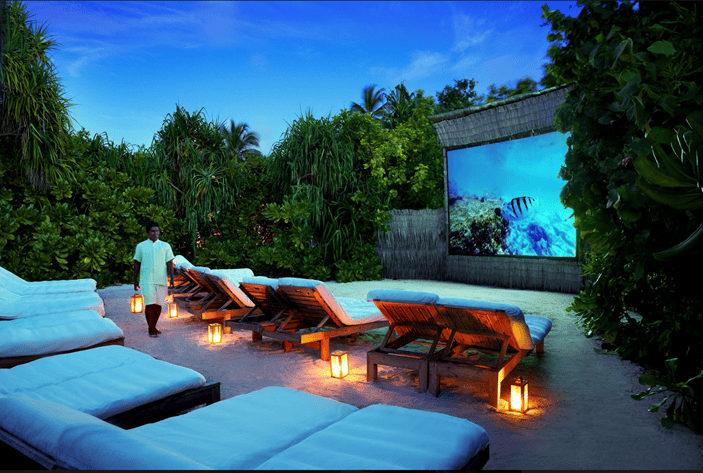
Things to Do in the Maldives at Night – 18 Activities to Try
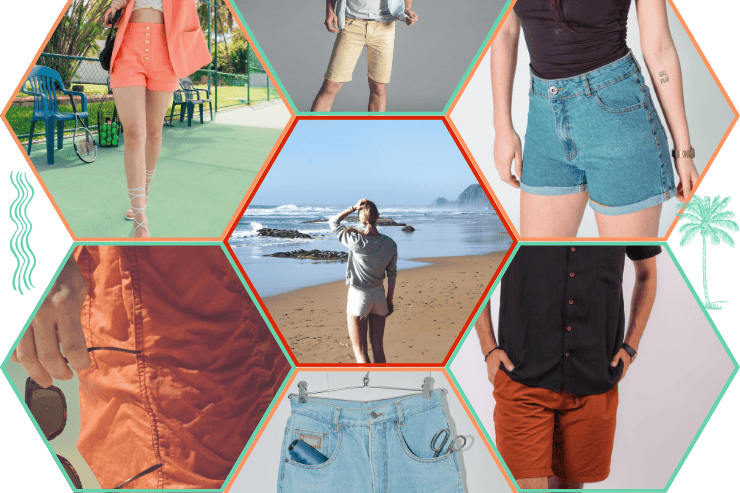
Maldives’ Dress Code: How to Stay Stylish and Respectful from Beachwear to Mosque Visits
The Maldives is unique in that it stands as one of the few nations globally with an almost entirely Islamic population. Its religion shapes much of the cultural and legal landscape of the country. Islamic principles influence daily life, from the call to prayer echoing across the islands five times a day to the observance of Ramadan, shaping the rhythms of daily activities.
This will also influence a bit your holiday, especially if you’re planning to go on a local island . There are a few mistakes you want to avoid and some rules you need to follow as a tourist (for example you cannot drink alcohol on local islands), and some of these come from the national religion of the country.
But knowing this shouldn’t affect your decision to visit. With a few exceptions, especially if you’re going to one of the resort islands , you won’t have to take anything into account during your visit. You’ll enjoy a gorgeous marine life, some amazing beaches and the laid-back lifestyle we all dream about. Being a traveler in the Maldives means you will experience the blend of serene island beauty and the deep-rooted spiritual tradition that the locals hold dear, making it an immersive cultural experience.
Are you overwhelmed by all the resort options? Discover your perfect island match below!
With this nifty tool, you’ll get from a list of 100+ resorts that look great and no idea where to start to a short list of islands that fit your wishes and desires. And yes, it also has the links for Booking and Agoda so you can book your stay straight away.
Check it out below !
Language – The language used is Dhivehi
Beyond the official language of Dhivehi, you’ll find that the Maldivians take pride in their unique linguistic heritage. This Indo-Aryan language is rich in history, borrowing elements from various languages, including Arabic, Hindi, English, and even old French. As you stroll through the bustling markets and serene atolls, you’ll notice the elegant Thaana script gracing signs and documents, giving you a glimpse into the distinct Maldivian culture.
For travelers, don’t worry, you don’t need to learn it, as most people speak English at least at conversational level. However, picking up a few Dhivehi phrases like “Assalaam ‘alaikum” (Hello) or “Shukuriyyaa” (Thank you) can go a long way in forging warm connections with the locals. And if you really find yourself in a pickle, don’t forget you can use Google Translate (unfortunately DeepL does not support Divehi), one of my top recommended free travel apps .

Streamline Your Travels with 45+ Free Apps!
Get the list of 45+ FREE travel apps to plan your next trips with ease.
Opt in to receive news and updates.
You have successfully joined our subscriber list. Your PDF is headed to you just … about … now!
The Maldivian Rufiyaa (MVR) stands out for its practicality and resilience. As you explore the islands, you’ll be pleasantly surprised to see that the Rufiyaa is uniquely crafted from polymer, a durable plastic material that can withstand the humid and wet conditions typical of the Maldives. This thoughtful design ensures that even with frequent exposure to water, whether you’re snorkeling or enjoying a day at the beach, your money remains intact and usable.
We were surprised initially because we have plastic money in Romania as well, but here, it makes much more sense! And because my husband managed to lose some money (he put it in his beach shorts that double as pants and then forgot and went for a swim) we were happy that at least whoever finds it, will be able to use it, as they’ll float to the surface and even be clean. This may be a tip to add on my list of keeping your valuables safe while traveling : don’t keep your money in your beachwear!
While the official currency is the Maldivian Rufiyaa, USD are widely accepted everywhere. The bills need to be new and in good condition, but they will be accepted virtually everywhere. If you’re going on a local island though, you might receive your change in Rufiyaa, and you cannot exchange it back to USD, so plan your expenses if you’re planning to do island hopping. If you’re going on resort islands, you can pay everything by card ( Revolut or Wise will both work just fine) but you can bring some small USD bills as well because you’ll want to tip everyone . Read more about what currency to bring to the Maldives in my dedicated blog post!
Is the Maldives a country?
Becoming an independent nation in 1965, the Maldives proudly stands as a sovereign country today. Once under British protection, the picturesque archipelago has since charted its unique path. Governed as a republic, it boasts a rich cultural heritage and an increasing tourism sector, which propels its economy. The capital city, Malé, serves as the political and economic hub, offering visitors a blend of modernity and tradition.

Do I need vaccinations for the Maldives? – Everything you need to know

Maldives’ Rules for Tourists – 40+ Laws & Customs You Need to Know
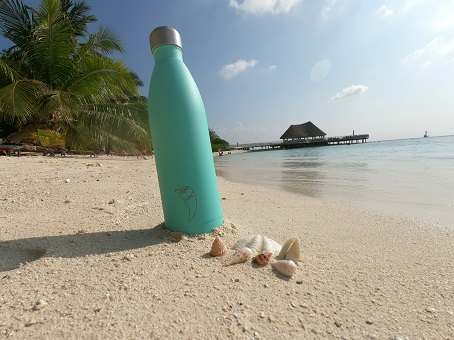
Can you take shells, sand, and dead coral from the Maldives?
Geographical facts about the maldives, it has around 1200 islands.
The Maldives boasts a staggering collection of around 1,200 islands, each carrying its own charm and beauty. These islands are scattered across 26 atolls, creating a unique landscape of tiny islets framed by the Indian Ocean’s turquoise waters. The majority of these islands remain untouched and uninhabited, offering pristine beaches and secluded getaways that appeal to both adventure seekers and those looking to unwind.
The geography of the Maldives is a true testament to the natural wonders of our planet, offering just one of the many reasons to visit it rather sooner than later. This, of course, poses also a challenge with the local transportation, as you cnanot really hop on a bus to get to an atoll hundreds of miles away. There are a few ways to travel between islands , and you can also use 12Go (from the widget below) to find the best option when planning your itinerary .
Fewer than 20% of the islands are inhabited
With fewer than a fifth of the islands being inhabited, the Maldives offers a unique blend of solitude and community. Out of the more than 1,200 islands, around 200 host local populations while approximately 80 are dedicated resorts, providing luxurious getaways.
This intriguing distribution allows for a remarkable experience where you can explore vibrant local culture on one island and retreat into serene, resort-style relaxation on another. The exclusivity of one resort per island enhances the sense of privacy and tranquility for visitors, making each stay uniquely enchanting.
It’s the smallest country in Asia with the smallest population
The Maldives is the smallest country in Asia by both land area and population. Covering just about 115 square miles (298 square km) and home to a population of around 540,000 people, it stands out for its compact size amidst the vastness of the Asian continent. Despite its small footprint, the country boasts a high population density, especially in Malé, the capital city, making it one of the most densely populated cities in the world.
Can You Wear Shorts in the Maldives? – Fashion Faux Pas or Island Essential?

How to plan a trip to the Maldives – Maldives Travel Planning
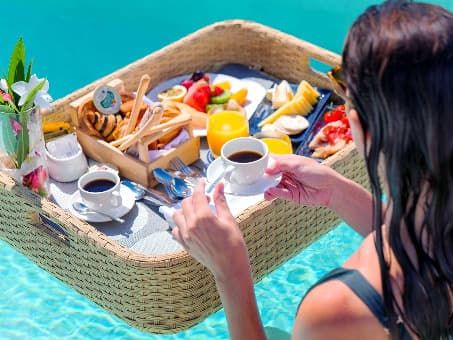
14 Unique Reasons to Visit the Maldives Beyond the Picture-Perfect Beaches
It’s the world’s lowest nation and the flattest.
Imagine an entire country with an average ground level of just 5 feet (1.5 meters) above sea level. That’s the Maldives, the flattest and lowest nation, making it uniquely vulnerable to the impacts of climate change. Rising sea levels threaten to submerge these beautiful islands, putting their existence at risk.
This precarious situation is exacerbated by coastal erosion, regularly ravaging the shoreline and diminishing their landmass. The shrinking landscape poses a grave concern, not only for residents but also for the rich biodiversity and stunning coral reefs that attract tourists from around the globe. Urgent international cooperation and innovative local measures are essential to preserve this tropical paradise.
The Maldives is slowly sinking
Due to its low elevation, the Maldives is one of the most vulnerable countries to the impacts of climate change, particularly rising sea levels. Predictions suggest that many of its islands could be submerged by the end of the century if current trends continue. The country’s government has been vocal on the international stage, advocating for significant global actions to combat climate change. This existential threat has prompted measures such as elevating infrastructure and investing in sustainable energy, but the situation remains dire, emphasizing the urgent need for global climate initiatives.
When we visited, we also noticed the increasingly bleached coral, another effect of climate change. While some of us might enjoy the almost bath-like temperature of the water, the delicate marine life does not, and it shows. The damaged coral is also a consequence of overtourism, so it is indeed in our power to help keep this paradise around and in pristine condition for more time.
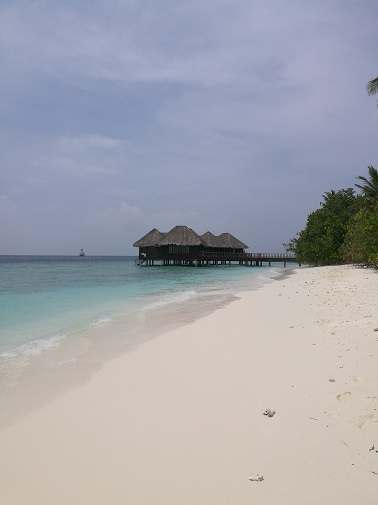
Worst Time to Visit The Maldives: A Traveler’s Guide
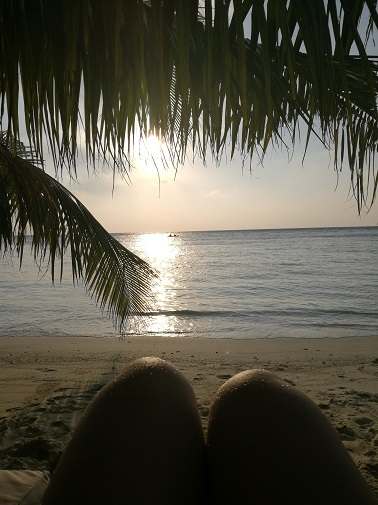
Top Things to Do in The Maldives: 40+ must do Activities to Try

Best Currency to Bring in the Maldives: A Complete Traveler’s Guide
Interesting facts, weekends are on friday and saturday.
In the Maldives, the weekends fall on Friday and Saturday, unlike the Saturday-Sunday weekends you might be used to. This unique arrangement is rooted in Islamic tradition, with Friday being a sacred day for prayer and rest.
As a visitor, it’s essential to plan your travel and activities accordingly, as you might find that some businesses and services operate on different schedules. Especially if you’re planning to go on local islands and use the public transportation, you might want to check out the schedules if you arrive during one of these days, as some activities might be unavailable.
But don’t worry—resort islands and tourist facilities are well-versed in accommodating international guests, ensuring your vacation remains smooth and enjoyable. On resort islands, you’ll feel there are really no days of the week, as everything goes on island time. All days are the same, so you can really have a mojito on a Thursday afternoon and not wonder where in the world is 5 o’clock.
It’s located right at the equator, making the sunshine even more dangerous
Being situated at the equator means that the Maldives experiences intense sun exposure throughout the year. This geographic positioning results in nearly 12 hours of daylight every day and higher UV levels compared to those in non-equatorial regions. Use reef-safe SPF to protect your skin and don’t forget to reapply often (every two hours!).
Whether you’re lounging on the beach, snorkeling in turquoise waters, or exploring the local culture, applying and reapplying sunscreen is crucial. Without adequate protection, you risk severe sunburn, skin damage, and long-term health issues. So, pack that sunscreen and a wide-brimmed hat , and enjoy your sun-soaked adventures responsibly! You can find out more items you need to add to your packing list on my dedicated post, or download the printable packing list below.
Hey friend!
Get your vacation mode ON with this FREE packing list for your Maldives trip.
Marketing Permissions
We will send you emails with awesome tips, discounts, and news from the travel industry. We will not spam you or share your email with anyone. You can unsubscribe at any time.
By clicking below to submit this form, you acknowledge that the information you provide will be processed in accordance with our Privacy Policy.
You have successfully joined our subscriber list.
It’s been a tourist destination for only 50 years
The Maldives opened its doors to tourism relatively recently, with its first resort launching in 1972. Over the past five decades, it has blossomed into a premier holiday destination. Starting with just two hotels, the archipelago now boasts over 100 exquisite resorts (and if you have trouble deciding between them, my free Maldives Island Picker is here to help).
The Maldives’ natural beauty, combined with luxurious accommodations and unique experiences, has captivated tourists worldwide. This rapid growth has positioned tourism as the bedrock of the Maldivian economy, employing thousands and drawing millions of visitors annually. The rise of ecotourism has even more travelers eyeing this tropical paradise, eager to explore its pristine environment. It also made it vulnerable to worldwide changes affecting the tourism industry (like the Covid-19 pandemic), something to keep in mind when choosing our destinations.
Its white sand beaches are extremely rare in the world
The stunning white sand beaches of the Maldives are not only extremely beautiful and comfortable for your feet but are also geologically unique. Unlike the typical beaches around the world, which are usually formed from quartz, Maldivian beaches are primarily made up of coral. This unique composition gives the sand its distinct, bright white color.
The coral sand results from the natural process involving parrotfish, which consume coral for the algae inside and then excrete the ground-up particles. So yes, we’re basically in love with feeling fish excrements on our bare feet. At the same time, this should make us aware that taking sand, shells or coral as a souvenir is a major no-no, as it takes a lot of time to be replenished.

What to Wear in the Maldives: Essential Packing Guide

Do You Need a Power Adapter for The Maldives? Essential Guide
Do you need a visa for the maldives essential travel guide, it has wet and dry season, even thought the temperature is constant all year.
The Maldives experiences a tropical monsoon climate, characterized by two distinct seasons: the dry season, which runs from November to April ( one of the best times to visit ), and the wet season ( one of the worst time of the year ), from May to October. Despite these seasonal changes, the temperature remains remarkably consistent, typically hovering between 77°F (25°C) and 88°F (31°C) throughout the year.
The wet season brings heavier rainfall, higher humidity, and the occasional storm, while the dry season offers clearer skies and calmer seas, but also bigger crowds and higher prices. These climatic conditions contribute to the lush, tropical environment and the vibrant marine life that the Maldives is famous for, and they will deeply shape your decisions when travel planning for your trip.
The coconut tree is the national tree
The coconut tree stands proudly as the national tree of the Maldives, symbolizing both life and sustenance for the Maldivian people. These versatile trees provide not only delicious coconuts but also essential materials used in everyday life, such as leaves for thatching roofs and trunks for building.
As you explore the lush island landscapes, you’ll notice coconut trees swaying gracefully in the breeze, a picturesque reminder of their importance in the local culture and economy. The coconut’s versatility is celebrated in Maldivian cuisine, crafts, and even traditional medicine, making it an integral part of the nation’s heritage.
It might sound funny, but statistics show that more people suffer annually from injuries made by falling coconuts than by shark attacks . OK, you can stop laughing now! I had the same reaction when I read this the first time, but think about it: coconut are quite heavy and with a wooden outside layer, and they fall from a high tree. I’m not saying it’s awful, I’m just saying it’s probably not fun, you know? And since you have limited access to healthcare while in the Maldives, one of the major safety arguments you should think about before you go, I thought it was worth mentioning it to you. Again, stop laughing!
Do you need water shoes in The Maldives? The Honest Answer to Your Question

Sharks in the Maldives: Your Ultimate Guide for Safe Encounters
Is water safe to drink in the maldives a comprehensive guide, the maldivian cuisine is based on three main ingredients: fish, coconut, and starches.
These ingredients are skillfully combined and served, sometimes fried, sometimes wrapped in home-made bread, apart from various curries one can taste as proof of the Indian heritage of the country. Whether enjoyed as a street food delicacy or a part of a traditional meal, the Maldivian cuisine offers an authentic taste of the area that reflects the rich maritime heritage and culinary traditions of the archipelago.
Some resort islands have a different time than the official one
While the Maldives officially follows Maldives Time (MVT), some resort islands operate on their own time zone called the Maldives Island Time that can be an hour or two ahead of MVT. This clever adaptation is designed to give visitors more daylight hours to enjoy their vacation activities. By effectively aligning the resort time with tourists’ natural rhythms, guests can savor extended sunshine, ensuring a more relaxed and enjoyable stay.

Bad Things About The Maldives – 34 surprising things no one tells you about
Are the maldives safe safety tips for your trip to the maldives.
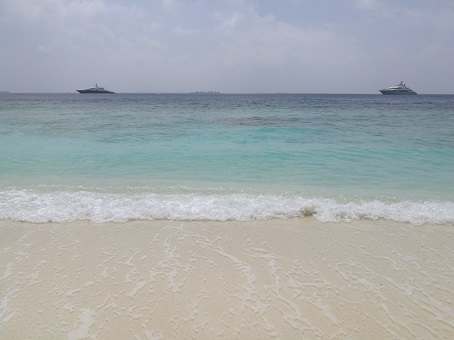
Is the Maldives Boring? A Clear Answer to Your Question
Alcohol is prohibited outside of resort islands.
When you visit the Maldives, you’ll find that alcohol consumption is strictly regulated. While you can enjoy a variety of alcoholic beverages on resort islands, thanks to special permits, it’s important to know that alcohol is prohibited in public places, including the capital city of Malé and other inhabited islands. This regulation is due to the country’s strong adherence to Islamic law, which governs many aspects of daily life. Therefore, outside of resort properties, you won’t find any bars or liquor stores, making it essential for visitors to act respectfully and adhere to local customs.
It has one of the most inclusive visa laws in the world
Getting into the Maldives is remarkably straightforward due to its inclusive visa policies . Visitors from almost any country can get a visa on arrival, which allows them to stay for up to 30 days. You’ll just need a valid passport, proof of accommodation, sufficient funds, and onward or return tickets.
This straightforward process has made the Maldives a highly accessible destination for travelers worldwide, contributing to its booming tourism industry. So, whether you’re planning a relaxing beach holiday or an adventurous diving trip, the Maldives welcomes you with open arms and an easy entry process.
It has a very high literacy rate
Education in the Maldives has seen remarkable progress, leading to extraordinarily high literacy rates, higher than 99% according to official sources . This achievement is particularly impressive given the geographic challenges of delivering education across numerous scattered islands. The emphasis on both Dhivehi and English in the education system has equipped over 90% of the population with proficiency in English, positioning the Maldives as one of the most literate nations in the world.

Mosquitoes in the Maldives – The good, the bad and the itchy

Best floating breakfast in the Maldives – 18 places to have breakfast in the pool
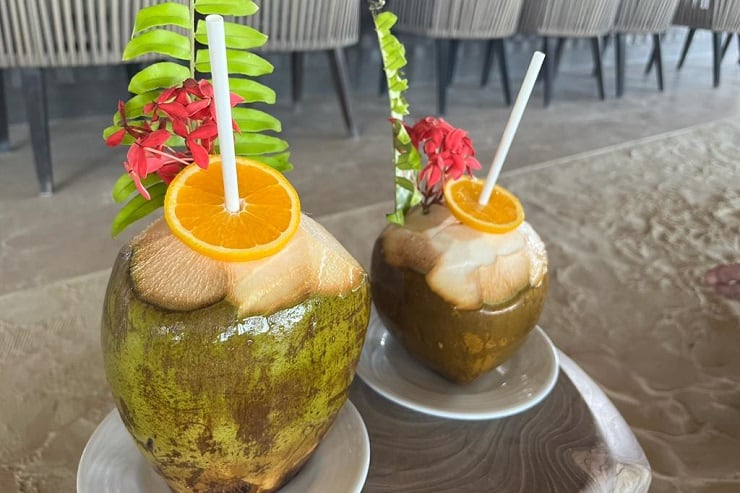
Alcohol in the Maldives: customs, rules, and availability of alcohol in the Maldives
Maldivian marine life facts, it hosts 3 unesco biosfere reserves.
These three UNESCO Biosphere Reserves are a testament to the incredible biodiversity found in the Maldives. Addu Atoll, Baa Atoll, and Fuvahmulah each offer unique habitats that support a wide range of marine life.
Baa Atoll is particularly famed for its seasonal gatherings of manta rays and whale sharks, in addition to its spectacular collection of coral reef. Fuvahmulah is a one-island atoll and it stands out with its diverse ecosystem, featuring both freshwater ponds and coral reefs and a few natural phenomena specific to only this place. Addu Atoll is the southernmost atoll, home to a rich variety of marine species and stunning coral formations, alongside a rich whale and dolphin fauna.
It’s one of the few places in the world where you can swim with huge marine life
Imagine being in the water, surrounded by colossal whale sharks and graceful manta rays—it’s an experience that the Maldives uniquely offers. These gentle giants glide through the crystal-clear waters, creating unforgettable underwater moments. Whether you’re an adventurous snorkeler or a seasoned diver, encountering these magnificent creatures up close is a truly magical experience that shouldn’t be missed. The Maldives’ commitment to marine conservation ensures that these species continue to thrive, making it a premier destination for wildlife enthusiasts.
Best Time of Year to Visit the Maldives: A Comprehensive Guide

Maldives water villas with slides – The best 8 villas with slides in the Maldives

The best local islands in the Maldives – 30 affordable alternatives to resorts
It has the biggest whale shark population in the world.
Swimming with whale sharks in the Maldives offers a surreal, once-in-a-lifetime experience. Known to have the highest concentration of these gentle giants, the Maldivian waters are a prime spot for observing them up close. The South Ari Atoll, in particular, is a renowned hotspot where whale sharks can be seen year-round.
Marine enthusiasts flock to the area, not only for the thrill of swimming alongside these massive creatures but also to partake in crucial conservation efforts. The experience is further enriched by the presence of certified guides and marine biologists who offer insights into the behaviors and habits of these fascinating fish.
It has five out of 7 sea turtle species in the world
In the vivid waters of the Maldives, you can find five out of the seven known sea turtle species gracing the oceans with their presence. These include the green sea turtle, hawksbill turtle, loggerhead turtle, olive ridley turtle, and leatherback turtle. The Maldives provides a crucial habitat for these majestic creatures, offering ample feeding grounds and nesting sites.
While exploring the Maldivian reefs, tread lightly and respectfully, as the preservation of these endangered turtles is vital to maintaining the ocean’s delicate ecosystem. Efforts are continuously made to protect these turtles, notably through the efforts of local conservation programs and the contributions of marine biologists stationed at many resorts. What you can do from your side is:
- Never touch them – they have a protective film meant to keep them bacteria-free, and touching them will damage this layer
- Allow them plenty of space to swim
- Wear reef-safe sunscreen or a water suit
We were lucky enough to see three turtles while visiting, one huge, about as big as me, and two smaller ones. While I have to say they were a great sight, we were also humbled by realizing they are so fragile and it’s our job to keep them safe as long as possible

Things to know before traveling to the Maldives – 24 things you need to know
How to travel between islands in the maldives – 5 ways to get around.

Cheap beach villas in the Maldives – 34 beach bungalows for your next trip
If you’re lucky enough, you might see bioluminescent plankton here.
Imagine a night-time swim where the ocean glows with a magical blue light. This isn’t a scene from a fairy tale but a unique experience you could have in the Maldives. Bioluminescent plankton, these tiny marine organisms, emit light when disturbed, creating a surreal, glowing effect in the water. This phenomenon often occurs in the Maldives, especially in certain places like Vaadhoo Island, offering a once-in-a-lifetime experience for visitors. So, if you’re lucky enough to witness this, it’s a marine spectacle you won’t forget!
It’s a great place to swim with sharks due to its diversity in shark species
The Maldives is a dream destination for shark enthusiasts! With its vibrant coral reefs and crystal-clear waters, it hosts an impressive variety of shark species. Whether you’re an experienced diver or a beginner, you can encounter a range of sharks , including the majestic whale shark, the graceful reef shark, and the elusive hammerhead.
Resorts often offer guided shark diving experiences, ensuring both awe-inspiring sightings and safety. So, grab your snorkeling gear or diving suit and get ready for an unforgettable underwater adventure, right in the heart of this natural paradise!

Mistakes to avoid in the Maldives – 24 do’s and don’ts when traveling to the Maldives
How to save money in the maldives – 23 tips to help you spend less, tipping in the maldives – tipping culture and correct etiquette to follow, fun facts about the maldives, a president once held an underwater cabinet meeting.
In a move that captured global attention, former President Mohamed Nasheed held an underwater cabinet meeting in 2009. The meeting took place at a depth of 6 meters (20 feet) beneath the surface, with ministers wearing diving gear. The purpose of this unconventional gathering was to highlight the pressing issue of climate change and its existential threat to the Maldives as a low-lying island nation. By conducting official business underwater, President Nasheed aimed to underscore the urgent need for international action to combat rising sea levels that could potentially engulf the island chain.
Shells were used as currency in the 1800s
Back in the 1800s, the Maldives had an unusual currency system compared to today’s standards. Cowrie shells, a small and shiny type of mollusk shell, were the primary form of money. As each piece is unique and can’t be replicated, it worked perfectly for a while.
The use of these shells facilitated trade not just locally, but even with visitors from neighboring regions. It’s an intriguing reminder of how communities creatively used available resources to establish economic systems long before modern currency came into being.

Glass floor water villas in the Maldives – 35+ gorgeous overwater bungalows
Cheap water villas with private pools in the maldives – 25+ affordable overwater bungalows to choose from, 10 days in the maldives – the perfect itinerary and must-do activities, the word “atoll” is actually coming from dhivehi.
When you think of the Maldives, the term “atoll” might frequently come up. This word is actually derived from Dhivehi, the local language of the Maldives, and has been adopted into English. It describes the geological formation where coral islands create a ring-like structure around a central lagoon.
These stunning natural formations are a hallmark of the Maldivian landscape, contributing significantly to its breathtaking beauty and allure for tourists worldwide. The unique structure of atolls not only offers picturesque vistas but also provides a habitat for diverse marine life, making the Maldives an unparalleled destination for snorkeling and diving enthusiasts.
The first underwater restaurant in the world is at Conrad Maldives
Imagine dining with stunning aquatic views all around you. This dream becomes reality at the Conrad Maldives Rangali Island . Here, the mesmerizing Ithaa Undersea Restaurant is set five meters below sea level.
It offers panoramic underwater views, offering a once-in-a-lifetime culinary experience where you can savor gourmet dishes while being surrounded by the vivid hues of the coral garden and various marine life. Dining at this exclusive venue feels like stepping into an enchanted underwater realm, making it a must-visit on your trip to the Maldives.

4 bedroom villas in the Maldives – all the 4+ bedroom villas to choose from
2 bedroom water villas in the maldives – 50+ overwater bungalows to dream of, 3 bedroom villas in the maldives – 25+ beach & water villas to choose from, first underwater hotel villa is also at conrad – the muraka.
The Muraka is a remarkable underwater hotel villa at Conrad Maldives , designed to offer an unparalleled luxury experience beneath the waves. This unique accommodation features a master bedroom submerged over 16 feet below sea level, encased in transparent acrylic, treating guests to 180-degree panoramic views of the vibrant marine life and coral gardens.
Complete with a private butler, an on-call chef, and an exclusive speedboat, The Muraka promises an extraordinary stay where serenity and extravagance seamlessly blend. If you’ve ever dreamed of sleeping with the fishes—in the best way possible—this villa invites you to an unforgettable underwater adventure.
Why is the Maldives considered a tropical paradise?
The Maldives is considered a tropical paradise due to its stunning natural beauty, including crystal-clear turquoise waters, white sandy beaches, and vibrant coral reefs full of amazing marine life. The unique concept of “one island, one resort” ensures unparalleled privacy and luxury, while the warm climate and abundant sunshine create an idyllic setting for relaxation and adventure.
How many islands make up the Maldives?
The Maldives is an archipelago consisting of 1,192 coral islands, scattered across about 90,000 square kilometers. Out of these, around 200 islands are inhabited by locals, while more than 130 are dedicated resort islands. Each island offers a unique slice of paradise, contributing to the nation’s reputation as a top tourist destination.
Are there any unique wildlife species in the Maldives?
Yes, the Maldives is home to several unique wildlife species, including the Maldives anemonefish, the Maldives blue-banded surgeonfish, and the Maldives sand perch. Additionally, the islands host rare bird species like the white tern and the Maldivian pond heron. These vibrant ecosystems thrive due to the diverse marine and terrestrial habitats available.
What are the traditional foods of the Maldives?
Traditional Maldivian cuisine is a delightful mix of flavors with dominant ingredients like coconut, fish, and starches. Alongside gulha , other iconic dishes include mas huni (a breakfast dish of tuna, coconut, onions, and chili), fihunu mas (grilled fish marinated with chili), and rihaakuru , a thick, brown fish paste. Maldivian curries, such as mas riha , are rich and aromatic, highlighting local spices. Fresh seafood and tropical fruits round out the Maldivian culinary experience, offering visitors an authentic taste of island life.
How has climate change affected the Maldives?
Climate change poses severe threats to the Maldives, including rising sea levels, coastal erosion, and increased storm frequency. The economy is heavily impacted, particularly the tourism sector, which faces damage from violent storms and coral reef degradation. The nation is implementing sustainability practices and investing in eco-friendly energy solutions to combat these challenges.
What makes the Maldives a popular tourist destination?
The Maldives is a popular tourist destination due to its stunning, clear waters, vibrant coral reefs, and luxurious resorts that provide an exclusive, private island experience. Its unique one-island-one-resort concept offers ultimate relaxation and privacy. Additionally, it’s a top destination for recreational diving and water sports, thanks to its rich marine biodiversity and breathtaking underwater scenery. Consistent tropical weather and beautiful white sand beaches further enhance its appeal, making it a dream destination for travelers worldwide.
What are the main languages spoken in the Maldives?
Dhivehi, also known as Maldivian, is the official language of the Maldives. It features its own unique script called Thaana. While Dhivehi is widely spoken throughout the islands, English is also commonly used, particularly in the tourism industry, making communication easier for visitors. Additionally, due to the country’s historical and trade connections, you might encounter Arabic, Hindi, and other South Asian languages.
How does the Maldives’ underwater ecosystem stand out?
The Maldives’ underwater ecosystem is unparalleled due to its vibrant coral reefs, hosting a diverse range of marine life such as manta rays, whale sharks, and five of the world’s seven sea turtle species. Additionally, its clear waters provide exceptional visibility, making it a diver’s paradise. UNESCO Biosphere Reserves like Baa Atoll protect these unique habitats, while many resorts employ marine biologists to sustain reef health, maintaining the delicate balance of this stunning underwater world.
What are some fun facts about the Maldives’ geography?
The Maldives is unique for its geographical structure, being made out of around 1200 islands, out of which around only 20% are inhabited. It’s also the smallest country in Asia with the smallest population, in addition to being the lowest country in the world, with its higher point at around 5 feet (1.5 meters).
What is the history of tourism in the Maldives?
Tourism in the Maldives began in 1972 with the opening of its first resorts. From these humble beginnings, the industry has flourished, with over 130 luxurious resorts now spread across various atolls. Transformation has been rapid and profound, making tourism the largest economic sector. The Maldives now attracts millions of visitors annually, offering diverse accommodations including resorts, hotels, guesthouses, and safari vessels.
How do the Maldives’ local customs differ from other countries?
The Maldives’ local customs are deeply rooted in Islamic traditions. Unlike many countries, weekends are observed on Friday and Saturday, aligning with the Islamic holy day. Alcohol is prohibited outside resort islands, and modest dress is expected in non-resort areas. Additionally, daily life and business hours often revolve around prayer times, creating a unique rhythm distinct from Western norms.
What are some lesser-known facts about the Maldives’ culture?
Did you know traditional Bodu Beru drumming is an essential part of Maldivian culture? Local crafts like mat weaving and lacquer work also hold cultural significance. The Maldives also has hosted the first underwater cabinet meeting in the world.
What is the best time to visit the Maldives?
The best time to visit the Maldives is from December to April. This period is characterized by dry weather, calm seas, and plenty of sunshine, making it ideal for beach activities and underwater adventures. Keep in mind that this is also the peak tourist season, so book early to secure your accommodations and activities.
Yes, the Maldives is home to unique wildlife species such as the Maldivian Clownfish, and the Maldivian Anemonefish. Additionally, the country supports a rich marine biodiversity including over 2000 species of fish, 187 species of coral, and various species of whale and dolphin, making it an exceptional destination for nature enthusiasts.
The Takeaway
The Maldives, with its pristine white sand beaches, crystal-clear waters, and diverse marine life, offers an unparalleled tropical experience. Though rich in natural beauty and cultural heritage, this island nation is also marked by unique challenges such as climate change impacts, underscoring the need for responsible tourism.
Whether you’re drawn by its luxurious resorts, adventurous diving opportunities, or just seeking a serene escape, the Maldives presents an unforgettable destination. As you plan your visit, keep in mind the cultural nuances and ecological significance, ensuring your journey benefits both you and the local community. And if you’re looking for more information about this awesome destination, check out my other blog posts below!
Adults-only resorts in the Maldives – 13 paradise islands for your child-free holiday

The ultimate Maldives packing list – What to pack for the Maldives (PDF included)
Affordable water villas in the maldives – 30 cheap overwater bungalows that will blow your mind, the maldives, 1 thought on “30+ facts about the maldives: fun, unique, and interesting facts you didn’t know”.
- Pingback: Can You Wear Shorts in the Maldives? - Fashion Faux Pas or Island Essential?
Leave a Comment Cancel reply
Save my name, email, and website in this browser for the next time I comment.
Want to meet other travelers like you? Join my Facebook group, Maldives Travel Planning , a community of independent travelers to the Maldives like yourself. No travel agents, no spam and private messages. Just DIY travelers and good vibes.
Join maldives travel planning now.

- 3 Other destinations
- 4.1 History
- 4.2 Economy
- 4.3 Culture
- 4.4 Climate
- 4.6 Visitor information
- 6.1 Entry requirements
- 6.2 By plane
- 6.3 By boat
- 7.1 By plane
- 7.2 By boat
- 9.1 Diving and snorkelling
- 9.2 Surfing
- 10.2 Tipping
- 11.1 Maldivian cuisine
- 13.1 Resorts
- 13.2 Guesthouses
- 13.3 Village homestays
- 16 Stay safe
- 17 Stay healthy
- 19.1 Emergency services
The Maldives ( Dhivehi : ދިވެހިރާއްޖެ Dhivehi Raajje ) are an archipelago in the Indian Ocean with picture-perfect beaches, strikingly blue water, and luxury resorts. There are 200 inhabited islands and 154 islands with tourist resorts. Just under the surface of the beautiful blue ocean, there's a wealth of wildlife to see: over 2000 species of fish in all colours of the rainbow roam the clear waters around the islands.
The Maldives are an archipelago of 1,192 coral islands formed of 26 atolls, or atholhu in Dhivehi — the source of the English word. These are not single islands, but giant ringlike coral formations hundreds of kilometres wide that have fragmented into countless islands.
Atoll naming is complex, as the atolls have both lengthy traditional Dhivehi names like Maalhosmadulu Dhekunuburi , and snappy code names like Baa that refers to administrative regions and may consist of more than one geographical atoll. The code names are the letters of Dhivehi alphabet, but being easier for non-Maldivians to remember and pronounce, the code names are popular in the travel industry and are hence also used here. Of the 21 administrative atoll groups, only (parts of) 10 are open to tourism, and from north to south these are:

The other atolls are Gaafu Alifu, Gaafu Dhaalu, Gnaviyani, Haa Alifu, Noonu, Haa Dhaalu, Laamu, Njyavinani, Shaviyani and Thaa.
- 4.175 73.508333 1 Malé — the capital and by far the largest city, crammed onto a small island and by some measures the world's densest city
Other destinations
- 5.333889 73.463889 1 Kuredu — one of the inhabited islands of Lhaviyani Atoll
- 4.190278 72.747222 2 Mathiveri — island belonging to North Ari Atoll
- 4.262778 72.991389 3 Rasdhoo — smallish inhabited island and the capital of the North Ari Atoll
- 4.436192 72.956261 4 Thoddoo — an isolated inhabited island that administratively belongs to North Ari Atoll . It's also the largest producer of watermelon in Maldives.
- 4.21389 72.8644 5 Ukulhas — smallish 1 km long island of Alif Alif Atoll
The heritage of the Maldives is told in legends, in records of old copperplates, coral-carved ancient scripts and echoes of traditional culture. The story tallies in known South Asian history with mentions of the great Mauryan ruler Emperor Ashoka.
After being a Sultanate under Dutch and British protection, the Maldives gained independence from the British in 1965 and became a republic in 1968. Maumoon Abdul Gayoom ruled over the country with an iron fist and did not hesitate to jail dissidents. He was re-elected five times in more or less rigged elections. Resistance to his rule culminated in violent rioting in 2003 and 2004. Much to everybody's surprise, free and fair elections were held in 2008, and Maumoon conceded defeat to opposition leader Mohamed Nasheed, "Anni". By December 2011, though, the tables had turned. Most of Nasheed's allies had left his government and there were increasingly large anti-government protests. Nasheed resigned in 2012 under murky circumstances and then lost a controversial 2013 election to Maumoon's half-brother Abdulla Yameen, whose administration has cracked down on political freedom and imprisoned opposition figures. During his rule, Yameen withdrew the Maldives from the Commonwealth, and pivoted his foreign policy away from Maldives' traditional ally, India, to align more closely with China in exchange for Chinese investments.
In the 2018 election, Yameen was defeated by opposition candidate Ibrahim Mohamed Solih. Despite fears that he would refuse to step down, Yameen publicly conceded the election shortly after, and handed power peacefully to his successor on 17th November 2018. Under Solih, the Maldives re-joined the Commonwealth in 2020, and has largely pivoted Maldives' policy back to India, though it has continued to maintain cordial ties with China.

The tsunami of 26 December 2004 caused extensive damage to the Maldives - of a population of only 290,000, over a third was directly affected by the tsunami and more than 15,000 people were left homeless. The economic damage alone was over 62% of the GDP or US$470 million. The immediate response from international donors and agencies mobilized more than US$400 million in aid after the disaster, much of which was used to help misplaced persons rebuild their homes and infrastructure damaged by the waves.
Tourism, Maldives largest industry, accounts for 28% of GDP and more than 60% of the Maldives' foreign exchange receipts. Over 90% of government tax revenue comes from import duties and tourism-related taxes. Over 1.7 million tourists visited the islands in 2019. Fishing is the second leading sector. The Maldivian government began an economic reform program in 1989 by lifting import quotas and opening some exports to the private sector. Subsequently, it has liberalized regulations to allow more foreign investment. Agriculture and manufacturing continue to play a minor role in the economy, constrained by the limited availability of cultivable land and the shortage of domestic labour. Most staple foods must be imported. Industry, which consists mainly of shipping, boat building and handicrafts, accounts for about 18% of GDP. Maldivian authorities worry about the impact of erosion and global warming on their low-lying country; 80% of the area is one metre or less above sea level.
Maldivians are entirely Sunni Muslim, and the local culture is a mixture of Sinhalese, South Indian and Arab influences. While alcohol, pork, dogs and public observance of non-Muslim religions are banned on the inhabited islands, the resorts are allowed to exist in a bubble where almost anything goes.
Note that the weekend in the Maldives runs from Friday to Saturday, during which banks, government offices and many shops are closed. You won't notice this at the resorts though, except that lunch hours may be shifted for Friday prayers.

The Maldives are tropical, with plenty of sunshine and temperatures around 26.4°C (79.52°F) to 31.5°C (88.7°F) throughout the year. However, rainfall increases considerably during the April-October southwest monsoon, particularly from June to November.
- The Maldives: Islamic Republic, Tropical Autocracy by J. J. Robinson, a journalist who lived in the Maldives through some of its 21st-century political turmoil. In addition to an interesting look at what life is like for foreigners in Malé and for staff behind the scenes at the resorts, the book gives a detailed and surprisingly readable account of the complex political crises that the country experienced between 2008 and 2015.
Visitor information
- Visit Maldives website
Maldivian ( Dhivehi ), a close relative of Sinhala (spoken in Sri Lanka) but with borrowings from Urdu, Hindi, Arabic and many other languages, is the official and national language. It is written in a remarkable hybrid script called Thaana , which uses Arabic and Indic numbers as the base of the alphabet, written from right to left with Arabic vowel signs. The script is thought to have originated as a secret code for writing magical formulas so that outsiders can't read them, which would also explain why the ordering of the alphabet is, as far as linguists can tell, random.
English is widely spoken, particularly by government officials and those working in the tourism industry. English is also the language of instruction in schools. "House reef" describes a coral reef accessible from the beach or jetty, thus you may hear discussions about whether an island has a good house reef or not.
Since the Maldives are a popular destination for German and Italian holidaymakers, a sizeable number of local resort workers speak German and Italian. This may vary depending between resorts.
Entry requirements
The Maldives have a remarkably easy visa policy: Everybody gets a free 30-day visa on arrival, provided that they have a passport valid for a minimum period of 1 month from the date of entry, a return journey confirmed ticket and entry requirements to the onward destinations, a prepaid confirmed hotel booking at a registered hotel or proof of financial means for sufficient funds to support the stay in Maldives (US$100 + $50 per day). See the Maldives Immigration website [dead link] for details.
Traveller Declaration must be filled in and submitted by all travelers travelling to and from Maldives, within 96 hours to the flight time. The form has to be submitted electronically via IMUGA [dead link] .
Importing explosives, weapons, firearms, ammunition, pornographic material, materials deemed contrary to Islam including ‘idols for worship’ and bibles, pork and pork products, and alcohol into the Maldives is forbidden and all luggage is X-rayed on arrival. Exporting sand, seashells or coral is forbidden. All dogs are banned from the Maldives. See the Maldives Customs Service website [dead link] for details.
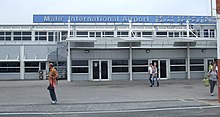
Practically all visitors arrive at Velana International Airport [dead link] ( MLE IATA ), on Hulhulé Island next to the capital city Malé . The airport is served by a wide array of flights from China , India , Sri Lanka , Dubai , major airports in South-East Asia , and charters from Europe. Many flights stop in Colombo (Sri Lanka) on the way.
If you want to get an amazing aerial view of the islands, try to get a seat on the left side of the flight.
British Airways flies directly from London Gatwick to Malé during the winter (October to March). No direct flights operate from London Heathrow, however, it is possible to get an indirect flight via India or the UAE for example. Singapore Airlines flies daily direct from Singapore to Malé, with late night timings.
Gan Airport ( GAN IATA ), on the southern atoll of Addu , serves a few international flights.
Departure taxes are included in your ticket.
There are no regular passenger boats to the Maldives. Even yachts usually steer clear, as navigating around the reefs is hazardous and permits are expensive. Dogs are banned from the Maldives. Even if they remain on your boat the authorities can be extremely sketchy about this compromise, and this can put the life of your dog at risk, should the officials you are dealing with not be sympathetic to your situation. Be sensible and do not bring them into any Maldivian port.

There are four main ways of getting around in the Maldives: domestic flight , boat , seaplane and private yacht (liveaboard). The boats are the Maldivian equivalent of a car, while seaplanes and private yachts (liveaboards) are mainly reserved for tourists.
Seaplanes prefer not to operate at night, so if you arrive at the airport after dark and are going to a distant resort, you may have to spend the night in Malé , Hulhumalé or at the airport hotel in Hulhulé . Private transfers, though expensive can be opted for resort transfers, instead of spending the whole night at Malé City. Private transfers could cost US$500-800. On the way back, there may also be a significant gap between the time your transfer arrives and your flight departure. Check with your resort or travel agent.
No point in the Maldives is more than 90 minutes away by plane from Malé , and visitors to the more far-flung resorts use air taxi services. There are four main operators: Manta Air , Flyme operates scheduled flights from Malé to Maamigili, Dharavandhoo and Hanimaadhoo, Trans Maldivian Airways which flies DHC-6 Twin Otter seaplanes that take around 15 passengers. The company schedules most planes at 6PM the previous day. Delays are frequent, it is not rare to wait for 5 hours in the TMA lounge. Seaplane scheduled in the evening has a high risk of being cancelled as delays add up and the sky becomes darker, in such cases TMA will make you take a combination of domestic flight and boat, potentially making you reach your destination well after dinner time.
Scheduled inter-island services are provided by Maldivian , which flies from Malé to Gan , Maafaru, Thimarafushi, Dharavandhoo, Funadhoo, Fuvahmulah, Hanimaadhoo, Ifuru, Kaadedhdhoo, Kadhdhoo, kooddoo, Kudahuvadhoo, Maavarulu, Faresmathoda, Hoarafushi, Madivaru and Kulhudhuffushi. Travel permits are no longer required.
The taxi boats generally take tourists to and from the islands in the North and South Malé atolls. They come in all different shapes and sizes depending on the quality of the resort you stay, and the Four Seasons has a large enclosed motor cruiser with drinks and food, while the lesser resorts have open-sided dhoni fishing boats.
Public dhoni ferries and cargo boats are available for more the independent-minded and budget-conscious. The main operator is MTCC , who list schedules and fares on their website.
The previous system of requiring written invitations and Inter Atoll Travelling Permits (IATP) for those wishing to visit other islands has been abolished; you're now free to travel wherever you wish. IATPs are still required if you wish to dock your own yacht, see Customs for details.
There are a number of bus routes around the capital including those which connects with the airport. They are run by RTL .

Most visitors come to enjoy the countless plush resorts, excellent beaches and stunningly colourful underwater life . Due to the isolated position of the island, the number of animals on land is limited, but the ocean has a wealth of wildlife. You will likely see plenty of anemones, different kinds of rays, octopus, squid and even giant clams. Whales, dolphins and turtles are spotted often. The Baa Atoll , named a UNESCO World Biosphere Reserve in 2011 and one of the richest coral reefs in the world is becoming the main tourist draw while also becoming an example of sustainable tourism in a protected area. In short; snorkelling or diving is an absolute must, see the Do-section below for more information.
The gorgeous and ubiquitous white sand beaches are a sight by themselves, especially with the tropical island setting they are in. A flight to one of the many resort islands gives spectacular aerial views of these picture-perfect islets, defined by rims of white sand and wide strokes of cobalt blue water.
Yet, if you can pull yourself away from your luxury holiday spot, the capital city Malé might be an interesting diversion. The bustling financial and political centre of the country has a few sights. Try the National Museum for a touch of history. While the building may not look too promising, the museum's fine collection includes beautiful Arabic and Thaana engraved woodworks, religious pieces, weaponry and other historic artefacts. The town also has a number of worthwhile mosques. The 17th-century Old Friday Mosque is the oldest one in the country, and officials are often willing to let polite and properly dressed visitors in. The Grand Friday Mosque & Islamic Centre is its 1984 modern counterpart, and dominates the city's skyline. While simple in design, the large, white marble structure and the shining gold dome is an attractive sight.
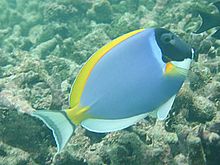
Diving and snorkelling
Aside from making the water bungalow rock on your honeymoon, the primary activity on the Maldives is scuba diving . The atolls are all coral reefs hundreds of kilometres away from any major landmass, meaning that water clarity is excellent and underwater life is abundant. Manta rays, sharks, even a few wrecks, you name it, you can find it in the Maldives.
While diving is very good by world standards even in the immediate vicinity of Malé, visibility and the chance of encountering large pelagic fish increases as you head to the outer atolls. Many divers opt for live-aboards, which can work out much cheaper than paying high resort fees. Currents vary considerably, with generally little inside the atolls but some powerful streams to be found on the sides facing the open sea. Water in the Maldives is warm throughout the year and a 3 mm shorty or Lycra dive skin is sufficient. Diving is possible throughout the year, but rain, wind and waves are most common during the season of the southwest monsoon (June-November). The best time for scuba diving is from January to April when the sea is calm, the sun is shining and the visibility can reach 30 m. There are decompression chambers on Bandos in Kaafu (15 min from Malé), Kuredu in Lhaviyani Atoll and at Kuramathi on Alifu .
The one downside to diving in the Maldives is that it's quite expensive by Asian standards. Prices vary considerably from resort to resort, with specialist dive resorts offering better prices. In general, a single boat dive with your own gear cost around US$50, and US$75 without. Beware of surcharges: you may be charged extra for boat use, guided dives, larger tanks, etc. On the upside, safety standards are usually very high, with well-maintained gear and strict adherence to protocol (check dives, maximum depth, computer use, etc.) being the rule rather than the exception.
Hanifaru Bay is a protected biosphere by UNESCO and is famous for some of the largest congregations of manta rays on the planet.
The Maldives is becoming an increasingly popular surfing destination. Turquoise water and perfect waves make it an ideal and uncrowded destination for surfers looking for smooth surfing conditions.

The best period for surfing in the Maldives is between March and October; the biggest waves occurring in June, July and August. This paradise is exposed to the same swells as Indonesia is, except that its higher latitude and its South-East exposure offers cooler and less hardcore surfing.
The O’Neil Deep Blue Contests held in the Maldives have placed Maldives firmly on the world’s surf map. While most of the recognized surf breaks are in Malé Atoll, there is certainly more to be discovered.
Specialized companies organize tailored multi-day boat trips in the region, allowing surfers to move easily from one point to another and maximizing the surfing time.
The local currency is the Maldivian rufiyaa , denoted by the symbol " Rf " or "MRF" (ISO code: MVR ). It is divided into 100 laari. However by law, resorts price services in US dollars and require payment in hard currency (or credit card), so there's no need to change money if you're going to spend all your time at the resorts. Most hotels have a shop but this is limited to diving and holiday essentials (sun cream, sarongs, disposable cameras, etc.) Some excursions from resorts will take you to local islands where there are handicraft type things to buy, but they are typically made outside the Maldives and sold at significant markups.
Coins come in denominations of 1, 2, 5, 10, 25 and 50 laari, 1 and 2 rufiyaa. Banknotes come in denominations of 5, 10, 20, 50, 100, 500 and 1,000 rufiyaa. The current series of rufiyaa banknotes is printed entirely on polymer.
If you are heading to Malé City or the other inhabited atolls, exchanging some rufiyaa will come in handy. The coins, in particular, are quite attractive and make an interesting souvenir in themselves, but the smaller denominations are rarely used or seen. The rufiyaa is tied to the US dollar within a 20% band but is practically 15:1. US dollars are near-universally accepted: shops usually exchange them at 15:1 or 10:1.
Maldivian rufiyaa can be changed at Bank of Maldives in the arrival area of airport. If you want to change rufiyaa back to your currency before departure, you need to keep the receipt. After check in, at Bank of Maldives in the departure area of airport, you can change rufiyaa back to the currency you previously changed to rufiyaa, not exceeding the amount listed on the receipt. The Bank of Maldives may not have small notes of your original currency though.
Tipping is not compulsory in the Maldives as a 10% service charge is added to everything, although it is not certain that the money is passed on to the staff.
Over the years the tipping culture has changed in the Maldives, mainly due to overseas visitors giving varying amounts of cash as tips.
Maldives is expensive for those who have comfort and service-oriented tourism in mind. Resorts have a monopoly on services for their guests and charge accordingly: for mid-range resorts, US$1000 per week per couple is a conservative budget for meals, drinks and excursions, in addition to the cost of flights and accommodation. Practically anything, including hotel rooms if booked locally, has a 10% "service charge" added, but tips are expected on top.
For an adventurous traveller who has time, Maldives can be a very affordable and rewarding experience, with prices comparable to Malaysia. A number of inhabited islands have guesthouses with typical prices €25-40 per room. On more remote islands, renting rooms in villages is possible at even less. Food is inexpensive, and fish curries are delicious. Public ferries will transfer you between different islands of the same atoll for a few US dollars (though for less obvious locations, there will typically be 1 ferry per day and no ferries on Fridays). For transfers to remote atolls, one can negotiate with cargo boats, which would often take people for €14-38, depending on the destination. Cargo boats do not have schedules and depart when loaded. One may expect 1 boat in 1-3 days for each atoll.
It is important to have in mind that staying on inhabited islands implies respecting the strict Muslim norms including no alcohol, modest dress, reserved behaviour. However, the locals are very welcoming and the experience may be much deeper and more rewarding than staying in resorts.
All the resorts are self-contained so they have at least one restaurant, which generally serves the type of cuisine expected by their guests (i.e. modern European or generic Asian). Breakfast is almost always included, and most resorts offer the option of half-board , which means you get a dinner buffet, and full board , which means you get a lunch and dinner buffet. These can limit the damage compared to ordering a la carte, but your options are typically very limited and drinks are often not covered, not necessarily even water. If you're planning on drinking a lot, it may be worthwhile to go all inclusive , but even this typically restricts you to house drinks.
The only other place to find food is Malé City . This comes in two forms. Either small restaurants aimed at the tourists (of which there are a couple of nice Thai restaurants), which are often expensive, or small cafes called hotaa , selling local Maldivian food at prices as low as Rf20 (US$6) for a complete meal.
Maldivian cuisine

Maldivian food revolves largely around fish ( mas ), in particular tuna ( kandu mas ), and draws heavily from South Indian tradition, especially Kerala . Dishes are often hot, spicy and flavoured with coconut, but use very few vegetables. A traditional meal consists of rice, a clear fish broth called garudhiya and side dishes of lime, chilli and onions. Curries known as riha are also popular and the rice is often supplemented with roshi , unleavened bread akin to Indian roti , and paaparu , the Maldivian version of crispy Indian poppadums. Some other common dishes include:
- mas huni — shredded smoked fish with grated coconuts and onions, the most common Maldivian breakfast (eat it as is or wrap it in roshi )
- fihunu mas — barbequed fish basted with chili
- bambukeylu hiti — breadfruit curry
Snacks called hedhikaa , almost invariably fish-based and deep-fried, can be found in any Maldivian restaurant.
- bajiya — pastry stuffed with fish, coconut and onions
- gulha — pastry balls stuffed with smoked fish
- keemia — deep-fried fish rolls
- kulhi borkibaa — spicy fish cake
- masroshi — mas huni wrapped in roshi bread and baked
- theluli mas — fried fish with chilli and garlic
As the Maldives are Muslim, alcohol is banned from the local population. However, nearly all resorts, live-aboard boats and the Hulhulé Island Hotel (on the same island as the airport) are licensed to serve it, usually with a steep markup.
Tap water in resorts may or may not be drinkable: check with the management. Bottled water is extortionately priced, with US$5/bottle being typical.
The Maldives had a longstanding policy of keeping tourists on dedicated islands, which meant they could only stay in full-service resorts where the cost of a night's accommodation started around US$200 and went up into the stratosphere, and the vast majority of visitors continue to opt for these. However, from 2008 all the islands were opened to tourism, and backpacker-friendly guesthouses starting from US$30 a night opened on inhabited islands across the archipelago.
Most resorts take up their own island (1500 x 1500m to 250 x 250m), meaning that the ratio of beach to guests must be one of the best in the world and it is hard to imagine that you would ever have to struggle to find your own private piece of beach to relax on. Many have a "no shoes" policy and with such soft sands, it is easy to love this idea.
The range and themes or the resorts are impressive, and most people will find one they like. They can be grouped into three types:
- Dive resorts , designed primarily for divers. Geared expressly for people who want to spend most of their time underwater, facilities on land are limited, but the house reef is usually excellent. Often found in the more far-flung parts of the archipelago.
- Holiday resorts , designed primarily for families. These are large and have a full complement of facilities (several restaurants, day-care centres, etc.), but don't have the over-the-top luxury and have less privacy. Most of these are located on Kaafu , with easy access from Malé City.
- Luxury resorts , designed primarily for honeymooners and the jet set. The place to be if you want designer furniture, gourmet food and a plasma TV in an overwater villa reachable only by rowboat, and are willing to pay high prices for the privilege.
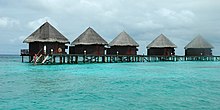
A Maldivian classic is the overwater bungalow , built on stilts directly above a lagoon. While these look fabulous and sound appealing, they have their downsides:
- They're usually packed tightly together, often sharing a wall, meaning little privacy.
- Especially at low tide, the water level may be too low to allow swimming or snorkelling.
- Resort facilities may be a fair distance from the bungalows.
- The lapping of waves is romantic enough on a calm day but can make it next to impossible to sleep if a storm blows through.
These factors vary from resort to resort, so research carefully. A good one is definitely worth trying at least once, but many Maldives repeaters prefer a bungalow with a private beach .
When considering where to go, factor in transport time and costs from the airport: the more far-flung resorts generally require an expensive seaplane transfer and you may have to stay overnight at the airport on the way. On the upside, the further away you are from Malé, the more peaceful the islands and the better the diving.
Many resorts, especially the smaller dive-oriented ones, cater largely to a single nationality, leading to "Italian" resorts, "Dutch" resorts, "German" resorts, etc. While almost all welcome any nationality and have some English-speaking staff on hand, you may be cut off from any evening entertainment and have problems e.g. diving if you don't speak the local lingo.
Guesthouses
There are guesthouses on inhabited islands, and Maafushi island is popular with looking for hassle-free accommodation of this type. Low-end prices are €25-35 per night.
Examples include: Equator Village on Addu Atoll, a former British Royal Air Force base converted to a 78-room hotel. The cost is around US$100-150 per person per day all-inclusive (including some alcohol). Another unique location is Keyodhoo Guest House, this guest house is on top of a recreation centre built by an Australian after the tsunami (US$20 pp/per night). Most visitors are scuba divers or adventure travellers. Other Inns/B&B can also be found on Vaavu Atoll, Dhaalu Atoll, Kaafu Atoll, North/South Malé Atoll and Ari Atoll Hangnaameedhoo. Only a few of these inns and B&Bs have their own pool. Confirm if bikinis are allowed on the beach. The distance between the inns and beaches are usually short, but visitors should still dress appropriately to Maldive customs.
Village homestays
More independent-minded travellers and those looking for cultural experience may consider renting rooms in villages. This will require either walking through the village and asking around if you're particularly confident of your social skills or inquiring in Malé City whether someone can put you in contact with their friends or relatives on a remote island for such an informal homestay. Prices can be as low as €15 per night for a clean functional room.
The first university in Maldives (Maldives National University) was inaugurated on 15 February 2011. Operated under the aegis of the Department of Higher Education and Training, MCHE and the Islamic University of Maldives are the only free public degree-granting institutions on the island. The college offers a range of degrees, diplomas, and certificates, with particular emphasis on engineering, health science, education, tourism, and management. The average enrolment at MCHE is around 4,000 students in long-term (that is, more than one academic year) programs and around 2,000 in short-term (shorter than one academic year) courses. State-owned institutions such as Maldives Polytechnic and TVET Maldives offers free technical and vocational training to help develop skills for employment. Several private institutions offer internationally recognised undergraduate and postgraduate courses.
Getting a job in the Maldives can be tricky. It is not the kind of place where you can just turn up and start job hunting. Generally, the resorts take on a mix of local and international staff so you need to approach the resort Human Resources departments. There is a good mix of jobs but a lot of the roles are diving based (divemasters, instructors, photographers, etc.)
Most resorts are predominately one or two nationalities so finding the resorts that match your language skills helps. After that experience always helps (especially for diving instructors as the Maldives are well known for their strong currents and half of the time the currents will take you straight out into the Indian Ocean).
Generally, if you get a job with a resort then they will get you a work permit and pay for your flight, food and accommodation. They don't really have much choice, it's hardly as if you can pop out to the supermarket and pick up a pizza for dinner.

Dial toll-free number 1478 or (+960) 9790070 to contact the tourist police at anytime for information or assistance.
Most visitors to the Maldives stay in “resort hotels” where crime levels are relatively low. Nevertheless petty crime, including the theft of goods left unattended on the beach or in hotel rooms, does occur. You should take care of your valuables and other personal possessions, especially when travelling in Malé City. Use safe deposit boxes on island resorts.
The sea around the Maldives can have strong tidal currents and a number of tourists drown every year. You should always take local advice before entering the sea.
You should be sensitive to local dress standards when on local islands or if staying on an island where the resort is not the exclusive property on the island – cover your shoulders and avoid short or tight-fitting shorts (men and women). Bikinis are only allowed in a designated area on some local islands. Nudism and topless sunbathing are not allowed anywhere, including on resort islands.
Maldives has very strong anti-drugs laws. Importing or possessing drugs can carry severe penalties, including life imprisonment. Locals and police are likely to treat seriously the possession and consumption of alcohol, and being intoxicated, outside resorts and liveaboards.
Same-sex relations are illegal and convicted offenders could face lengthy prison sentences and fines.
Cases of sexual harassment are not rare in Maldives. Solo female travellers should be vigilant.
Blasphemy, criticism of Islam and proselytizing by non-Muslims in Maldives, including the public possession and distribution of non-Muslim religious materials (such as the Bible), is illegal.
Stay healthy
Health facilities are established in each inhabited island with island level primary health centres, followed by a higher level of health facilities and speciality care hospitals at the atoll level, and tertiary care facilities at the urban/city level. If you fall seriously ill during your stay, you may be transported to another country for adequate medical care.
There are no serious problems with diseases in the Maldives. Beware that tap water may not be drinkable at all resorts: enquire locally. The Maldives are malaria-free, but some islands do have mosquitoes and catching dengue fever from them is possible, albeit highly unlikely. For those coming from regions infected by yellow fever, an international certificate of inoculation is required.
Most of the problems come from diving or sun-related injuries. Heatstroke always causes problems in the tropics but couple that with divers spending hours at a time on a boat wearing a wetsuit and overheating of one form or another is a real issue. Keeping this in mind, such injuries will be easily avoidable as long as you drink lots of water and get into the shade as much as possible.
Lots of the resorts have their own doctor or nurse and most are within easy reach of the decompression chambers. Malé City has efficient and fairly modern hospitals but bear in mind that it is a long way to get medically evacuated home from.
Much of what is considered good manners in South Asia is applicable to the Maldives.
Maldives is a highly religious country and local laws reflect the fact that the country is an Islamic country. You can very easily elicit strong responses by speaking negatively about religion, especially from an agnostic point of view.
There are two mobile operators: Dhiraagu and Ooredoo . Both of them sell local prepaid SIM card or eSIM with the internet connection at competitive rates. The first-mentioned of them is the leading local telecom company which has wider coverage while prices are about the same with its competitor. They both have shops right next to the airport arrivals area upon exiting. Also, both offer 4G/5G data connections. Also if you plan to sail maybe you can be interested in satellite service offered by Ooredoo.
Most hotels and cafés offer public Wi-Fi but connections are usually slow. A local mobile number is needed to purchase time at many Wi-Fi hotspots around the country.
Emergency services
Dial 119 or (+960) 3322111 for police, (+960) 3322211 for flight information, 118 for fire and rescue, and 191 for coast guard.
- Has custom banner
- Has map markers
- Has VisaRestriction box
- Articles with dead external links
- All destination articles
- Outline countries
- Outline articles
- Country articles
- Has Geo parameter
- Articles Geo different to Wikidata
- Pages with maps
Navigation menu
- 50 US States

20 Informative Facts About Maldives
Last updated on March 8th, 2020
The Maldives, officially the Republic of Maldives, are an Asian country, located in the Indian Ocean, situated in the Arabian Sea. It has an area of 298 square km. Its official language is Maldivian (Dhivehi) and its official currency is Maldivian rufiyaa (MVR). The beautiful Maldives, consisting of many separate islands and atolls, is the lowest country in the world. Popular as a holiday destination the Maldives features history, natural wonders, and many exciting things to do. Read on to discover 20 facts about the Maldives.
Geography and Weather
1. The Maldives consists of 1192 coral islands grouped in 26 atolls arranged in a north to south directions spread over the Indian Ocean for roughly 90,000 square kilometers (35,000 square miles).

2. The Maldives atolls are composed of sand bars and live coral reefs. Ninety-nine percent of the Maldives is water.
3. The islands’ amazing sand is white and extremely fine as it is coralline in origin and not made from quartz, as beach sand typically is. Representing less than five percent of the world’s beaches, coralline ones are rare.

4. Located close to the equator, the sun’s rays shine almost directly down on you so bring plenty of highly rated sun protection with you. They strike at a 90° angle.
5. Two seasons dominate the Maldives’ weather: the winter northeastern monsoon season and the rainy southwestern summer monsoon season. The closer to the equator the islands are, the greater is the monsoon influence.
Map of the Maldives
History and Religion
6. People from India were the first to officially colonize these islands, sometime before 269 B.C. Its first kingdom was established by an exiled Indian prince, disgraced son of the king of Kalinga in India. The king sent him to what was then known as Dheeva Maari.
7. The customs and people of the Maldives were greatly influenced by Indians, Sri Lankans, North Africans, Arabs and Europeans traveling through the trade routes of the Indian Ocean. Maldivians developed their own language and cultural identity.
8. The people of the Maldives converted to Islam in 1153 A.D. and today it is a strictly Muslim nation. Visitors must obey local laws and traditions: no alcohol is allowed (outside of the resorts). Local religious standards for beach wear and public dress should be followed.
9. Not only is the Maldives South Asia’s smallest country, it is the smallest Muslim country of any in the entire world.
10. Like other Muslim countries, the Maldives take their weekend on Friday and Saturday, not Saturday and Sunday as the western countries do.
Flag of the Maldives
Environment.
11. The Maldives are ranked the world’s third most endangered nation due to flooding from climate change and global warming.
12. The 26 December 2004 tsunami resulting from an Indian Ocean floor earthquake caused serious damage to the infrastructures of 57 islands, caused 14 to be totally evacuated, and destroyed six completely. There were 21 resort islands that closed due to serious damage and 108 deaths.
13. In 2011, UNESCO designated an area comprised of 75 islands as the Baa Atoll Biosphere Reserve. This reserve has coral reefs as its most important habitat type in terms of sheer area as well as biodiversity of life. It supports approximately 250 species of coral and many other ocean life species.
14. The Maldives is home to five of the world’s seven species of marine turtles : the green turtle, the hawksbill, the olive ridley turtle, the loggerhead, and the leatherback turtle.

15. The parrot fish makes a huge contribution to the beauty of the Maldives’ beaches. The corrallite sand is the undigested coral they eat. One adult parrot fish can produce an estimated ton of sand per year!
16. The Maldives is one of the world’s safest travel destinations. This is largely because of the isolation of its island resorts.
17. Accommodations for holiday travelers include guest houses, resorts, hotels and liveaboard opportunities on boats and yachts.
. . . by clicking on the next page button below, you may please continue reading on the next page.
- Privacy Policy
- Legal Disclaimer
- Report Error
This website stores cookies on your computer. These cookies are used to improve our website and provide more personalised services to you, both on this website and through other media. To find out more about the cookies we use, see our Privacy Policy . If you decline, we won't track your info when you visit our site, but in order to comply with your preferences, we'll have to use just one tiny cookie so that you're not asked to make the choice again.
- Cook Islands
- New Caledonia
- Philippines
- Scandinavia
- Switzerland
- North America
- Battlefields
- Food & Wine
- Walk & Hike
- Group Journeys
- Rail Journeys
- Barge Cruising
- Ocean Cruising
- River Cruising
- Self-Drive Cruising
- Custom Itineraries
Spice Up Your Trip to Maldives With These 15 Fun Facts
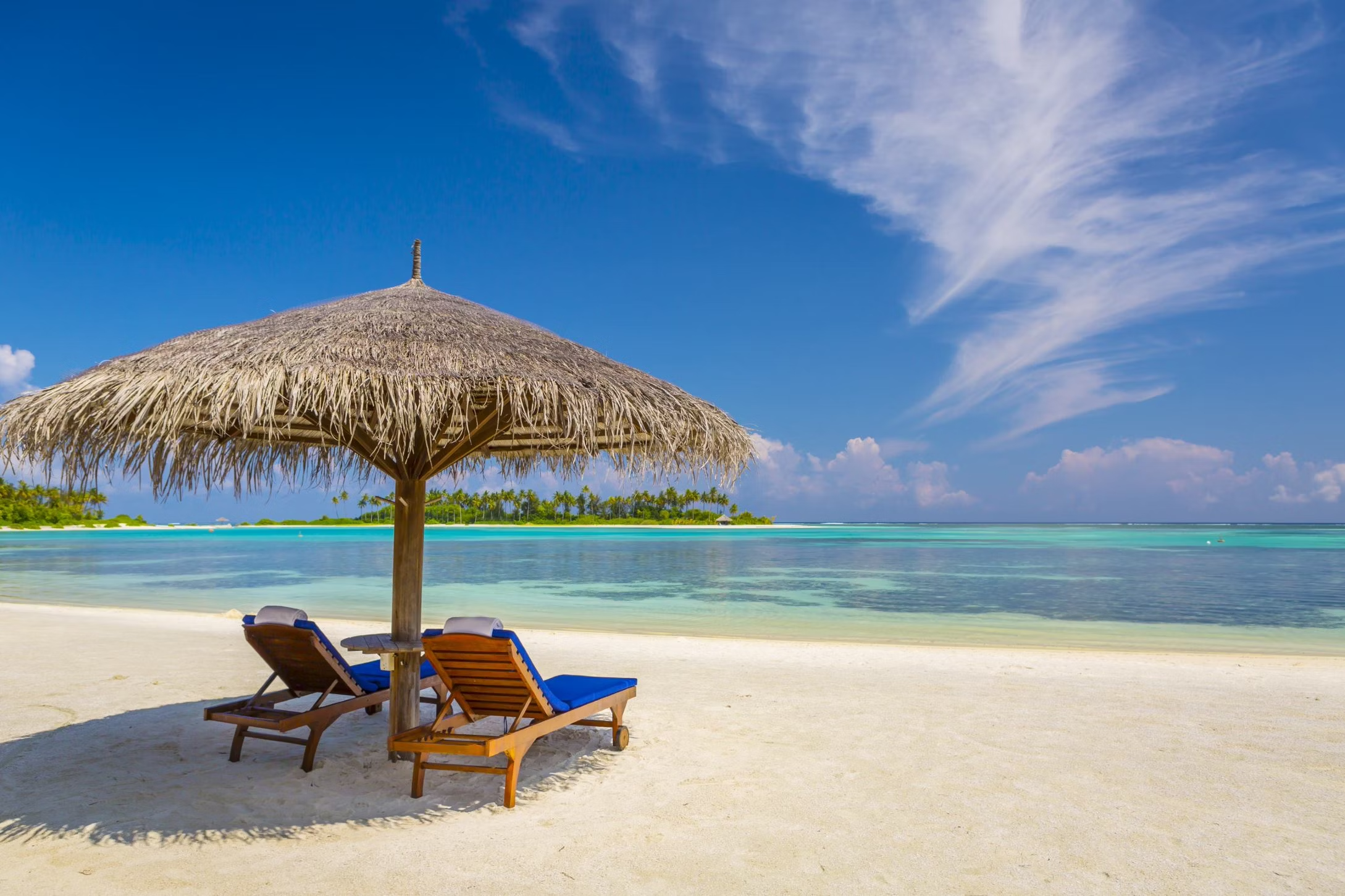
Posted by on 06 Apr 2022
Maldives is one of the best island destinations in the world. It has numerous atolls, clear waters, pristine beaches and dive sites filled with marine life. With its rich history and diverse landscapes and destinations, you’ll never run out of things to do in Maldives .
If it’s your first time going to this world-renowned island destination, you should know that there’s so much more to them than its beautiful beaches! We’ve listed some fun facts about Maldives that you should know to spice up your first beach holiday below.
Maldives: 15 Fun Facts for First-Time Visitors
Maldives is the world’s flattest country.
This beautiful island country has an average altitude of 1.8 metres: its highest point Villingili Island, is only 2.3 metres above sea level. To put things in perspective, the next flattest country ‒ Qatar ‒ already has an average elevation of 28 metres above sea level!
Maldives is Slowly Sinking
The 1,200 islands in Maldives are only nearly two metres above sea level on average, making the area more prone to rising sea levels, erosion and other environmental factors. As a result, the country is slowly sinking into the ocean. Thankfully, Maldives has strict environmental laws in place to minimise the impact.
Maldives Experiences Equatorial Sunlight
Maldives lies just across the equator. Since it lies on the equator, sunlight hits the country at a 90-degree angle. Avoid sunburn during your trip and apply sunscreen with an SPF of at least 50+.
Maldives Has Wet & Dry Seasons
Maldives has a tropical monsoon climate, and it experiences wet and dry seasons: the northeastern winter monsoon from November to March and the southwestern summer monsoon season from June to August both bring rain to the country. The northeast monsoon, in particular, is characterised by mild and dry winds along with showers.
Maldives Has Distinct White Beaches
Unlike most “white sand” beaches that have yellowish sand, the beaches of Maldives have true white sands. The sands of Maldives beaches are made of coralline. Other beaches often have sand from quartz with a yellow tinge. Coralline sands are rare and only present in around 5% of beaches worldwide.
Less than a Fifth of Maldives’ Island Population is Inhabited
Of the 1,200 islands as clusters and atolls in Maldives, only about 200 are inhabited, and 110 are reserved for tourism. The rest of the uninhabited islands are used for agriculture and other sources of livelihood because of an imposed travel ban in 1984. But since 2009, tourists can visit and enjoy the island country’s beautiful islands, beaches and resorts.
It Has the Biggest Whale Shark Population in the World
Maldives is a renowned diving destination. You’ll find giant whale sharks in the area, especially around the reefs near Sun Island.
You can also see these gentle giants and other shark species in Rangali Island and Hanifaru Bay. Keep your eye out in Maldives waters in case you catch sight of a whale shark!
It’s Home to Majority of the Earth’s Marine Turtle Species
Speaking of Maldives’ thriving marine biodiversity, its seas are home to five of the seven marine turtle species in the world. You can see loggerheads, leatherbacks, Olive Ridley turtles, green turtles and hawksbill turtles when you visit popular dive sites in the country.
Traditional Maldives Boats Don’t Use Compasses or GPS
If you’re visiting Maldives, expect to ride dhonis, or traditional Maldives boats. They are one of the best modes of transportation if you want to explore the atolls of island country.
You’ll be surprised that seasoned dhoni captains and crews still refrain from using GPS or compasses to navigate the various atolls and islands. Instead, they observe the movement of water in the lagoons to avoid dangerous reefs. Sometimes they navigate the waters by looking at the stars.
The Coconut Tree is Maldives’ National Tree
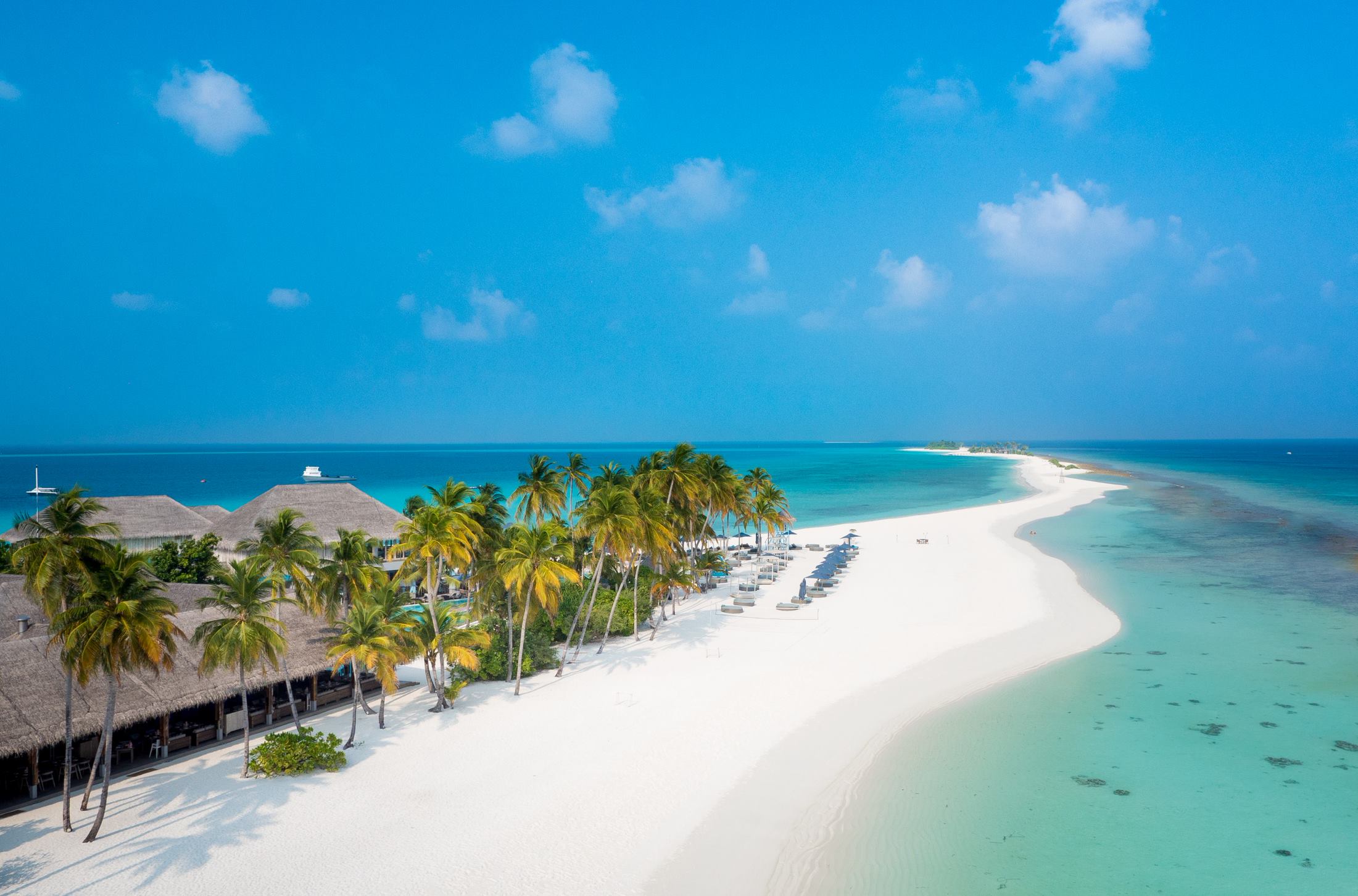
Coconut trees have various purposes: the trees provide much-needed shade to the islands' winding beaches and produce coconut milk and oil. They also produce coconut water, a refreshing drink. The coconut fibres are useful for coir rope construction, and native Maldives citizens use coconut wood to build dhonis for sailing.
Maldives Have Different Weekends
Unlike the majority of the countries that consider Saturday and Sunday as the weekend, Maldives have their weekends on Friday and Saturday. This is common in Egypt, Jordan, Oman and other Islamic countries. Whenever you plan to visit a local island, keep this in mind since some services and accommodations won’t be available on weekends.
The Boduberu is Part of Traditional Maldivian Music
You’ve probably seen those big drums made of coconut wood in Maldives — they’re called “Boduberu” and are the heart and soul of traditional Maldivian music. These drums use manta ray skin for the head, but modern versions are made with goatskin.
Boduberu music starts with a slow beat and tempo that gradually speed up in loudness and intensity. These performances usually involve 15 people: one lead singer, three drummers, while everyone else dances. Enjoy the lively music during your stay in Maldives!
Maldives Has Historic Coral Houses
Traditional Maldivian houses were originally made from corals due to coral mining. These houses used coral rocks from shallow reef flats. Since most citizens used lumber and coconut leaves to build their homes, coral was reserved for mosques, tombstones and monuments because they were a symbol of opulence.
A President of Maldives Once Held a Cabinet Meeting Underwater
Another unique and interesting fact about Maldives is that its former president Mohammed Nasheed held an underwater cabinet meeting in Girifushi. On October 17, 2009, Nasheed and 13 other government officials participated in the first underwater cabinet meeting. The agenda was to address the looming threat of global warming.
The officials signed a document asking all countries to reduce their carbon dioxide emissions and prevent climate change during the meeting. It was then presented at the Copenhagen Climate Change Conference in December of the same year.
Islam the Official Religion of Maldives
Islam is the state religion of Maldives. It has been the official religion since 1153, thanks to the influence of Arab and Persian traders in 947 AD. The law requires all citizens to be Muslim. Those in public office should be followers of Sunni Islam.
Make Your First Maldives Holiday Unforgettable
Enjoy the ultimate beach holiday experience as you soak up the sun on the white sand beaches, beautiful atolls and crystal clear waters with rich aquatic wildlife. Travel to Maldives today!
Whether you’re visiting alone or with your family and friends, Maldives is worth visiting. Explore the tropical paradise with our various Maldives holiday packages .
Keep reading

Some popular packages from Maldives Travel & Holiday Packages

Subscribe now for your chance to win a $500 Travel Voucher
Be the first to hear about our new Holiday Packages

49 Facts About Maldives
Written by Simonne Antonelli
Modified & Updated: 01 Jun 2024
Reviewed by Sherman Smith

The Maldives is a captivating tropical paradise located in the heart of the Indian Ocean. With its stunning white sandy beaches, crystal clear turquoise waters, and abundant marine life, it is no wonder that this island nation is a dream destination for travelers from around the world. But there is so much more to the Maldives than just its breathtaking natural beauty.
In this article, we will delve into 49 fascinating facts about the Maldives that will give you a deeper understanding and appreciation for this enchanting corner of the world. From its intriguing history and cultural traditions to its unique biodiversity and world-class resorts, prepare to be amazed by everything that the Maldives has to offer.
Key Takeaways:
- The Maldives is a beautiful paradise with 1,200 islands, stunning beaches, and vibrant marine life. It’s perfect for honeymooners, divers, and beach lovers seeking a luxurious and serene escape.
- The Maldives offers unique experiences like underwater hotels, whale shark encounters, and traditional music. It’s a safe, peaceful destination with rich culture, delicious cuisine, and breathtaking sunsets .
The Maldives is an archipelago of 26 coral atolls and 1,200 islands.
The Maldives is known for its stunning turquoise waters , white sandy beaches, and abundant marine life. It is a paradise for beach lovers and diving enthusiasts.
Malé is the capital and largest city of the Maldives.
Malé is a bustling city located on the island of Malé, known for its colorful buildings, vibrant markets, and historic mosques.
The Maldives is the lowest-lying country in the world.
With an average ground level of 1.5 meters (4 feet 11 inches) above sea level, the Maldives is vulnerable to the effects of climate change, including rising sea levels .
The Maldives is well-known for its luxury resorts.
Many resorts in the Maldives are located on private islands, offering a secluded and luxurious experience for honeymooners , celebrities, and travelers seeking ultimate relaxation.
The official language of the Maldives is Dhivehi.
Dhivehi is closely related to the Sinhala language spoken in neighboring Sri Lanka. English is also widely spoken in the Maldives, particularly in resort areas.
The Maldives has a population of approximately 530,000 people.
While the population is relatively small, it is culturally diverse, with influences from India , Sri Lanka, and Arab countries.
The Maldives is predominantly a Muslim country.
Islam is the official religion of the Maldives, and practicing Muslims constitute the majority of the population. As a result, the Maldivian culture is deeply rooted in Islamic traditions .
The Maldives has some of the world’s best diving spots.
The crystal-clear waters of the Maldives are home to vibrant coral reefs, colorful fish, and other marine species. Divers can encounter manta rays, whale sharks, and an array of fascinating underwater creatures.
The Maldives is a popular destination for honeymooners.
With its picture-perfect beaches, romantic sunsets , and luxurious resorts, the Maldives offers the perfect setting for couples celebrating their love and embarking on a new journey together.
The Maldives has a tropical monsoon climate.
The Maldives experiences two distinct seasons: the dry season (November to April) and the wet season (May to October). The temperature remains warm throughout the year, making it an ideal destination for sun-seekers.
The Maldives has a rich marine biodiversity.
With over 2,000 species of fish, 200 species of coral, and numerous other marine creatures, the Maldives is a haven for marine biologists and nature enthusiasts.
The Maldives is home to the world’s first underwater hotel, the Conrad Maldives Rangali Island.
Guests at this unique hotel can enjoy panoramic views of the ocean and marine life while staying in luxurious underwater suites.
The Maldives is made up of 99% water and 1% land.
The vast majority of the Maldives is covered by ocean, providing ample opportunities for water activities such as snorkeling, diving, and sailing.
The Maldives has a rich cultural heritage.
The Maldivian culture is influenced by South Asian, Arabic, and African traditions. Traditional music, dance, and art forms are an integral part of the Maldivian identity.
Maldivian cuisine is known for its seafood and coconut-based dishes.
Traditional Maldivian dishes often incorporate fresh fish, coconut, rice, and tropical fruits. Some popular dishes include mas huni (tuna and coconut salad), garudhiya (fish soup), and hedhikaa (short eats).
The Maldives is a popular destination for surfers.
The Maldives offers excellent surfing conditions, with consistent waves suitable for beginners and experienced surfers alike. Surfing enthusiasts can catch the perfect wave in the pristine waters of the Maldives.
The Maldives has a strict policy against alcohol consumption in public places.
Alcohol is generally only served in resorts and tourist establishments. However, non-Muslim foreigners are allowed to bring a limited amount of alcohol for personal consumption.
The Maldives is a haven for snorkeling enthusiasts.
The shallow lagoons and vibrant coral reefs surrounding the islands provide ideal conditions for snorkeling, allowing visitors to explore the underwater world up close.
The Maldives is a popular destination for fishing.
Fishing is deeply ingrained in Maldivian culture. Visitors can try their hand at traditional fishing methods or embark on a deep-sea fishing trip to catch a variety of fish species.
The Maldives is home to the largest population of whale sharks in the world.
Diving or snorkeling with these gentle giants is a once-in-a-lifetime experience, and the Maldives offers some of the best opportunities to encounter these magnificent creatures.
The Maldives has a literacy rate of over 98%.
Education is highly valued in the Maldives, with a strong emphasis on providing quality education to its citizens.
The Maldives is a popular destination for yoga and wellness retreats.
The serene and tranquil environment of the Maldives, combined with world-class yoga and wellness centers, attracts wellness seekers from around the globe.
The Maldives is a dream destination for photographers.
From mesmerizing sunsets to colorful marine life, the Maldives offers endless opportunities for photographers to capture stunning images .
The Maldives has a unique form of transportation called “dhonis.”
Dhonis are traditional Maldivian boats used for fishing and transportation between islands. Today, they are also used for tourist excursions and island-hopping.
The Maldives has a strong commitment to environmental conservation.
With its fragile ecosystem and vulnerability to climate change, the Maldives has implemented various initiatives to protect its coral reefs, marine life, and natural resources.
The Maldives is a popular destination for destination weddings.
Couples from around the world choose the Maldives as the backdrop for their special day, exchanging vows against the backdrop of picturesque beaches and azure waters .
The Maldives has a unique cultural dress called “dhivehi libaas.”
Dhivehi libaas is a traditional attire worn by Maldivian men and women for special occasions. It includes a sarong-like garment and a loose-fitting top.
The Maldives is home to an array of exotic marine life.
In addition to whale sharks, the Maldives is home to manta rays, turtles, dolphins, and various species of tropical fish.
The Maldives offers luxury underwater dining experiences.
Guests can enjoy a memorable dining experience surrounded by the mesmerizing underwater world, with panoramic views of marine life.
The Maldives has its own traditional music and dance forms.
Bodu Beru is a traditional Maldivian music and dance performance that involves drumming, singing, and energetic dancing.
The Maldives has a rich history of shipbuilding.
Traditionally, Maldivians were skilled shipbuilders, constructing vessels known as “dhonis” using traditional techniques passed down through generations.
The Maldives has a strong emphasis on sustainable tourism.
Many resorts in the Maldives have implemented eco-friendly practices to minimize their environmental impact, such as using renewable energy sources and implementing waste management systems .
The Maldives has stunning bioluminescent beaches.
At certain times of the year, the shores of the Maldives light up with the natural phenomenon of bioluminescence, creating a magical and enchanting sight.
The Maldives has its own traditional healing system called “Dhivehi Beys.”
Dhivehi Beys incorporates natural remedies, herbal medicines, and massage techniques to promote wellness and alleviate various ailments.
The Maldives hosts the annual Maldives Whale Shark Research Program.
This program aims to study and protect whale sharks in the Maldives, contributing to conservation efforts and raising awareness about these magnificent creatures.
The Maldives has natural underwater caves and swim-throughs.
Exploring these underwater formations is a thrilling experience for divers, offering a unique perspective of the marine environment .
The Maldives offers stunning sunset and sunrise views.
The unobstructed horizons and clear skies of the Maldives provide the perfect backdrop for breathtaking sunset and sunrise views.
The Maldivian currency is the Maldivian Rufiyaa (MVR).
However, US dollars are widely accepted in most tourist establishments, and many resorts provide the option to pay in major foreign currencies.
The Maldives is a popular destination for water sports.
From jet skiing and parasailing to windsurfing and kayaking, the Maldives offers a wide range of thrilling water sports activities for adrenaline junkies.
The Maldives has a National Museum located in Malé.
The National Museum showcases the rich heritage and history of the Maldives, with exhibits ranging from ancient artifacts to traditional costumes.
The Maldives is a prime destination for birdwatching.
With its diverse ecosystems, the Maldives is home to numerous bird species, including seabirds, herons, and migratory birds.
The Maldives has a unique method of seaweed farming.
Seaweed farming is an important industry in the Maldives, with farmers using traditional methods to cultivate and harvest various types of seaweed.
The Maldives is a peaceful and safe destination.
With low crime rates and a warm and welcoming local population, the Maldives is considered a safe destination for travelers .
The Maldives has pristine and untouched islands.
Despite being a popular tourist destination, many islands in the Maldives remain untouched, providing a sense of serenity and tranquility.
The Maldives is located in the Indian Ocean.
It is situated southwest of Sri Lanka and India, making it easily accessible for travelers from various parts of the world.

The Maldives offers unique cultural experiences.
Visitors can immerse themselves in Maldivian culture by participating in traditional music and dance performances, visiting local markets, and engaging with local communities.
The Maldives has a tropical fruit called “kurumba.”
Kurumba, also known as Maldivian coconut, is a delicious and refreshing fruit found in abundance in the Maldives.
The Maldives has its own traditional handcrafts.
Maldivian artisans create beautiful handicrafts, including intricate lacquer work, woven mats, and wooden carvings.
The Maldives is a dream destination for beach lovers.
With its powdery white sand, crystal-clear waters, and palm-fringed shores, the Maldives offers some of the most stunning and picturesque beaches in the world.
The Maldives is truly a paradise on Earth with its breathtaking natural beauty, pristine white sandy beaches , crystal-clear turquoise waters, and vibrant underwater world. It offers a unique blend of luxury, relaxation, and adventure that caters to all types of travelers. Whether you’re looking to unwind in an overwater bungalow, explore vibrant coral reefs, indulge in delicious local cuisine, or simply enjoy the laid-back island vibes, the Maldives has something for everyone.With its rich history, vibrant culture, and warm hospitality, the Maldives captivates visitors from around the world. From its unique geographical formation to its diverse marine life, there are countless fascinating and awe-inspiring facts about this tropical paradise that will leave you wanting to book your next trip soon.So, whether you’re planning a honeymoon, a family vacation, or a solo adventure , the Maldives promises an unforgettable experience that will leave you with memories to last a lifetime. Explore the islands, immerse yourself in the local culture, and discover the wonders of this little piece of paradise in the Indian Ocean.
1. What is the best time to visit the Maldives?
The best time to visit the Maldives is between November and April, during the dry season when the weather is sunny and the seas are calm.
2. Do I need a visa to visit the Maldives?
No, tourists traveling to the Maldives do not require a visa. A thirty-day tourist visa is granted upon arrival.
3. Are there any cultural norms or dress codes to follow in the Maldives?
The Maldives is a Muslim country, and while tourists are not expected to adhere to strict dress codes , it is recommended to dress modestly when visiting local islands or religious sites out of respect for the local customs and traditions.
4. What is the currency in the Maldives?
The currency of the Maldives is the Maldivian Rufiyaa (MVR), but US dollars are widely accepted in most resorts and tourist areas.
5. Are there any water sports and activities available in the Maldives?
Absolutely! The Maldives is a haven for water sports enthusiasts . From snorkeling and diving to surfing and kayaking, there are endless opportunities to explore the vibrant marine life and enjoy thrilling water adventures.
6. Can I visit local islands in the Maldives?
Yes, you can! In recent years, the Maldives has started welcoming tourism to local islands, providing a chance to experience the local culture and interact with the friendly locals.
7. How do I get to the Maldives?
The Maldives is primarily accessed by air. Most international flights land at Velana International Airport, located on Hulhule Island near the capital city, Male. From there, you can reach your resort or local island by domestic flight or speedboat.
8. Are there any health and safety precautions to be aware of?
It is always recommended to check with your healthcare provider for any necessary vaccinations before traveling to the Maldives. It is also important to be mindful of sun exposure , stay hydrated, and follow all safety guidelines when engaging in water activities.
9. What are some popular activities to do in the Maldives?
Some popular activities in the Maldives include snorkeling, diving, fishing, island hopping, spa treatments , and indulging in exquisite dining experiences.
10. Can I find vegetarian or vegan food options in the Maldives?
Yes, most resorts and restaurants in the Maldives offer vegetarian and vegan food options. However, it is always recommended to inform the staff about your dietary preferences in advance.
Maldives' allure extends beyond pristine beaches and luxury resorts. Surfers flock to ride perfect waves during specific seasons, while nature enthusiasts marvel at the unique formations of coral atolls . For those seeking more exotic destinations, Turkey's Salda Lake captivates with its striking resemblance to Mars' terrain . Delve deeper into these intriguing aspects of the Maldives and beyond, as you plan your next unforgettable adventure.
Was this page helpful?
Our commitment to delivering trustworthy and engaging content is at the heart of what we do. Each fact on our site is contributed by real users like you, bringing a wealth of diverse insights and information. To ensure the highest standards of accuracy and reliability, our dedicated editors meticulously review each submission. This process guarantees that the facts we share are not only fascinating but also credible. Trust in our commitment to quality and authenticity as you explore and learn with us.
Share this Fact:
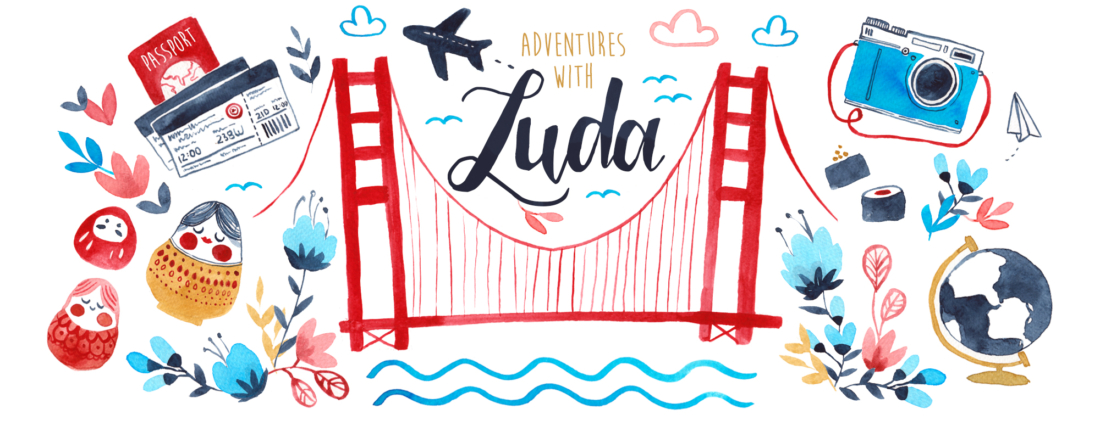
17 Things You NEED To Know Before Traveling to the Maldives: What To Do (And Not To Do!)

THE BEST MALDIVES TRAVEL TIPS
For many travelers, the Maldives is an elusive destination that has so many stereotypes: it’s a hard to reach country only for the super-rich who can afford to stay in overwater villas – but that’s not true (at all)! There are so many misconceptions about the Maldives, and I want to set them straight.
I created this post about the best Maldives travel tips because there was such a lack of information when I was planning my trip. I wanted to make sure other travelers could feel comfortable before they visit the country.
You might be wondering, Why is there a lack of information? That’s because the Maldives is fairly new to tourism – it opened its doors for tourists in the 1970s by creating villa resorts, and regular guesthouses only became legal 10 years ago! Tourism simply hasn’t caught up to the level of other major island destinations, like Bali or the Dominican Republic, which means it’s the perfect time to visit.
So without further ado, here’s everything you need to know before traveling to the Maldives — from travel advice, what to do, and what to avoid in the Maldives. Let’s check it out!

1 – Be respectful of the religion
Before doing my research, I had no idea that the Maldives is a Muslim country. That means that you’ll have to follow a few extra rules, especially when visiting the local islands:
-Be sure to cover up your shoulders, chest, and knees -Alcohol is forbidden everywhere except resort islands (see below for more info!) -No public displays of affection
2 – Tourists have their own beach
Wow, a private beach?! That’s right – sort of.
Like I mentioned above, travelers should be respectful of the local culture and cover up… but what do you do when you want to swim in that gorgeous sea-blue water? The government came up with a solution: Bikini Beaches.
Nope, this isn’t a joke from Spongebob. In every local island, you can expect to find at least one Bikini Beach . This is a separate, usually closed-off beach where tourists can freely frolic and swim in their bikinis. Locals have their own beaches as well, although they are considerably more covered up. If you’re worried about getting lost and ending up on the wrong beach, no worries – there are clearly marked signs (Usually ‘Bikini Beach’ or ‘Tourist Area’) and a huge wall (our hotel mentioned that it was there so the locals don’t “accidentally” look in!)
3- Absolutely (Almost) No Alcohol
Since the Maldives is a 100% Muslim country, that means there is absolutely no alcohol sold on the local islands. But , you might be wondering, what about the all-inclusive resorts?!
That’s where the rules are a little more relaxed: If you’re staying at an all-inclusive resort in the Maldives, there will be alcohol. Private islands, resorts, and villas are excluded from the alcohol ban and will have plenty of booze to choose from: wine, beer, spirits, and more.
Not staying at a resort? Don’t lose hope and head over to Maafushi. Some entrepreneurial Maldivian locals found a loophole in the system: they bought a boat, anchored it off the shore of Maafushi island, and can legally serve alcohol because they’re technically not on a local island. Sure, you’ll need to take a speedboat to get to the “floating bar,” and pay for overpriced drinks ($7 for a beer), but it’s an option. Voila!

4- When is the best time to travel to the Maldives?
Depends on who you ask! The dry season is from December to April and is dry (duh) with little rain and lesser humidity. The wet season is from May to November, where there is more humidity and higher chances of rain. Here’s a quick breakdown of some of the best times to visit the Maldives:
Prices skyrocket during the holiday season (Christmas, New Years, and Valentine’s Day) and you might be forced to pay for extras, like a New Year’s Banquet meal at your resort, if you visit during these days.
5- Don’t be afraid of a little rain…
I booked a trip to the Maldives as a surprise for my mom’s birthday in September — which, you guessed it — is during the wet season. After reading horror stories on TripAdvisor, I was so afraid that it was going to rain the whole time. Thankfully, I had nothing to worry about: There were two small showers that lasted a maximum of 5 minutes, and one rainstorm that started around 2 am and finished before 9 am. Much better than the hours of heavy rain and thunder that I had nightmares about! ;)

6- The Maldives aren’t just ultra fancy all-inclusive resorts
Before I traveled to the Maldives, I had this image in my head that the country is made up of a bunch of overwater bungalow islands and nothing else. I was so wrong! There are actually four types of islands in the Maldives:
- Resort islands – all-inclusive resorts, villas, overwater bungalows, etc
- Local islands -like the capital Male , Maafushi , Gan, etc
- Picnic islands – a small sandbank, usually a few meters wide, where boats stop to have a picnic
- Uninhabited islands – nobody lives here, and there are about 900 of these in the Maldives!
To get the most of your visit to the Maldives, check out both resort and local islands. If you do a half- or full-day tour, a lunch on a sandbank island is usually included!
7- Book in advance for the best deals
You might have heard this nugget of advice before, but it’s especially important when traveling to the Maldives. For the cheapest accommodations in the Maldives, book at least a few months out, especially if you want to save money on a resort room or overwater villa.
I found a great deal through Booking , although I heard that Agoda has excellent sales (and coupon codes!) as well.

8- Visit Male, but don’t forget to explore other islands
There are two kinds of tourists who visit the Maldives for the first time:
1. Those that arrive in the Maldives, go straight to their all-inclusive resort, and skip Male altogether. 2. Those that get stuck on Male for the entire duration of their trip and don’t venture out at all
If it’s your first time in the Maldives, I recommend a mix of both: don’t skip Male but don’t spend your whole vacation there either.
Although Male is a lovely capital, I think a maximum of 2 (maybe 3) days is plenty of time to see everything. If you check out my Male City Guide post , you’ll see that the island is very small – only 1.7 kilometers wide! – and you can easily see all of the tourist attractions and do most activities in these two days.
After Male, we visited a local island, Maafushi , for 3 days and it turned out to be a highlight of our entire trip to the Maldives (check out that colorful street in the photo!) Go out there and explore!
🏝 Want to know more about Maafushi? Check out my travel guide here! 🏝
9 – Adjust your (internal) clock to island time
Speaking of islands… Just like Hawaii, the Bahamas, and other islands, the Maldivians have a relaxed attitude towards time and don’t like to rush. Don’t be surprised if your tour guide shows up a few minutes late, your food takes a while to get to your table, or the ferry stalls past its departure time. Obviously, make sure you’re on time to your tour, but don’t worry too much if everything is a few minutes late. It’ll eventually happen – just relax ;)

10 – Budget accordingly for the Maldives “tourist tax”
Benjamin Franklin once said that there were only two things certain in life: death and taxes. I wouldn’t be surprised if he traveled to the Maldives, because their tourist tax is 23%.
Yes, you read that right – twenty-three percent! When you book accommodations in the Maldives, take a long, hard look at the fine print. You’ll usually see that it’s been lumped into a flat 23% tax, or separated into a 12% tax plus an 11% property service charge. On the majority of booking sites, this tax is not included in the final price, so your total may go up by a few dollars (or more).
Likewise, this tourist tax is not just reserved for fancy resorts and all-inclusive hotels – in the photo above, you can see that even regular accommodations (hotels, bed and breakfasts, and hostels) all have this tax. Plan accordingly!
11 – Getting Around the Maldives: Transportation can get expensive…
If you plan to stay at a Maldives resort or all-inclusive hotel, make sure you know how much the transfer is going to cost. The Maldives is made up of hundreds of islands (more than 1,200!), and getting from one island to another is sometimes only possible by plane or speedboat.
This is especially true of resort islands, who make you take their mandatory transportation to the island. The most expensive option is usually the seaplane, which starts at $250 per person and can run up to $600 for a round-trip transfer.
We paid $130 per person for our roundtrip speedboat transfer from Male to our resort ( Adaaran Vadoo ), which is considered to be on the cheaper side. Private speedboat transfers start at $100 per person and can go up to $250 or 300 round trip.
12 – … But it can also be extremely cheap!
After our stay at the resort, we did a little island hopping and traveled to Maafushi, one of the most popular local islands. The ferry took 90 minutes and only cost us 30 MVR ($2 USD) per person! Using ferries instead of speedboats to get from local islands is a super cheap way of seeing the Maldives on a budget, as most ferry tickets are only a few dollars. You can expect to pay at least $20 per person for speedboat transfers for the same routes.
🌴 Want to know how much I spent on my Maldives trip (down to the dollar)? 🌴 Check out my Maldives Budget Breakdown Spending Report here!

13 – Carry new dollar bills
Speaking of ferries: When we boarded our ferry from Male to Maafushi , a small fight broke out on the ship when the couple in front of us tried to pay for their ticket with USD.
No, don’t worry, it wasn’t the wrong currency (see below) – the dollar bills that they tried to pay with were so wrinkled and old that the ticket collector didn’t want to take them! If you’re planning to use a currency other than the Maldivian rufiyaa, make sure that your bills are new, crisp, and don’t have any ripped or torn edges.
14 – Can I use US Dollars in the Maldives? Yes!
It’s nice to have Maldivian rufiyaa, but if you don’t – no worries. USD is an acceptable “alternate” currency and you can use it to pay at your hotel, restaurants, souvenir stores, and so on. The exchange rate is usually favorable (be sure to calculate it beforehand just in case) and most shopkeepers will be happy to tell you the price in USD.
15- Ferries don’t work on Friday
As mentioned above, the Maldives is a Muslim country, which means that Friday is their “day off” and is used to rest and pray. Because of this, the public ferries do not work on Friday.
I recommend planning and arranging transportation beforehand if you have to travel on a Friday (especially if it’s the day of your flight!) so that you’re not left scrambling to find something at the last minute.
For example: we were checking out of our hotel on Maafushi and heading back to Male on a Friday (our flight home was the next day). Thankfully, the fantastic owner of the hotel we stayed at, Stingray Inn , arranged a water taxi transfer straight to Male that only took 15 minutes.

16 – There’s Cell Service Everywhere
Although the Maldives is usually a place to unplug and unwind, sometimes you need to stay connected … to make everyone jealous of your beach selfies LOL
Luckily, there’s cell phone coverage everywhere, even in the middle of nowhere. I bought a pre-paid SIM card package from Dhiraagu for about $30 and had internet on a catamaran in the middle of the ocean (exhibit A: me smiling on said catamaran ;) ), while eating lunch on a picnic island, and even on a ferry from Male to Maafushi.
17 – ATMs & Credit Cards
Before traveling to the Maldives, I was worried about not having enough cash on hand to pay for everything. Thankfully, credit cards are widely accepted everywhere, and I only had one place that was cash only (a small souvenir kiosk near the beach!). In case you still need cash, there are ATMs on every major island.
That’s it for this post. I hope it was useful for your trip to the Maldives! Did you learn anything new or did anything surprise you? As always, happy travels and see you next time!
Related Posts
30 thoughts on “ 17 things you need to know before traveling to the maldives: what to do (and not to do) ”.
I love how color of your dress fits in! Thanks for tips, I had no idea there was a tourist tax, but on the other hand quite a few countries do it. Beautiful place!
I also had no idea the Maldives were a Muslim country! You learn something new every day! Thanks!
Great guides for those who haven’t visit Maldives, like me haha. But I guess, be respectful applies to all countries. Thanks for sharing this. will definitely take note of it.
I learnt a lot about the Maldives from your blog. I knew it was a Muslim country so I expected it to have similar laws to Dubai where I live. I do plan on going there at some point so this is all good and unhidden info!
These are some great tips for tourists in the Maldives. I’m hoping to be able to travel there someday – it just looks so stunningly beautiful! I had no idea that they accept USD…I never would have guessed that. Thanks also for the tips on how to dress to be respectful of the religion.
Great tips! The no bikini and alchohol would be difficult but I know not every beach is like that. However, for that view the sacrifice would be worth it!
wow girl. You know? Today is snowing in Moscow and read this about Maldives have made me wanting to buy a ticket to somewhere warm….I am dreaming of going to Maldives for so long. Thanks so much for all your tips. Hopefully next year!!!
I didn’t realize how little I knew about the Maldives until I read this. High tourist tax I expected but I didn’t think you’d get cell service. I can only persuade my partner to travel if he can have access to wifi lol
This is such a comprehensive guide of MALDIVES. Stunning views. Would love to experience them. Hopefully, soon.
Omg wow, i would never have imagined its a Muslim country so you would have to be aware of their cultures. Its so important to do your research before visiting a place!
I had NO IDEA that the Maldives was a Muslim country. Just like you said, I tend to envision it as a country made up only of overwater bungalows! I guess that’s just all we ever see of it. This was super helpful, as the Maldives has been inching closer to the top of my list of places I want to go next, and I knew almost nothing about it!
Some good tips out there. We had stayed in water villas in the Maldives. This luxurious stay did cut a deep hole in our pockets but it was worth the money spent. Honeymoon or no honeymoon, Maldives is a very romantic place. My kids would get delighted to see baby sharks come close to the shore. Since we were staying in water villas we could see full grown sharks and stingrays swim under our villa. I remember once while snorkeling with the kids, I noticed a jellyfish swim towards us. I think we swam the fastest that day 😛
Thanks for a detailed write up. We are planning for a vacation and were confused about Maldives and Mauritius. This is a great post. Your pics are lovely!
I had no idea the Maldives was a Muslim country! I would have been wandering around looking for the margaritas! Ha! Seriously though it looks so beautiful, I would LOVE to visit someday.
I did not know about 80% of these things about the Maldives! I totally had the image that it was an island with the pretty overwater villas. Random question- when I think rain season, my mind automatically is afraid of bug bites, was that an issue when you went?
I had a few bug bites when we got lunch at a beach cafe (I think from sand bugs?) but no mosquitos thankfully :) I read somewhere that a lot of the resort islands go around with anti-mosquito spray so that guests don’t get bit!
This is such an informative post. I particularly like that you don’t make it sound like the Maledives are just a long beach, but that it’s a country and people should respect the culture. Sadly, many travellers forget this little fact ;-)
So true! I was surprised to see that the capital was this huge bustling city – it pays off to do research ahead of time :)
This is such a comprehensive travel guide with all the important information needed by first timers. The Maldives are everyone’s dream destination and with this guide, It will be easier for travelers to plan their trip to the Maldives right. Thank you so much for sharing this with us.
Hi, thanks for sharing. We took a 20 min speed boat from Male and it was great. Maldives is a wonderful place for couples and families. Our kids enjoyed everything, and we took amazing pictures.
Thank you! The speedboats are such a great way to get around the Maldives, aren’t they? :)
Very detailed post. Thanks for sharing.
I have been having issues with finding the best travel guide for me. After reading this article, my issues has come to an end. I really love the information you provided here as it has helped me a lot.
Heyyy stranger…such a wonderful and elaborate description ..actually I am planning for a trip with a company and I felt the need to do my homework and voila!! I found your article. Looked like you wrote it so that it could reach me today. Having said that, I have some questions and I’ll appreciate your reply so that I can finally decide whether or not to go on that trip.
Heya! Sure, no worries – feel free to reach out with any questions! :)
Thanks for this wonderful blog. I was thinking of taking tour package, but after reading your blog am encouraged to do it and I am pretty sure many people would have felt the same.
I didn’t know the fact that Ferries don’t work on Friday before my Trip but I get to know it while wandering in the Maldives. Info shared by you is important for first-time goers. Thank you
Thank you so much for the information that you shared. I feel more comfortable about taking this trip now.😊
Thank you for your kind words! I hope you have a fantastic trip! :)
Hi, Wow, Thank you for sharing this amazing post! I am so happy to read this and will also plan to visit the Maldives as soon as possible; it is such a wonderful country to explore.
Leave a Reply Cancel reply
Your email address will not be published. Required fields are marked *
Notify me of follow-up comments by email.
Notify me of new posts by email.
- Best activities to do. My all time favorites
- Discover the Maldives. Essential Travel Resources
- Your TOP 10 Best Maldives Resorts 2024. The Hotels That Made YOU Dream
- TOP 10 Best Resorts 2025. Cast Your Vote
- Maldives Ultimate Dream Villas
- Version française
Latest post

Flying High : A Complete Guide to Maldives Seaplanes

Maldives Resorts Reviews & Island Stories

- Island Stories
18 Facts You Might Not Know about Maldives
I propose you 18 interesting facts about Maldives that you should know : from having the world’s lowest country, fishes that produce 1 ton of sand per year to whale shark sanctuary and volcanoes, I will show you here that the Maldives islands are much more than a picture perfect tropical paradise.
18 Fun Facts about Maldives
The 18 facts about maldives everybody should know, maldives equatorial sun light, maldives sandbanks and islands shapes.
- Maldives Whale Sharks
Maldives Origins
Maldives has a world record : the lowest country on the planet, maldivian melting pot, maldives dhoni shapes, maldives coins and money, maldives coral houses, maldives traditional music : the bodu beru, maldives desert islands, maldives flag, maldives coconut trees, maldives have some of the smallest islands in the world, maldives dhoni captains are authentic sailors, feeding fishes in maldives, maldives sand is fish poop, maldives coral sandy beaches.
Fun Facts about Maldives origins, their people, geography, culture and other things that everybody should know !
Dreaming of Maldives. The Video
Beware of the sun in Maldives! A very high sun protection is a must-have. Located close to the equator, Maldives receive high amount of Sunrays. Almost direct, they strike at a 90° angle.
The Maldives Dreamiest Resorts in 2024
YOUR TOP 10
In Maldives, some island shapes can be modified by nature. Their sand is moved away and eventually brought back by seasonal currents during monsoons. Some sandbanks disappear and some new ones emerge.

Dreaming of Sandbanks in Maldives in 32 Photos
The World’s biggest fish has its official sanctuaries in Maldives with 3 places along the archipelago. The Maldives are one of the few places on Earth where Whale sharks can be encountered all year round.
Maldives are likely to be the reminiscence of a chain of sunken volcanoes formed around 60 millions of years ago. Recent studies suppose that coral reef atolls have formed over hundreds of thousands of years on their sinking remains.

A new Island is born in Maldives
Maldives owns the title of the lowest country in the World with an average of only 1.5 meters above sea level.
The Maldives were a crossroads of the ancient trading routes. Today’s Maldivian multiple faces are the fruit of a civilization mix : Indian, African, European, Arabian, Asian…
The shape of the famous traditional Maldivian boat , the Dhoni, might have been inspired from the ancient Arabian sailing dhow, commonly used as a trading ship in Indian Ocean around the 11th Century.
Maldives Dhonis. Our Video Tribute
Cowry shells can be found by millions in Maldives. They were used as units of money during medieval times. This is why nowadays shells commonly ornate Maldivian coins.
Maldivian used to build their houses in coral. This traditional housing is now forbidden since Coral Reefs are worldwide protected. Many coral houses still can be seen in Male and local islands.
The drum-based traditional music, Bodu Beru ( meaning big drum) is a reminder of Maldives long relations with East Africa a few centuries ago. Bodu Beru music is very rhythmic and can be perceived as transcendental.

Maldives Traditional Music – The Bodu Beru. At the Heart of Maldives Music Soul
There are approximately 1200 islands in Maldives. Around 800 of them are still uninhabited, 200 islands are populated, about 200 host Hotels and Resorts. The rest of the islands are used for airports, agriculture, picnics, governmental assets, industrial activities and even jails ! The number of islands in Maldives is increasing with the recent development of entirely man-made artificial islands .

Maldives Islands Aerial Photography. Baa Atoll Island
The Maldives flag has various symbols and symbolic colors : Green for peace and the national Coconut Tree, a White Crescent for Islam and Red for the blood of their fights for independence.
The coconut tree is one of the symbols of the Maldivian emblem. National tree of the islands and only natural shade protection of Maldives beaches, coconut trees can grow up to 30 meters and reach the age of 100 years. Their wood is extremely solid and widely used to build Dhonis.
The Maldives have some of the smallest islands in the World with no more than a few square meters size. The largest island barely reaches 6 kms long.
Some dhoni Captains and crews still do not use compass or GPS to navigate through the islands and atolls. They find their ways throughout the coral labyrinths helping themselves with the bow of their dhoni’s and the stars. During clear nights, some have the rare ability to carefully observe the moves of the lagoon surface to avoid coral reefs.
In the Maldives, where more than 2000 fish species live and where snorkeling is a MUST-DO, you will meet countless multicolored sea creatures with various shapes and patterns. Among the most common fishes you will surely meet while snorkeling in Maldives you will see But feeding fishes during Snorkeling in the Maldives or elsewhere in the world is harmful to them. Our food is not part of their ecosystem and surely not adapted to their digestive system. No Bread ! The sea is NOT a bakery.
See also My complete guides to snorkeling in Maldives

- Maldives Snorkeling Guide
- The Best of Maldives
The Maldives Resorts With a Dream House Reef for Snorkeling

3 of The Best Atolls for Snorkeling in Maldives

- Plan Your Maldives Journey
Swim With Whale Sharks In Maldives. Make Your Dream come true
Parrot fishes are huge contributors to the beauty of Maldives beaches. Their fine coral sand is the result of undigested corals they eat. We estimate that an adult parrot fish can produce around 1 ton of sand per year !
The Maldives islands are of coralline origins. Their amazing sand is white and extremely fine. Coralline beaches are rare, they represent less than 5% of the World beaches, the rest of them are mostly made of quartz. This is why the Maldives have Paradise beaches everywhere !

Which Island has the best beach in Maldives ?

Maldives Paradise Beaches . 50 Photos
Follow us on Facebook , Youtube and Instagram for more Maldives Dreams
This site uses affiliate links and I may earn a small commission when you use my links and make a purchase without incurring additional fee yourself. Many thanks for supporting this website. Please see my privacy & policy page for more details.
I am Rozenn, Dreaming of Maldives Founder and Editor. Expat for several years in Maldives, I keep on exploring the archipelago and share here my most beautiful Stories and Experiences. Since 1999, we travel to the Maldives several times a year for [ more... ]
- Bodu Beru Maldives
- coconut trees Maldives
- Coral Houses Maldives
- Equatorial Sun
- fragile nature
- Maldives Coral Walls
- Maldives fishes
- Maldives formation
- Maldives Fun Facts
- Maldives Geography Facts and Information
- Maldives Money
- Maldives National Flag
- Maldives origins
- Maldives sandbank
- Maldivian dhonis
- The Equator and the Maldives
Latest Articles

Maldives Floating Breakfast ? No. Thank you.

The Maldives Best Seaplane Routes for a Dreamy Scenic Flight

Your TOP 10 Best Maldives Resorts 2024. The Hotels That Made You Dream

The Maldives New resorts Scheduled For Opening In 2024

Video of the most common fishes in Maldives. Let’s go snorkeling !
Beautiful article.
Leave a Reply Cancel reply
You must be logged in to post a comment.
This site uses Akismet to reduce spam. Learn how your comment data is processed .
Dreaming of Maldives Social Network

The facebook page for the latest news, photos, videos and stories

A question ? An experience to share ? The Maldives Dreamers discussion group is there for you

Instagram for more photos

Youtube channel for more videos
We are Wandering the Maldives for more than 20 years. 82 Resorts visited and counting... 17 Atolls discovered... Countless Desert Islands and Sandbanks... Hundreds of seaplane flights... Yet, We Keep on Dreaming of Maldives
Input your search keywords and press Enter.

40 FUN Facts About The Maldives
Last updated on October 23, 2022
Known for iconic pristine beaches and as a desirable vacation spot, Maldives is more than just a tropical paradise and these facts about the Maldives will showcase that! Probably the first, most important fact about Maldives to know is that it is pronounced ‘maal-deevz’. Got it? Now we can move forward!
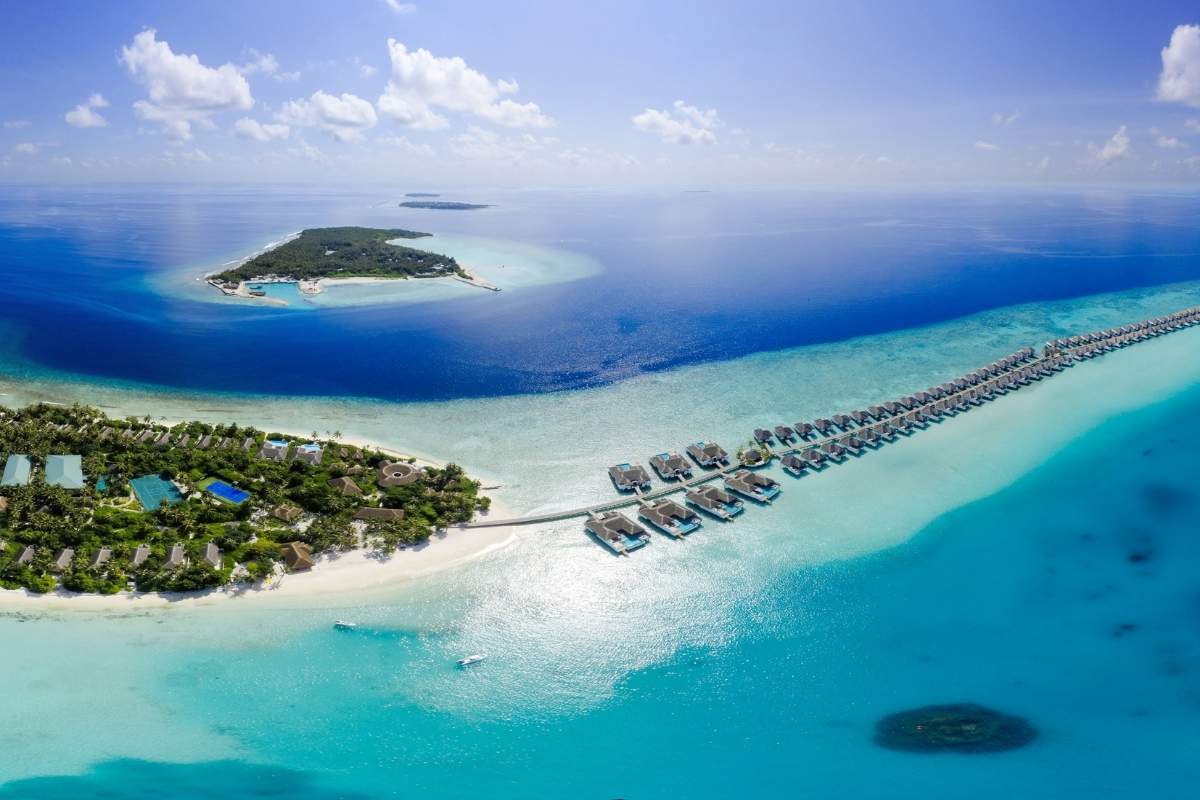
Full of history, interesting geography, diverse landscape, and intriguing animals that call it home, the Maldives are a treasure trove of cool facts. Read these facts about the Maldives to know more and then take our quiz to see how well you did!
Know your stuff about the Maldives? Then go ahead and test your knowledge with our Maldives quiz, or if you’re not quite ready, keep reading to find out some cool facts to prep you.
Interesting Facts About the Maldives
Geography facts about the maldives.
~ The Maldives is an island nation famous for its white sandy beaches. It is the smallest country in Asia and spreads across the equator, making sun protection an absolute must if you plan on visiting.
~ The sea makes up more than 99.5% of the Maldives (90 000 sq km surface area). Now all the beaches found here make a lot of sense!
~ The Maldives islands are an archipelago in the Indian Ocean that stems from the crowns of an ancient volcanic range that is now underwater. The whole country is made up of approximately 1,200 islands with coralline beaches. Barrier reefs protect the local islands from the seasonal northeast monsoon.
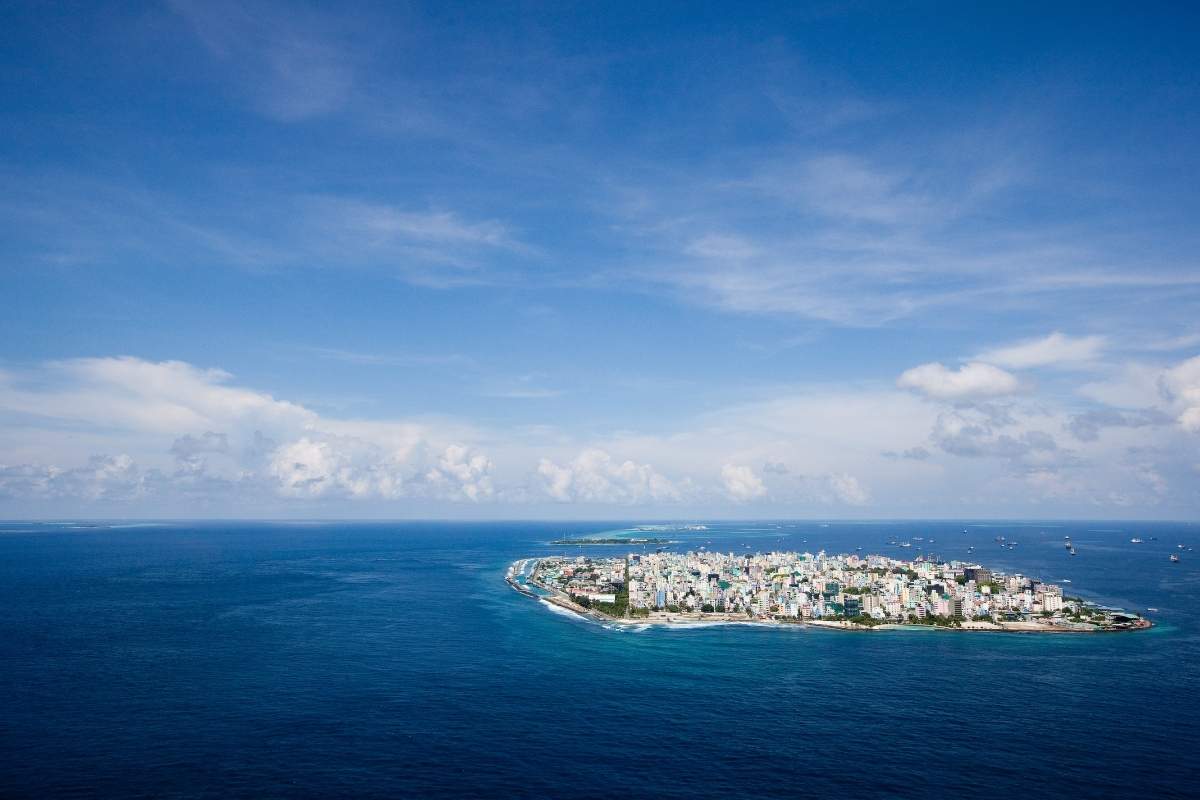
~ It is not only the lowest country in the world, but it is also the flattest country. None of the Maldives islands rise more than 1.8 meters above sea level, with the highest point found on Villingili Island. The average altitude is only 4 feet above sea level.
~ The Maldives’ perfect white sands, displayed on many a Facebook page, are due to the unique coralline beaches. All the coralline beaches in the Maldives are the result of undigested reef material eaten by parrotfish.
~ The islands’ low-lying nature puts the Maldives under threat from climate change and rising sea levels. The Maldives are already the lowest country in the world, but due to increasing land erosion, it is also at risk of becoming completely submerged. In 2009, then-president Mohamed Nasheed held an underwater cabinet meeting, the first of its kind in the world. Cabinet ministers staged the meeting as a way to bring attention to the way the climate crisis has affected the Maldives. Due to its status as the lowest and flattest nation, the Maldives are among the most at risk of being swallowed up by the ocean.
~ Maldives is an archipelagic state located in Southern Asia, situated in the Indian Ocean. It lies southwest of Sri Lanka and India, about 750 kilometres from the mainland.
~ Maldives consists of a chain of about 1,200 small coral islands and sandbanks (some 200 of which are inhabited), grouped in clusters, or atolls. From that, over 132 resorts can be found throughout the different atolls.
~ The Maldives is the flattest country in the world with the highest point being only 7 feet and 7 inches above sea level.
Biodiversity In the Maldives
~ Seasonal currents deliver nutrients to the waters surrounding the islands, making the Maldives one of the best destinations for scuba diving in the world. Baa Atoll is world famous for its extremely fine white sand and for its abundance of marine megafauna, including the world’s biggest fish, the whale shark.
~ Not only is it the world’s biggest fish, but some species of whale sharks also have tiny teeth on their eyeballs! A feature not seen in any other vertebrates.
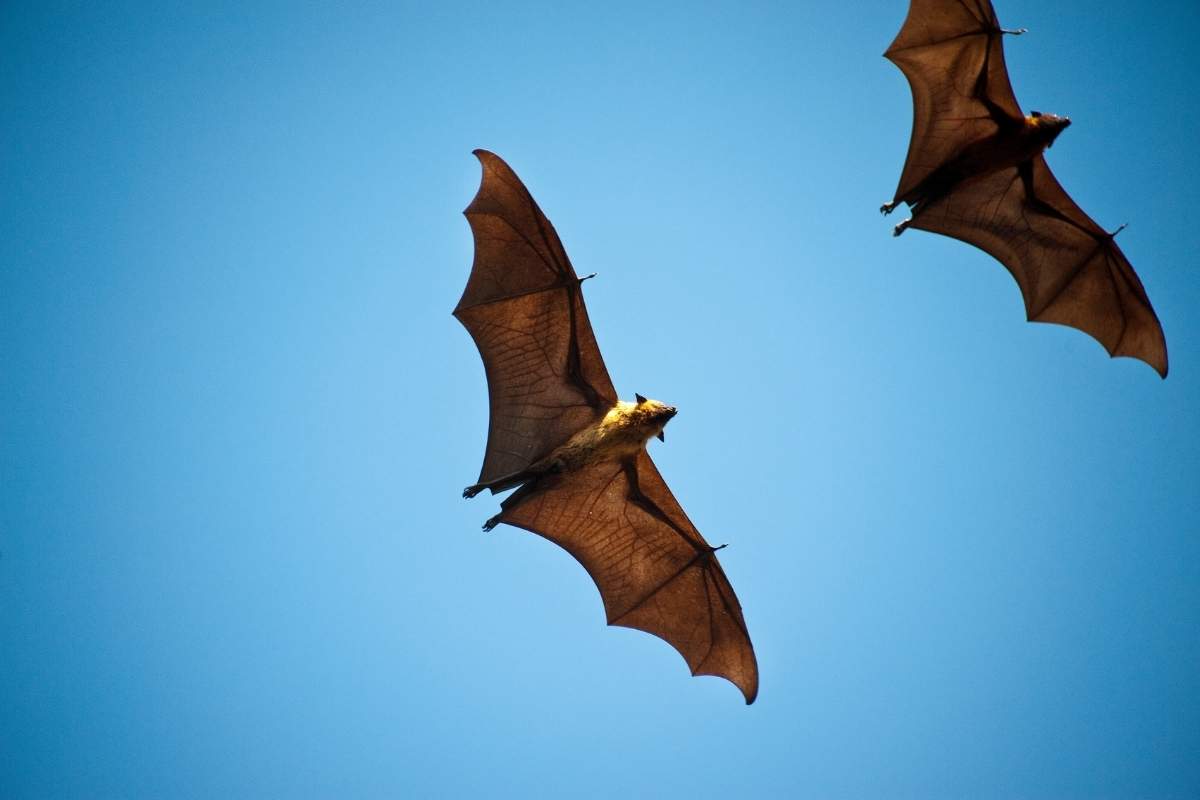
~ Flying foxes, various species of birds and lizards are among the very few land animals endemic to the Maldives.
~ Additionally, Maldives is one of the few places on Earth where whale sharks can be seen all year round.
~ The waters surrounding the islands of the Maldives are home to more than 2,000 different species of fish. The most common frequently seen are whale sharks, bannerfish, anemonefish, manta rays, and Oriental sweetlips.
~ Of the 7 different kinds of marine turtles found in the Maldives, 5 reside in the ocean waters of the islands and include the green turtle, hawksbill, loggerhead, leatherback, and olive ridley turtles.
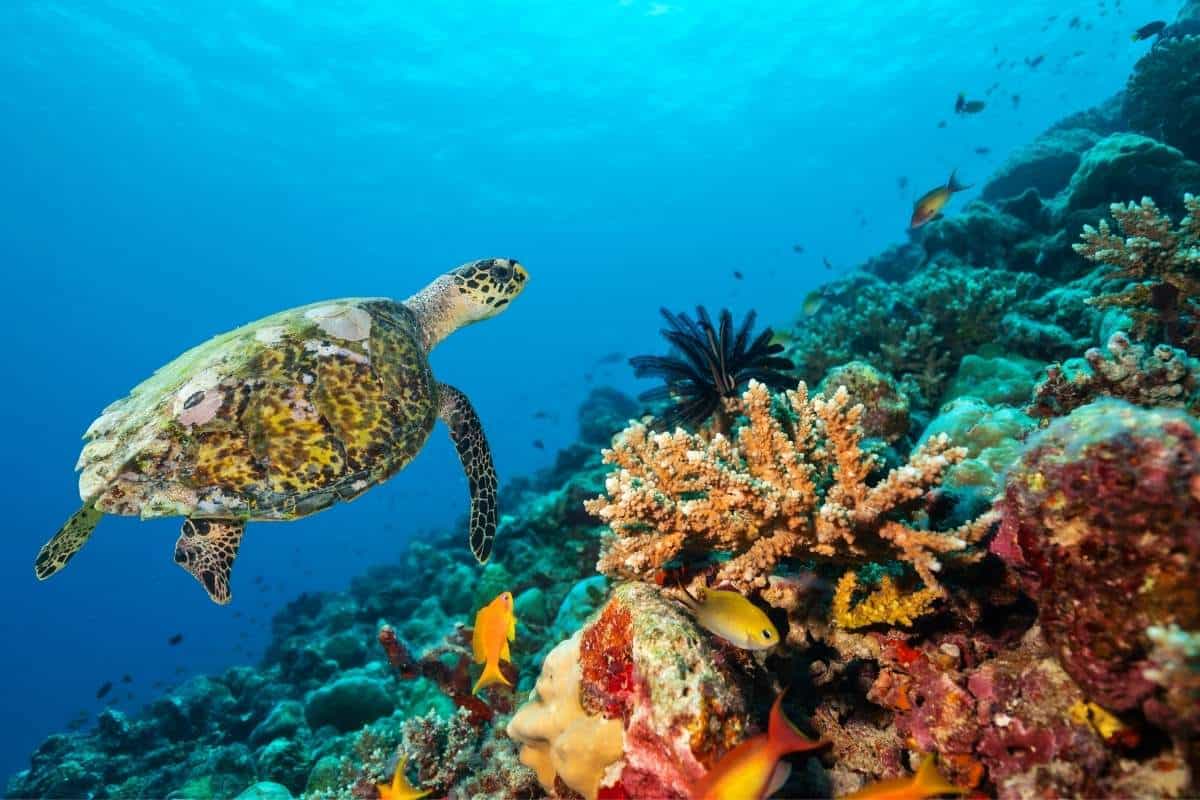
~ A stunning nightly occurrence in the Maldives, glowing plankton or phytoplankton looks like the ocean has glowing stars in the moonlight. High season for spotting the plankton is mid-summer through to winter but it can appear at any time.
~ Maldives’ location in the Indian Ocean made them a perfect trading port between Malaya, Madagascar, Indonesia, China, and many Arab countries in the 10th century.
~ Before the colonization of the now Islamic country, a monarchy ruled the first settlers of the islands. The first kingdom was called Dheeva Maari and the first ruler was Sri Soorudasaruna Adeettiya.
~ Evidence suggests early inhabitants were Buddhist but by 1153 CE, Islam was adopted across the islands when Arab interest in the region became prominent.
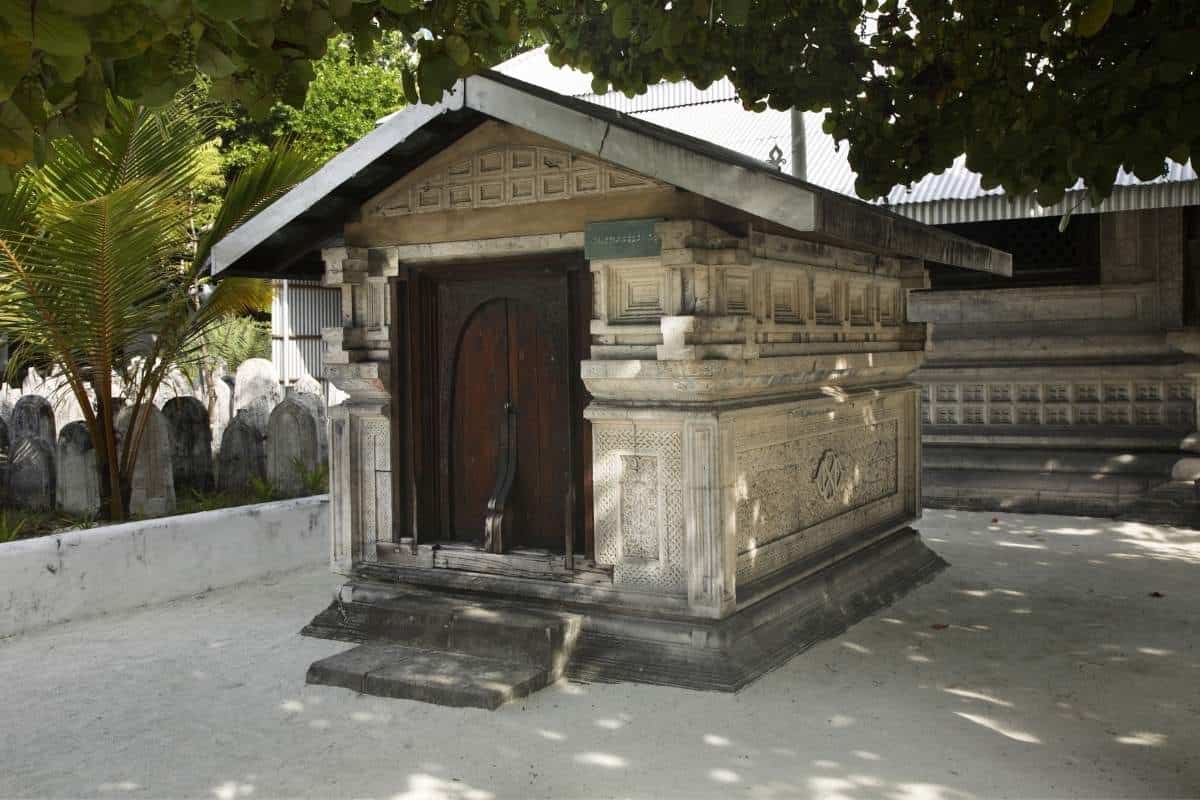
~ During the Maldives’ most significant development period, this island nation was a Buddhist kingdom. The official language of the Maldives, Dhivehi, is an Indo-European language derived from Sanskrit.
~ It is believed that the first settlers of the islands were the Tamil and Sinhalese people from India and Sri Lanka in the 5th century, but the Maldivian ethnic group resulted from settlers from across the globe coming to the Maldives.
~ Traditionally called “King’s Island” where the royal dynasties ruled from the central location, Malé is the capital city of the Maldives islands and lies on the Male Atoll.
~ There is some debate about where the Maldives got its name. Some believe that the name “Maldives” derives from the Sanskrit maladvipa , meaning “garland of islands”, or from “mahila dvipa”, meaning “island of women”. Others believe the name means “palace” (from Mahal in Arabic).
Languages Spoken in the Maldives
~ Because of the long trading history of the island nation, many other languages are commonly spoken in the Maldives, including Arabic, Hindi, and English.
~ The national language of Maldives is Dhivehi, however most Maldivians can speak English with no problems.
~ The Maldives is home to around 5% of the world’s coral reefs. Tourists from all over the globe flock to this tropical paradise for the stunning Maldivian beaches. Many locals can speak and understand languages commonly spoken at the resorts such as French, German, Russian, and Chinese.
~ The islands’ shapes are primarily due to the rings of coral that surround the atolls. Until masonry was introduced to the island in the 18th century, coral was used as a construction material . Large pieces of coral were pulled from the seabed, where they were cut into blocks and then dried out, later to be used in the building of coral houses, mosques, and sculptures.
~ The wood of coconut trees is used to build traditional Maldivian boats called dhonis , which are used as fishing boats, ferries, and cargo ships.
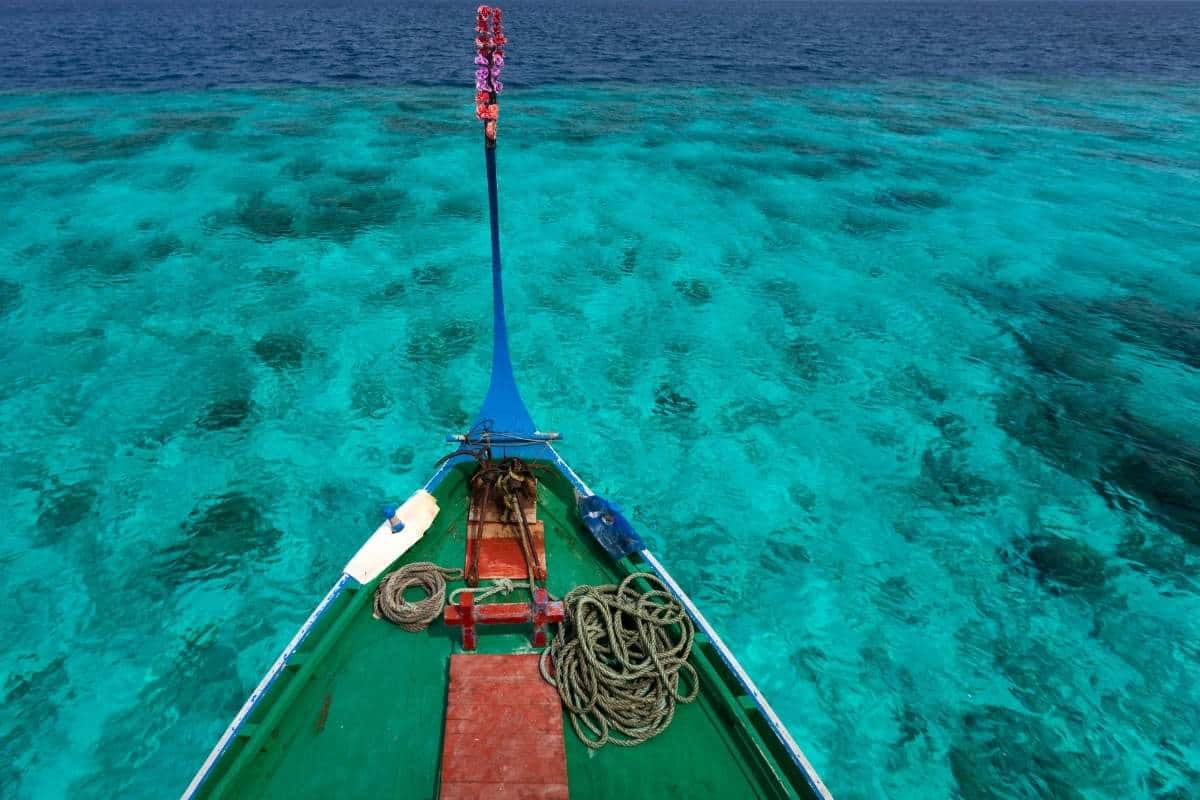
~ The national dish of the Maldives is called gulha and consists of smoked fish, grated coconut, and onions stuffed inside a deep-fried pastry ball.
~ The Maldives’ traditional drums are called Boduberu, which translates to ‘big drum’.
~ Traditional Maldivians used to make their homes out of coral. Some of these homes can still be seen on Malé and local islands.
~ With just 394,500 residents, the Maldives has the smallest population in Asia.
~ Some things that can lead to jail time in the Maldives: homosexuality, alcohol consumption, public displays of affection, and flaunting a swimsuit. The Maldives is a Muslim country so abiding by specific guidelines and respecting the culture is important. Some local islands have more leeway, but the best bet to avoid fines or the lock-up is to head to resorts on a private island.
~ Tourism is the leading industry in the Maldives. Many of the resorts are built on their own islands, giving guests the impression of staying on their own private islands as they sit on the Maldives’ amazing sand underneath the shade of coconut trees. In 2018, a luxury underwater resort opened up in the Maldives where you can spend a weekend unlike any other: from your underwater room, gaze at the coral reefs, watch the diverse marine life swim past, and even sleep right on the sea bed.
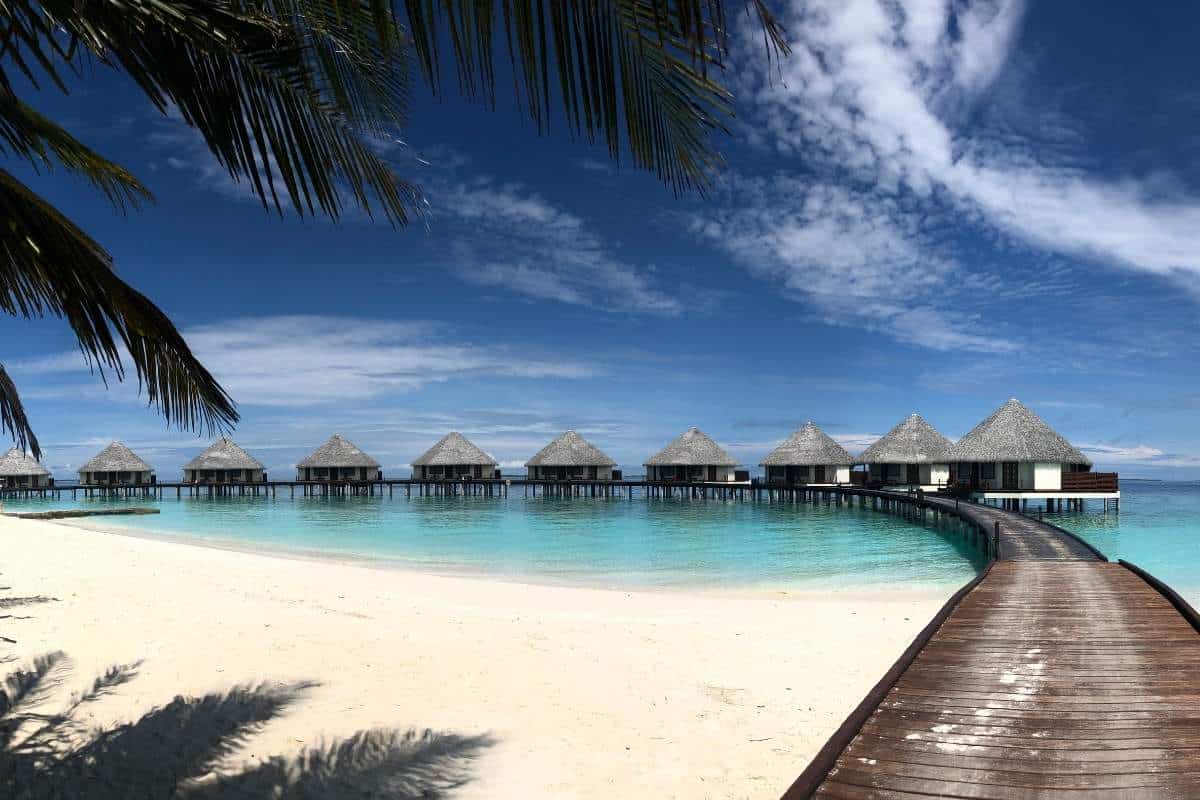
~ Construction is currently underway on a ‘floating city’ located just off the coast of Male, the Maldives’ densely populated capital city. This city will consist of approximately 5000 units and will include houses, businesses, and schools. Residents are slated to begin moving to the floating city in 2024.
~ The currency of Maldives is the Maldivian rufiyaa . Although foreign cash, especially US currency, is generally accepted, especially at the resorts.
~ The Maldivian flag was adopted on July 25, 1965. The Maldives flag displays a white crescent moon in the centre of a green rectangle against a red backdrop. The national tree, the coconut tree, is shown on the Maldivian emblem.
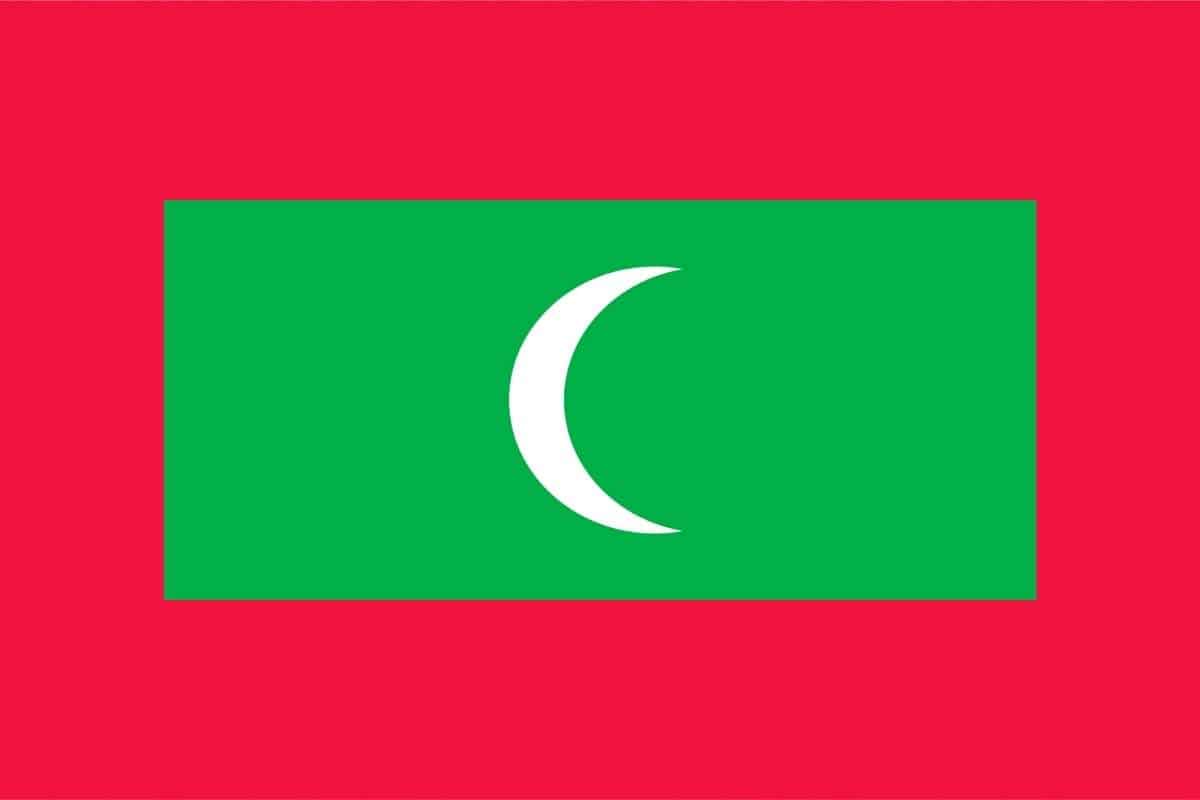
~ The Maldives gained their independence on July 26, 1965. Maldivians established a republic in March of 1968.
~ Now, the Republic of Maldives is a multiparty constitutional democracy with a president representing the party in power chosen through an election.
~ In the backstreets in the middle of Malé, on the grounds of a small mosque, is the tomb of Mohammed Thakurufaanu. He is a national hero in the Maldives due to his hand in liberating the country from Portuguese rule. He was then the sultan from 1573 to 1585.
Facts About Maldives Summary
This article is full of interesting facts about Maldives, and there is still more to uncover! This small but mighty island nation may be the world’s lowest country, but it is packed full of intriguing history and culture.
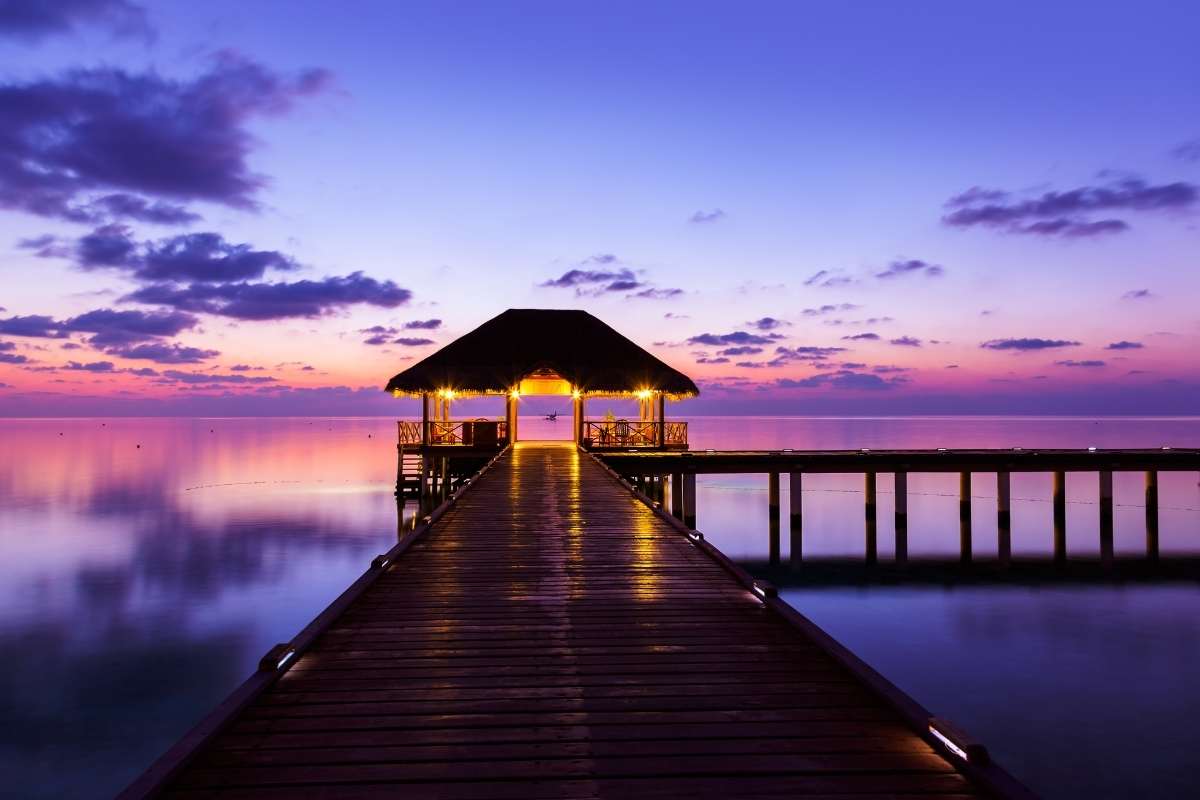
Now that you’ve read the whole post, go test your knowledge in our quiz about the Maldives!
This post was compiled by the Travel Trivia Challenge (TTC) team . TTC was founded by Dalene and Pete Heck who traveled the world non-stop for almost 8 years.
Similar Posts

The Ultimate CANADIAN Trivia Quiz – 100 Questions
This is a monster quiz that will ultimately test your Canadiana!
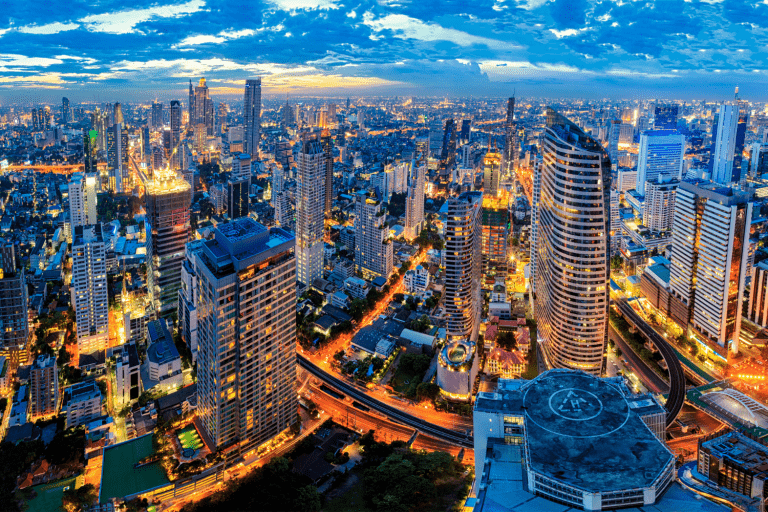
39 Fun Facts About World Capitals
Some quick fun facts about capital cities around the world.

75+ INTERESTING Facts About London, England
So many weird and wonderful facts about London!

50+ FASCINATING Facts About Las Vegas
What happens in Vegas… ends up in our fact post!

Travel Trivia Quiz: Unique Filipino Food
This quiz is ALL about the unique flavors and ingredients in Filipino food.

25+ FUN Facts About Hawaii: Discover the Amazing Aloha State
Aloha! Here are some fun facts about Hawaii.
- New account
Forgot your password?
Lost your password? Please enter your email address. You will receive mail with link to set new password.
Back to login
Top Hotel Collections

Near Maldives
Water Villas
All Inclusive Resorts
Best Hotels
Maldives Travel Packages
Compare quotes from upto 3 travel agents for free
Medhufushi Island Resort Maldives Tour Package - Beach Villa Stay
Holiday inn resort kandooma all inclusive - maldives honeymoon package, taj coral reef maldives package with water villa stay - honeymoon edition, sun island resort & spa - maldives 3 days package, villa nautica maldives paradise island - beach villa stay, maldives honeymoon package half board - reethi faru resort, maldives travel essentials.
Ideal duration: 3-5 days
Best Time: December to April Read More
Visa Policy for All Nationals: Visa on arrival for most countries Read More
Getting In Maldives: Male airport is an international airport and is well connected from most countries in Asia directly or via India or Sri-Lanka or UAE Read More
Planning a Trip? Ask Your Question
"A Tropical Haven For Honeymooners"
Maldives tourism.
The Maldives is an archipelagic state situated in the Indian Ocean known for its luxurious water villas. A tropical haven of white sand beaches, the Maldives is located in the south of Sri Lanka and is ideal for an adventure, honeymoon, or leisure holiday. The Maldives is an archipelago of 1,192 coral islands grouped into natural atolls. However, only 200 islands are inhabited. Each resort generally occupies an entire atoll. Imagine having a room on a pier jutting out from the shore with a glass floor under which manta rays and reef sharks can be seen swimming, and step out from your overwater bungalow to the view of turquoise water.
Comprising of 26 atolls (ring-shaped coral reef that encircles a lagoon), the Maldives is renowned for its incredible diving opportunities, Maldives' azure waters are home to diverse marine life and corals of distinct hues. The capital city of Male is both commercial and financial capital. Seat to the executive, legislature, and judiciary, this city has the most well-connected international airport. The history lovers will be satiated here, given Male houses several buildings and monuments of historical importance. Male is accessible by ferry boats from the international airport. Travel to other islands in the Maldives is also quite feasible from Male due to the excellent ferry and seaplanes connectivity, though it is quite expensive.
Must Know Before You Travel to Maldives
- Speedboats - Ideal for South and North Male Atoll. Located close to the airport (15-40mins). Perfect for catching a flight any time
- Domestic flight+ Seaplane - Ideal for Southern and northern part of Maldives. Lands at a smaller island that connects with a speedboat to another island where resorts are located (above 1 hour - 30-40 min flight +speedboat)
- Seaplane - Ideal for outlying islands. Only operate during daylight hours between 6 AM - 4 PM. Has a frequency of half-hour or 1 hour. If you land in the evening, you need to book one night stay at a hotel on Hulhumale or Male island
- Budget Accommodation - Stay at Hulhumale or Maafushi Island if looking for budget hotels. These islands are also close to Male Airport. There are many other local islands as well, but the ferries will cost around 60 USD per person to reach there. You will have to get in touch with the homestay or hotel owners to help you book seats in the ferry and for the schedule.
- Liquor - It is prohibited to have liquor on Maldivian land. Some hotels in Hulhumale and Maafushi have speedboat which takes you into the water where you can have liquor. Private island resorts have licenses for serving liquors.
- Food - Opt for full board or all-inclusive plans when booking a hotel. The all-inclusive plan has in-house liquor (and in-house activities) while all meal/full board plan has all meals included in the package. Food is generally expensive in the Maldives
- Indian Food - The majority of the resorts in the Maldives have Indian food available
- Card - American Express, Visa, MasterCard, Diners Club, JCB, and Euro Card are accepted almost everywhere in Maldives.
- Green Tax is to be paid by each person (adult & kid both). It is often included in the packages or hotel cost.
- It is illegal to carry corals, shells and other things found in the sea, home from the Maldives
- Importing liquor is prohibited in Maldives
Things To Do In Maldives

Stay in an Overwater Bungalow

Diving in Maldives

Snorkelling in Maldives

Dive with Whale Sharks in Maldives

Candlelight Dinner on Beach

Water Sports
Top Hotels In Maldives
$ 64 onwards
$ 101 onwards
$ 87 onwards
₹ 40 onwards
$ 161 onwards
$ 292 onwards
More on Maldives Travel
Local etiquettes to know before travelling, language of maldives, history of maldives, shopping in maldives, currency in maldives, nightlife in maldives, exchanging money in maldives, best time to visit maldives, top stories about maldives tourism.

Beaches & Islands
Islands of Maldives

Travel Tips
12 Airports in Maldives Listed to Make Your Travel Easier
Most Beautiful Beaches in Maldives

Romantic & Honeymoon
Honeymoon in Maldives Guide - Cost, Best Resorts, Things to Do

Your Go-To Honeymoon Itinerary for the Maldives

Art & Culture
Languages of Maldives: A Complete Guide
Browse Package Collections
Maldives package collections.
Maldives Honeymoon Packages
Maldives Package with Water Villa
Nearby Destinations for Packages
Maldives photos.

+ 48 photos
FAQs on Maldives
What is famous about maldives.
- The Maldives is a safe place to travel for tourists from any country to travel and enjoy.
- It is the perfect place if you are planning your honeymoon or a romantic getaway with your partner.
- Great place for an idyllic and leisure vacation and must go for all history lovers, or if you are just looking to spend some peaceful time by the ocean.
- Most people converse in English making it easy to communicate.
What is not so good about Maldives?
- The Maldives does not serve alcohol to the locals, however, if you are a non-Muslim and above the age of 18, liquor will be served at some of the hotels but it will be at quite an exorbitant price.
- Accommodation, food as well as travel are also quite expensive.
- It is also recommended that you refrain from showing affection on the street since it is frowned upon and the country does not encourage the public display of affection.
- Friday and Saturday is considered as a weekend
Who should visit Maldives?
What is the best time to visit maldives, what is the local food in maldives, how much does a package cost for maldives, what are the things to do in maldives, what are the places near maldives, have a question on maldives.

Popular Questions And Answers on Maldives
Q. Prices for a couple?
krishna vamsi
Q. What is the average price to visit Maldives for 3days ???
Q. I want Maldives Honeymoon package
Kavya sreekumar
Maldives Reviews
Rohit Shroff
Banwari patidar
Taniya Batra
Similar Places

Get the best offers on Travel Packages
Compare package quotes from top travel agents
Compare upto 3 quotes for free
- India (+91)
*Final prices will be shared by our partner agents based on your requirements.
Log in to your account
Welcome to holidify.
Forget Password?
Share this page
Maldives Travel Guide
Popular destinations, san francisco, new york city.
- Terms of Use
- Privacy Policy
- Your US State Privacy Rights
- Children's Online Privacy Policy
- Interest-Based Ads
- About Nielsen Measurement
- Do Not Sell or Share My Personal Information
- Nat Geo Home
- Attend a Live Event
- Book a Trip
- Inspire Your Kids
- Shop Nat Geo
- Visit the D.C. Museum
- Learn About Our Impact
- Support Our Mission
- Advertise With Us
- Customer Service
- Renew Subscription
- Manage Your Subscription
- Work at Nat Geo
- Sign Up for Our Newsletters
- Contribute to Protect the Planet
Copyright © 1996-2015 National Geographic Society Copyright © 2015-2024 National Geographic Partners, LLC. All rights reserved

24 Utterly Interesting Facts About Maldives Tourism You Must Know Before You Go
Of course, you have learned much on the web about why the Maldives is a famous luxury destination, which has deepened your fascination with it. But how much do the travelers actually know about the Maldives? For instance, the world’s first underwater cabinet meeting was held in the Maldives. Out of 1,2000 islands, only 200 are inhabited. Some resorts play by their own vacation-friendly rules like barefoot policy. Simultaneously, Maldives produces one ton of white sands annually. Unknown to many, Maldives has earned the Level 2 threat level tag from the US State Department. Are you still wondering why Maldives does live up to every single expectation?
Here we propose some more utterly fascinating facts about Maldives that act as a catalyst in tourism.
24 Interesting Facts About Maldives Tourism
1. maldives sits on the equator.
This means that sun rays in Maldives get sprinkled at a 90-degree angle . In a nutshell, the sun rays are direct, and hence it is strong; guests must put on some sunscreen to protect themselves from the ultraviolet rays wherever they explore on the island. We strongly suggest you purchase reef-safe sunscreen on your Maldives vacations.
2. Expect to Pay Higher Costs of Even the Shortest Sea Plane Ride
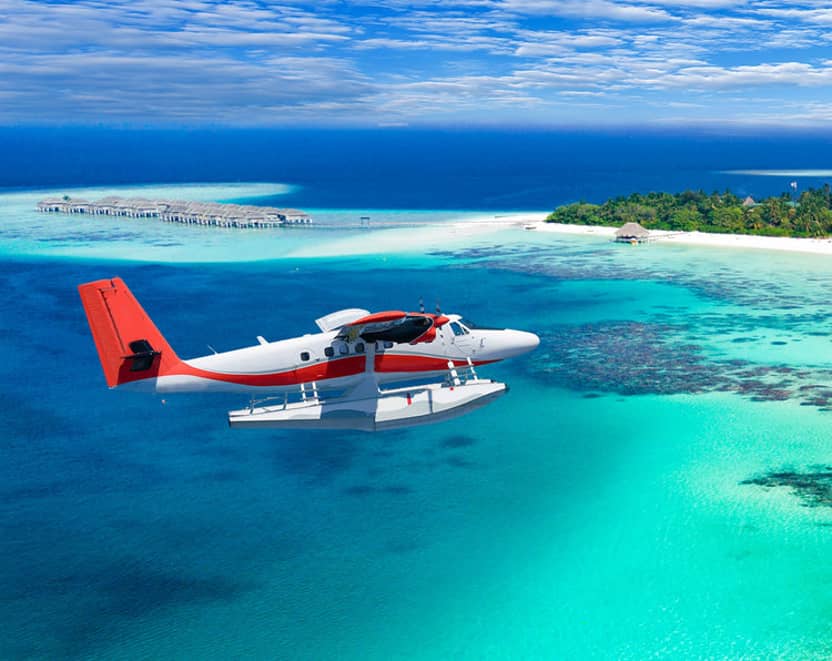
This archipelagic country in the Indian Ocean is made for travelers who want to splash their cash. One such luxury in the Maldives is a seaplane ride. Even the shortest seaplane ride in Maldives from Male is an expensive affair. It is because the seaplane mode of commute in Maldives is taken during the time of private island resort transfer.
Read Also: Places to visit in Maldives for honeymoon
3. Divorce Rate is High in the Honeymoon Capital of Asia
Touted to be one of the best honeymoon destinations in Asia for tropical island vacations – thanks to its sugar sandy beaches, overwater bungalows, Maldives is synonymous with honeymoon capital. But the irony is United Nations reports state that Maldives has the highest divorce rate, almost twice the United States (annually). On average, official records state that the woman in the Maldives has divorced thrice before she reaches 30 years.
Read Also: Things to do in Maldives
4. Moving Sandbanks in Maldives Are Mother Nature Allure
Guests can watch the ocean move and recreate the white sandbanks according to their will. Even a few islands’ shapes in the Maldives can be modified and seen. Not many people know about the Maldives, watching sandbanks shifting by nature and being brought back by seasonal currents during the wet season.
5. Shark Tourism in Maldives is on Rise
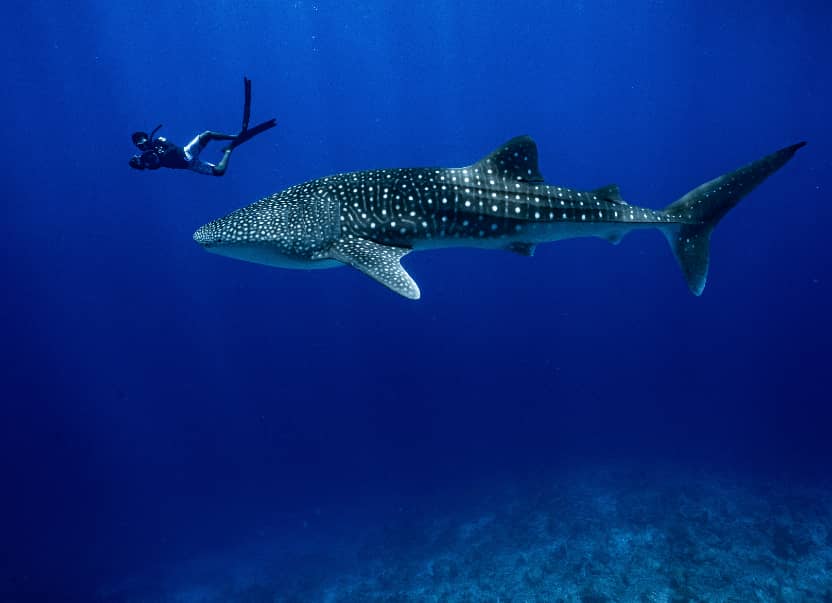
Some of the world’s largest whale sharks are found in Maldives because sharks are found in abundance. This archipelago allows tourists to witness whale sharks year-round on snorkeling, scuba diving, glass-bottom boat ride adventure under experts’ supervision.
Read Also: Best Beach Villas for Couples in Maldives
6. World’s First Underwater Cabinet Meeting Was Held in Maldives
It was 17 October 2009, when the Maldivian President – Mohammed Nasheed asked his cabinet ministers to chat under the sea bed. The meeting was held in Gilifushi to hold international attention regarding the issue of global warming in the island nation due to the rising sea levels.
7. Crime Rates Are Low in Maldives
And hence, Maldives tourism brags itself as one of the safest places on the earth for all types of vacations, including family trips, honeymoon tours, couple getaways, and leisure vacations.
8. Maldives is Melting Pot of Culture
However, the official tourism website of Maldives says that the nation follows Sunni Islam, but you will natives from Sri Lanka, Malaysia, African, and Indonesia avenues. You, too, can discover this heady blend of culture on Maldives vacations. To learn about traditional Maldivian life, visit the local islands in Maldives. African, European, Arabian used the Maldives as the crossroad of trade during the ancient time.
9. The Traditional Multi-Purpose Maldivian Boat (Dhoni)
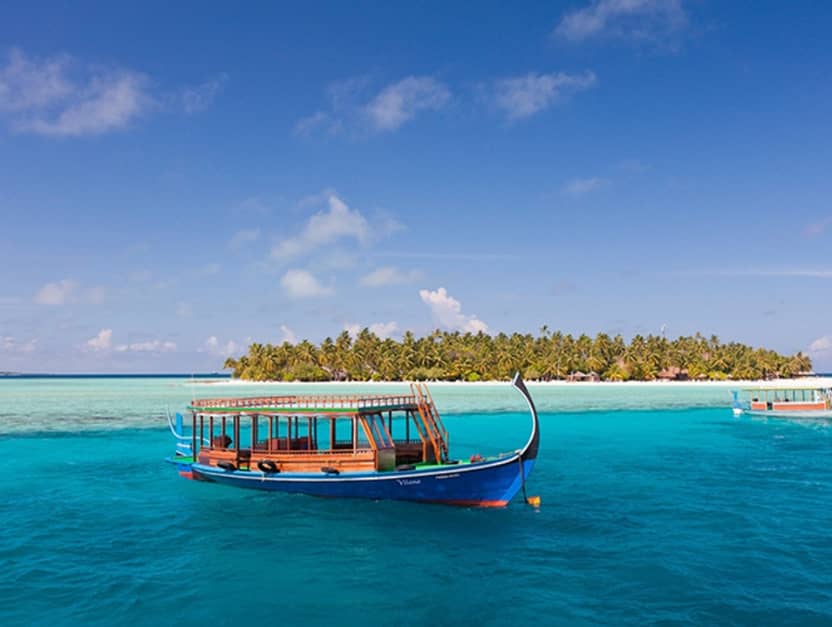
As per the records, Maldives’ famous traditional Maldivian boat (Dhoni) design was inspired by the Arabian Sailing Dhow during the erstwhile days. Those were the same ships used for trading in the Indian Ocean dating back to the 11th century.
10. Not Every Island of Maldives is Inhabited
There are 1,200 islands (approx.) in the Maldives peppered across the Indian Ocean. Some of them are private island resorts, while the rest of them are locally inhabited islands. At the same time, there are many non-inhabited islands in Maldives where tourism is not allowed.
11. Some Maldives Islands Are Artificial
This signifies that not all the islands in Maldives are naturally formed. For instance, Hulhumale Island is a man-made island close to the Male and is often replicated as an artificial island formed by the dumping loads of sands during 2004 . Now tourism flourishes here as an incredible coastline, paved roads have been made by the Maldives government.
Read Also: Best Island in Maldives for honeymoon
12. Maldives is one of the Best Places on Earth to Watch Bioluminescence.
It doesn’t matter if someone is a beach lover or not; the views of glowing beaches in the Maldives will definitely inject a shot of wanderlust in the veins of the travelers. Bioluminescence in the Maldives is one of the rarest treats formed due to the chemical reaction in marine living bodies.
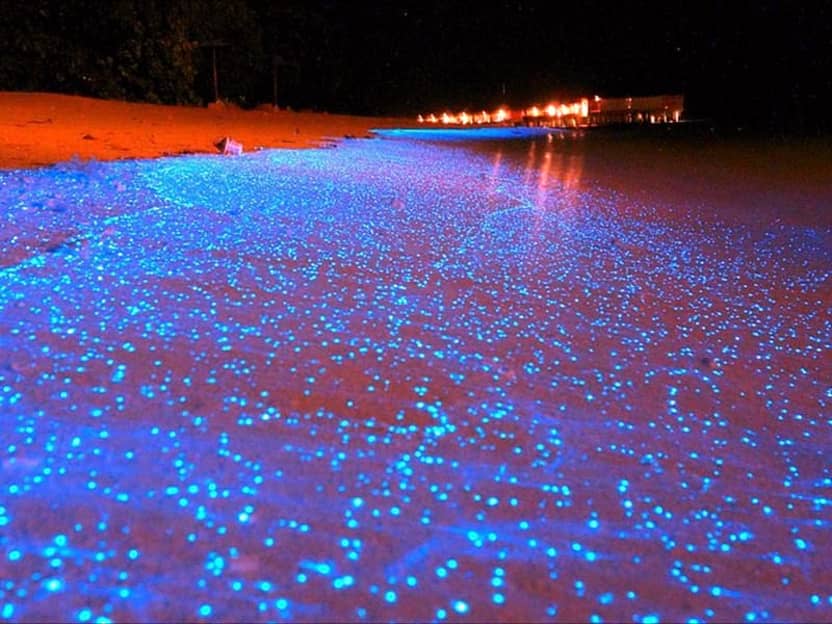
The sight of the night sky falling under your feet is a sight to behold for couples on Maldives honeymoon.
13. Public Affection is A Strict No in the Maldives + No Alcohol.
It is because the population of Maldives is Muslim. You can’t flaunt your swimsuits and display public affection in the local islands of Maldives. Doing the same would land you in trouble. Maldives also prohibits alcohol consumption on the private island resort. Additionally, homosexuality is a punishable offense in this Indian archipelago. However, local islands have bikini beaches, but it is best to switch to private island resorts with no such restriction on boozing and flaunting your bikini suites.
14. Flag of Maldives Has A Story to Tell
The national flag of Maldives has 3 colors – green, white, crescent, red. The first one symbolizes peace, the second one symbolizes Islam religion, while the Red color is the homepage of the freedom fighters of the Maldives whose blood gave independence.
15. There are Two Monsoon in the Maldives
Maldives have two monsoon seasons – southwest and northeast monsoon. The former commences from May to October and September’s wettest month. While the latter one is mild and starts from mid-November to December.
16. Spring is the Best Time for Maldives Vacations
Maldives is a year-round destination because of its tropical climate. But if some want guaranteed sunshine, January to March is the best time to go to the Maldives. These months constitute the spring season that starts and ends from November to April.
17. Wet Season in Maldives is Not Harsh
Yes! Like the neighboring countries, Maldives’ wet season is not that rough. Travelers can enjoy watersports at a safe point since Maldives water is shallow because of the atolls and lagoons.
18. Sailors from Indian Ocean Region Introduced BoduBeru Dance
Bodu Beru is a local music and dance show accompanied by a wood drum made from the coconut tree trunk. The Inhabitants of Maldives believed that the BoduBeru concept was started by the sailors from the Indian Ocean. Almost every second resort in Maldives – mainly local inhabited islands like Male, Hulhumale.
Read Also: Water Sports Activities in Maldives
19. Shells Money of Maldives Dates Back to Centuries
Tourists can find cowry shells in Maldives almost everywhere. Cowry shells were the erstwhile mode of money used as currency, mainly in the Indian Ocean sharing countries. These shells now ornate the Maldivian coins, which are a treasure to watch at the various museums in Maldives.
20. The Ancient Maldivian People Used to Build Residences in Corals
One of the astonishing facts about Maldives is that local Maldivians in their heyday used to build their residences in corals. On their Maldives tour package, guests can still see coral houses in the local inhabited islands like Male, Hulhumale, etc.
21. Maldives Has Very Limited Availability of Freshwater
Another geographical fun fact about the Maldives is that the country has different drinking water. By this, we mean to say that this archipelagic country in the Indian Ocean is highly vulnerable to climate changes, and hence, limited freshwater in Maldives is the talk of the town. Travelers on their Maldives trip will learn about water conservation at Kandolhu Island. The same island makes water safe for drinking through the osmosis process.
Read Also: Best Resorts in Maldives for honeymoon
22. Coconut Trees of Maldives Are Strong & Lives Long
One of the fun facts about Maldives is that the coconut trees fringed around the white sandy beaches have an average age of 100. Moreover, these coconut trees are an important feature of the Maldivian emblem. The same can grow approximately upto 30 m. lastly, the wood of the coconut trees in the Maldives is widely used to make traditional Maldivian boats – Dhonies from the heydays.
23. Marine Wildlife of Maldives is Bewitching
Tourists would be surprised to know that apart from exotic underwater fauna wildlife, there are many land animals too in Maldives. For instance – flying boxes, cats, deers, elephants. While the marine wildlife of Maldives is the real tourism booster is the local islands and private islands. On the other hand, the underwater marine world of Maldives displays clownfish, jellyfish, parrotfish, pink whip rays, and zebra sharks.
24. Maldives On Budget is Possible
You just need to sort your travel plans, accommodation style, number of traveling days and let Tourism of India do the hard work for you! We have some of the best-selling Maldives vacation packages with flights and all-inclusive resort activities right from meals to stay, experiences, and watersports.
Wrapping Up Interesting Facts About Maldives Tourism
There is a lot to learn about Maldives tourism, For instance, tourism in the Maldives opened up around 40 years ago! 99% of the Maldives are swallowed by water .
Maldives is a perfect place to quench those pesky fantasies that demand you to quit your monotonous life and jet set to the tropical island bliss. The private island resorts, local islands, sandbanks, powdery sands, and bright blue water beaches actually live up to the expectations of the honeymooners, family travelers, and leisure travelers.
We hope our list of interesting facts about Maldives tourism gave you a sneak peek into what this archipelagic country is like and what to expect.
If these facts about Maldives fascinate you, share the blog with your friends so that they can learn about this amazing country.
Akshay Negi
Copywriter with eagle eyes who writes copies backed by market research. Akshay uses the persuasive power of NLP to influence readers. Maybe that’s the reason why Akshay became a writer the way other people became monks and nuns. His approach geeks out on studying the personas of the human mind. Thrill yourself from head to toe by feeding your hunger for more travel-related content written by him.
Related Posts

How to Apply: Kailash Mansarovar Yatra Registration Online and Offline 2024
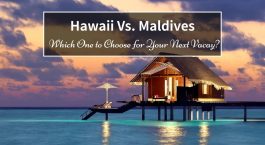
Hawaii Vs. Maldives: Which One to Choose for Your Next Vacay?
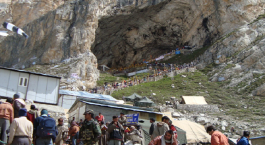
Amarnath Yatra Tips: Do’s and Don’ts During Yatra
Save my name, email, and website in this browser for the next time I comment.
7 of the best places to visit in the Maldives
Feb 27, 2024 • 5 min read

Experience the best of the Maldives with these unmissable places to visit © Thomas Barwick / Getty Images
The fabulous diversity of the Maldives means there’s an island for every type of tourist, from budget travelers to adrenaline junkies who dream of exploring beneath the waves.
So whether you’re a first-time visitor on honeymoon or coming back again to gain a deeper insight into the region, here are our picks of the must-visit destinations in the Maldives.

1. Raa Atoll
Best for the diverse marine life
The Raa Atoll, a 45-minute seaplane journey from Male ’s Velana International Airport, comprises 88 islands. Its diverse marine life, combined with its proximity to the UNESCO Baa Atoll Biosphere Reserve , makes it a great destination for divers, many of whom come to see the manta rays that head to this part of the Indian Ocean to raise their young.
Raa Atoll resorts worthy of a spot on your bucket list include Heritance Aarah , which has fantastic sustainability credentials as the Maldives’ first LEED (Leadership in Energy and Environmental Design) Gold resort. It’s also got a brilliant on-site museum, where various artifacts and a replica of a traditional Maldivian village provide a wonderful insight into the region’s history.
Additionally, the Cora Cora Maldives resort has a dive school that offers a huge range of qualifications, including Bubblemaker courses for children who fancy heading beneath the waves for the first time.
2. The Fari Islands
Best for luxury
A new concept for the Maldives, the North Male Atoll’s Fari Islands development currently comprises two resorts. The Patina Maldives attracts a young stylish crowd with its minimalist over-water villas designed by Studio MK27 and a boutique filled with clothing curated by fashion magazine The Rake . There's also a huge focus on art, the highlight of which is American artist James Turrell’s Skyspace , a hollow wooden structure that affords unique views of starry night skies.
At the Ritz-Carlton Maldives , butler service comes as standard, and youngsters are kept occupied by the enormous video console-filled kids club. In 2025, a third resort, the Capella Maldives , will be added.
3. Crossroads
Best for the range of accommodation
Crossroads is another multi-resort complex, and it was one of the first in the Maldives. It’s also a destination in its own right – in addition to the Hard Rock Hotel Maldives , Saii Lagoon Maldives and SO/ Hotel Maldives , there’s a beach club and marina. Its proximity to Male’s Velana International Airport – it’s just a 15-minute speedboat ride away – means visitors whose seaplane flights are delayed (a regular occurance, given seaplanes are unable to fly at night) no longer have to stay in the notoriously basic hotels in the center of Male, but can head to one of Crossroads’ three resorts, instead.
Planning tip: Got a painfully early flight home after your holiday? Rather than spending your final night in Male, where there are limited hotels, book a night at one of Crossroads’ hotels instead.

4. Baa Atoll
Best for wildlife-spotting excursions
Baa Atoll is another popular destination for divers, snorkelers and anyone keen to check out the region’s marine life. This is where you’ll find the UNESCO-listed Baa Atoll Biosphere Reserve, home to one of the Maldives’ largest coral reefs and a magnet for a wide range of species. Many visitors come to this atoll to spot manta rays – it’s home to Hanifaru Bay, where thousands of the creatures regularly gather to feast on plankton carried here by the Indian Ocean’s currents. We recommend booking a stay at Vakkaru Maldives , which offers big five diving safaris designed for guests hoping to see manta rays, whale sharks, turtles, dolphins and blacktip sharks, all of which thrive here.
Planning tip: If spotting mantas is a priority, aim to visit the Baa Atoll between June and November .
5. Laamu Atoll
Best for remoteness
One of the least developed atolls, Laamu in the southern Maldives is known for its lush vegetation, palm-fringed beaches and fabulously clear night skies (several resorts here have in-house astronomers). There’s just one resort on this atoll – the Six Senses Laamu , which is one of the best Maldives resorts for marine life due to its collaborations with the Manta Trust , Blue Marine Foundation and Olive Ridley Project , founded to protect endangered turtle species. A large number of liveaboards (boats with onboard accommodation for divers keen to visit multiple atolls) operate here.

6. Local islands
Best for culture vultures
There are hundreds of so-called "local islands" in the Maldives – islands which aren’t home to resorts, but local communities of Maldivians, many of whom work as fishers. While certain resorts offer day trips to local islands, it’s also possible to stay on one, in homestay-style accommodation owned by locals. These include Maafushi , which is connected to Male via a regular ferry service; Fulhadhoo, which is a two-hour speedboat ride from Male and located on the wildlife-rich Baa Atoll; and the Ari Atoll’s Hangnaameedhoo, surrounded by a beautiful coral reef.
A stay on one of these islands doesn’t just offer brilliant value for money (expect to pay between US$30 and US$60 for a night in a guesthouse) but a fantastic insight into the Maldivian way of life, and many guesthouse owners will happily arrange visits to island schools or excursions with local fishers.
7. Fairmont Maldives Sirru Fen Fushi
Best for sustainability
The Green Globe-certified Fairmont Maldives Sirru Fen Fush i is one of numerous Maldives resorts going all out when it comes to sustainability, but we’re flagging this particular property because it’s the one many resorts look to as inspiration. In the on-site sustainability lab, various pieces of hi-tech kit – including an extruder, which turns pellets made from marine waste into a range of products including furniture – allow staff to recycle more plastic than any other resort. It’s not just employees turning trash into treasure, either – during regular workshops, guests can make items such as earrings and toys from waste plastic. The resort also has a turtle ranger project, the Coralarium, which acts as an artificial coral reef, and an osmosis facility that allows the resort to generate its own water supply, eliminating the need for plastic bottles.
This article was first published Nov 8, 2021 and updated Feb 27, 2024.
Explore related stories

Art and Culture
Mar 4, 2024 • 4 min read
Ramadan Mubarak! Here's everything travelers need to know about visiting Muslim-majority places during Ramadan.

Feb 22, 2024 • 5 min read

Feb 8, 2024 • 5 min read

Feb 7, 2024 • 6 min read

Jan 17, 2024 • 8 min read

Jan 2, 2024 • 8 min read

Dec 15, 2023 • 7 min read

Oct 29, 2023 • 6 min read

Oct 15, 2023 • 3 min read

Aug 31, 2023 • 11 min read
Travel Information
International telephone code, electricity, mobile services, travel and transfer, medical services.
What are you looking for?

Four nights in the Maldives taught me something I wish I'd known 10 years ago
T echnicolour sunsets. Swaying palm trees. Shimmering water that feels like stepping into a bath. Time and space to sit back and do… nothing.
It sounds like paradise, but until I spent four nights in the Maldives , it was my idea of holiday hell.
I love to travel, and am lucky enough to do so more than most. But my usual itinerary looks a lot more like 30,000 steps a day, storming through as many historical sights as opening hours allow than vegetating horizontally on a sun lounger.
Before the Maldives, I’d most recently been to Uzbekistan , driving seven hours across the Kyzylkum desert and scaling secret tunnels in the belly of a Central Asian mosque.
So when I was given the chance to visit one of the 1,192 pristine sandbanks that make up this Indian Ocean haven, I felt anxious. What on earth was I going to do in an all-inclusive resort that you can walk from top to bottom in 15 minutes?
It’s safe to say I’ve always struggled to unwind. And if you told me that half a week on a tiny island in the South Nilandhe Atoll would finally teach me the joy of relaxation, I wouldn’t have believed you.
But it did — and it’s changed my idea of the perfect holiday forever.
First impressions
As we touched down in the densely-populated Maldivian capital Malé, I wondered how quickly I would devour the books I had hauled halfway across the world. And what would I do then? Lie alone with my thoughts?
My anxious brain was already fretting about where it would take me with little distraction but sun, sea and sand as we boarded a seaplane that would fly us 145km south to Sun Siyam Vilu Reef, a five-star resort built on a coral reef.
I needn’t have worried. The 35-minute journey alone is enough to fill your head with awe and serotonin. Crewed by the barefoot pilots of Trans Maldivian Airways, we soared over turquoise ocean speckled with white sand banks and the familiar outline of the Maldives’ iconic accommodation: overwater huts.
My fear of boredom had started to dissolve into the azure waves by the time we landed at our destination, where we were greeted with juice-filled pineapples and a chauffeured golf buggy that took us to the villa that would be our home for the next four days.
The setting was otherworldly, with crystal clear water lapping against the shore and soft yellow sand glistening in the sun. But what struck me more than anything was the welcome from our ‘island hosts’, Erika and Mohammed, who must greet dozens of guests each week but still managed to make us feel like the first.
Behind the door of the villa lay luxury I’d never experienced before, with a cavernous bedroom backing onto a huge walk-in wardrobe, and a Jack and Jill bathroom (two sinks!) looking out on a terrace where a sparkling infinity pool flowed into the sea.
As the day wore on the clear blue sky became mottled with pink, melting into a candy-hued sunset of orange and purple that I know I’ll remember for the rest of my life.
If you asked ChatGPT to show you heaven, I thought, this is what it would give you. Why was I so worried about coming here to do nothing?
The joy of doing nothing
It didn’t take long for me to realise I’d got the Maldives – and my presumption of sun, sea, and sweet all else – spectacularly wrong.
After hours flip-flopping from pool to ocean, I’d worked up enough of an appetite to try a smorgasbord of dishes from one of the island’s three restaurants. An eclectic menu caters to every palette, with freshly caught tuna sashimi to start, Maldivian curries laced with chilli and dried fish for main, and an array of cakes, creams and fruit to finish.
From the first bite, I became obsessed with masmirus , a Maldivian sambal of dried tuna, garlic, ginger and chilli. I drizzled it over everything, relishing the spicy kick as I stared out from the restaurant deck onto the ocean that seemed to stretch on for eternity.
At first it felt strange to spend hours over dinner, just enjoying the view. But I soon felt as though I’d missed out on more than I’d realised on previous trips, barrelling about like a roadrunner, desperate to fit too much in. Terrible conflict plagues so much of our world right now that it’s hard not to feel overwhelmed by the darkness. In those moments, looking out over the gently lapping waves, I felt so lucky to be somewhere that feels so at peace.
Plenty to do in paradise
But even if you can’t get on board with sitting back and drinking it all in, icy cocktail in hand, you won’t be short of things to do in the Maldives. There’s plenty to do for every preference, from wine tasting and hot stone massages, to diving trips where you’ve more than a good chance of coming face to face with a whale shark.
Jet skis can be rented as well as flippers and masks, perfect for ocean lovers to explore the nearby reef. My favourite moment was a group snorkelling tour, where we sailed about 30 minutes from the island and swam next to giant sea turtles and a cornucopia of colourful fish.
A sunset cruise where dolphins put on an enthralling performance, flipping and twirling above the waves, is something I will always feel privileged to have seen.
If that slaps the brakes on your Maldives travel plans, don’t panic – there are plenty of budget-friendly places to stay, too. Since 2009, the Maldivian government has allowed independent guesthouses to open on non-resort islands, where rooms can cost as little as £25 per night. Airbnb also operates in the Maldives, as does the Couchsurfing community, with about 2,000 active hosts spread across the 1,192 islands.
For the cheapest deal, travel experts advise booking from May to September. And they say you shouldn’t be discouraged that it’s billed as the wet season — rain showers are infrequent and almost always short.
As we boarded a seaplane to carry us back to Malé and the mundanity of reality on our final morning, the sun was rising over the undulating horizon. I felt calm and overwhelmingly grateful to have spent four days in such a unique and extraordinary paradise.
There’d been no real itinerary. No bustling city streets with 9 bars to choose from. No imposing buildings that have stood for thousands of years and weathered multiple wars. But I’d never enjoyed a holiday more.
Which Sun Siyam Resort is for you?
Metro.co.uk spoke to Sun Siyam Resorts UK travel marketing director, Angie Sloan, about what each Maldivian resort has to offer. And Angie is a woman who knows, having been to each destination many times!
- For action, adventure and adrenaline hits, Angie says you can’t look past Siyam World , which offers a plethora of high-octane activities including go-karting, horse riding, a full-size international football pitch and the world’s first underwater jet-pack.
- If you’re looking to be pampered, Angie recommends the award-winning Sun Siyam Iru Fushi , home to The Spa by Thalgo France which has a menu of over 160 treatments.
- Best for affordable luxury is the multi-island Sun Siyam Olhuveli , says Angie. Just a 40-minute speedboat ride from Malé, it has access to some incredible snorkel and dive sites – including shipwrecks!
- For romance, anniversaries and special occasions, Angie’s go-to is Sun Siyam Iru Veli . Reviewers on TripAdvisor seem to agree, with dozens of travellers calling their time there ‘unforgettable’.
- Finally, if you’re simply after world-class cuisine, Angie says it’s tough to choose between Sun Siyam Iru Fushi and Siyam World . Both have 16 and 18 restaurants and bars respectively – take your pick.
Alice Murphy was a guest of Sun Siyam , at Sun Siyam Vilu Reef.
Etihad flies from London Heathrow to Velana International Airport with a stop in Abu Dhabi from £642 return; Qatar Airways flies from London Heathrow with one stopover in Doha from £773.
For even more unmissable travel news, features and inspiration in your inbox each week, sign up to Metro's The Getaway newsletter

NEWS... BUT NOT AS YOU KNOW IT
Four nights in the Maldives taught me something I wish I’d known 10 years ago

Share this with

Technicolour sunsets. Swaying palm trees. Shimmering water that feels like stepping into a bath. Time and space to sit back and do… nothing.
It sounds like paradise, but until I spent four nights in the Maldives , it was my idea of holiday hell.
I love to travel, and am lucky enough to do so more than most. But my usual itinerary looks a lot more like 30,000 steps a day, storming through as many historical sights as opening hours allow than vegetating horizontally on a sun lounger.
Before the Maldives, I’d most recently been to Uzbekistan , driving seven hours across the Kyzylkum desert and scaling secret tunnels in the belly of a Central Asian mosque.
So when I was given the chance to visit one of the 1,192 pristine sandbanks that make up this Indian Ocean haven, I felt anxious. What on earth was I going to do in an all-inclusive resort that you can walk from top to bottom in 15 minutes?
It’s safe to say I’ve always struggled to unwind. And if you told me that half a week on a tiny island in the South Nilandhe Atoll would finally teach me the joy of relaxation, I wouldn’t have believed you.
But it did — and it’s changed my idea of the perfect holiday forever.

First impressions
As we touched down in the densely-populated Maldivian capital Malé, I wondered how quickly I would devour the books I had hauled halfway across the world. And what would I do then? Lie alone with my thoughts?
My anxious brain was already fretting about where it would take me with little distraction but sun, sea and sand as we boarded a seaplane that would fly us 145km south to Sun Siyam Vilu Reef, a five-star resort built on a coral reef.
I needn’t have worried. The 35-minute journey alone is enough to fill your head with awe and serotonin. Crewed by the barefoot pilots of Trans Maldivian Airways, we soared over turquoise ocean speckled with white sand banks and the familiar outline of the Maldives’ iconic accommodation: overwater huts.
My fear of boredom had started to dissolve into the azure waves by the time we landed at our destination, where we were greeted with juice-filled pineapples and a chauffeured golf buggy that took us to the villa that would be our home for the next four days.
To view this video please enable JavaScript, and consider upgrading to a web browser that supports HTML5 video

The setting was otherworldly, with crystal clear water lapping against the shore and soft yellow sand glistening in the sun. But what struck me more than anything was the welcome from our ‘island hosts’, Erika and Mohammed, who must greet dozens of guests each week but still managed to make us feel like the first.
Behind the door of the villa lay luxury I’d never experienced before, with a cavernous bedroom backing onto a huge walk-in wardrobe, and a Jack and Jill bathroom (two sinks!) looking out on a terrace where a sparkling infinity pool flowed into the sea.
As the day wore on the clear blue sky became mottled with pink, melting into a candy-hued sunset of orange and purple that I know I’ll remember for the rest of my life.
If you asked ChatGPT to show you heaven, I thought, this is what it would give you. Why was I so worried about coming here to do nothing?

The joy of doing nothing
It didn’t take long for me to realise I’d got the Maldives – and my presumption of sun, sea, and sweet all else – spectacularly wrong.
After hours flip-flopping from pool to ocean, I’d worked up enough of an appetite to try a smorgasbord of dishes from one of the island’s three restaurants. An eclectic menu caters to every palette, with freshly caught tuna sashimi to start, Maldivian curries laced with chilli and dried fish for main, and an array of cakes, creams and fruit to finish.
From the first bite, I became obsessed with masmirus , a Maldivian sambal of dried tuna, garlic, ginger and chilli. I drizzled it over everything, relishing the spicy kick as I stared out from the restaurant deck onto the ocean that seemed to stretch on for eternity.
At first it felt strange to spend hours over dinner, just enjoying the view. But I soon felt as though I’d missed out on more than I’d realised on previous trips, barrelling about like a roadrunner, desperate to fit too much in. Terrible conflict plagues so much of our world right now that it’s hard not to feel overwhelmed by the darkness. In those moments, looking out over the gently lapping waves, I felt so lucky to be somewhere that feels so at peace.

Plenty to do in paradise
But even if you can’t get on board with sitting back and drinking it all in, icy cocktail in hand, you won’t be short of things to do in the Maldives. There’s plenty to do for every preference, from wine tasting and hot stone massages, to diving trips where you’ve more than a good chance of coming face to face with a whale shark.
Jet skis can be rented as well as flippers and masks, perfect for ocean lovers to explore the nearby reef. My favourite moment was a group snorkelling tour, where we sailed about 30 minutes from the island and swam next to giant sea turtles and a cornucopia of colourful fish.
A sunset cruise where dolphins put on an enthralling performance, flipping and twirling above the waves, is something I will always feel privileged to have seen.

So captivating is Sun Siyam Vilu Reef, it has seen one German woman return more than 40 times in eight years. Affectionately dubbed Mama by a team of resort staff who clearly adore her, this lucky traveller has even been given her own residence, a beachfront villa marked with a sign that reads ‘Mama’s House’.
It’s clear that the people behind Sun Siyam Resorts know how to give back. On Bandidhoo, an island about an hour’s boat ride from Sun Siyam Vilu Reef, this community spirit is on full display in the form of an outdoor gym and playground, funded by the resort as a thank you to locals.
Affordable luxury
There’s no doubt that Sun Siyam Vilu Reef is a luxury resort, but it’s surprisingly affordable when you consider its location in the heart of one of the world’s most expensive holiday destinations.
A one night all-inclusive stay for two people in an overwater villa at Sun Siyam Vilu Reef starts from £470 – a bargain compared to many of its counterparts across the atoll. One night at the newly opened Soneva Secret – the Maldives’ priciest resort – will set you back £2,556. And if you want to spend Christmas in that particular slice of paradise, the price shoots up to a cool £8,880.

If that slaps the brakes on your Maldives travel plans, don’t panic – there are plenty of budget-friendly places to stay, too. Since 2009, the Maldivian government has allowed independent guesthouses to open on non-resort islands, where rooms can cost as little as £25 per night. Airbnb also operates in the Maldives, as does the Couchsurfing community, with about 2,000 active hosts spread across the 1,192 islands.
For the cheapest deal, travel experts advise booking from May to September. And they say you shouldn’t be discouraged that it’s billed as the wet season — rain showers are infrequent and almost always short.
As we boarded a seaplane to carry us back to Malé and the mundanity of reality on our final morning, the sun was rising over the undulating horizon. I felt calm and overwhelmingly grateful to have spent four days in such a unique and extraordinary paradise.
There’d been no real itinerary. No bustling city streets with 9 bars to choose from. No imposing buildings that have stood for thousands of years and weathered multiple wars. But I’d never enjoyed a holiday more.
Which Sun Siyam Resort is for you?
Metro.co.uk spoke to Sun Siyam Resorts UK travel marketing director, Angie Sloan, about what each Maldivian resort has to offer. And Angie is a woman who knows, having been to each destination many times!
- For action, adventure and adrenaline hits, Angie says you can’t look past Siyam World , which offers a plethora of high-octane activities including go-karting, horse riding, a full-size international football pitch and the world’s first underwater jet-pack.
- If you’re looking to be pampered, Angie recommends the award-winning Sun Siyam Iru Fushi , home to The Spa by Thalgo France which has a menu of over 160 treatments.
- Best for affordable luxury is the multi-island Sun Siyam Olhuveli , says Angie. Just a 40-minute speedboat ride from Malé, it has access to some incredible snorkel and dive sites – including shipwrecks!
- For romance, anniversaries and special occasions, Angie’s go-to is Sun Siyam Iru Veli . Reviewers on TripAdvisor seem to agree, with dozens of travellers calling their time there ‘unforgettable’.
- Finally, if you’re simply after world-class cuisine, Angie says it’s tough to choose between Sun Siyam Iru Fushi and Siyam World . Both have 16 and 18 restaurants and bars respectively – take your pick.
Alice Murphy was a guest of Sun Siyam , at Sun Siyam Vilu Reef.
Your Daily Horoscope

Daily horoscope today: June 20, 2024 astrological predictions for your star sign
Etihad flies from London Heathrow to Velana International Airport with a stop in Abu Dhabi from £642 return; Qatar Airways flies from London Heathrow with one stopover in Doha from £773.
MORE : Meet the Brit who travelled 3,556 miles to Alaska’s deadliest mountain
MORE : The world’s biggest airport set to open in 2030 – Here’s a sneak peak
MORE : Europe’s ‘capital of Prosecco’ is a beautiful Italian town with flights from just £19

Get need-to-know travel news, inspiration and advice from Metro every week.
Sign up here....
Privacy Policy

To the kind, handsome man (short dark hair, blue eyes and a red T-shirt)…
To the black girl with a neck tattoo wearing a green shirt, denim shorts…

Enter your birthday for your free daily horoscope sent straight to your inbox!
Get us in your feed
Expedia Rewards is now One Key™
All-inclusive resorts in maldives from $186, top cities in maldives.

Check availability on Maldives All-inclusive Resorts
Pick from 126 Maldives All-inclusive Resorts with updated room rates, reviews, and availability. Most hotels are fully refundable.

Emerald Faarufushi Resort & Spa - All Inclusive
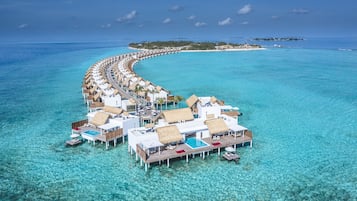
Emerald Maldives Resort & Spa - All Inclusive

- Villa Nautica Paradise Island Resort

Velassaru Maldives

- Furaveri Maldives

Mövenpick Resort Kuredhivaru Maldives
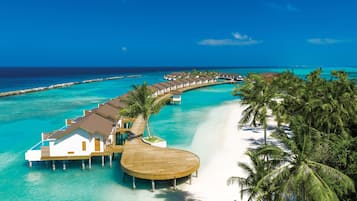
ATMOSPHERE KANIFUSHI - All Inclusive with Free Transfers
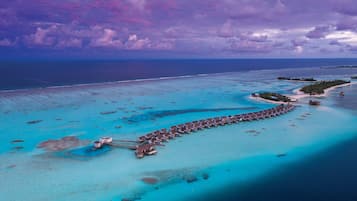
OZEN LIFE MAADHOO - All Inclusive

Cora Cora Maldives-Premium All-Inclusive

The Standard, Huruvalhi Maldives
Maldives all-inclusive resorts information, tips for finding incredible all-inclusive hotels in the maldives, compare what's included to find an incredible all-inclusive in the maldives .
When searching for some of the best Maldives all-inclusive resorts to meet your needs, make sure to carefully compare what's included in each resort's offering. Look for amenities like meals, drinks, water sports, spa treatments, and off-site excursions. Some all-inclusive Maldives resorts offer more comprehensive packages than others, so be sure to choose one that not only meets your budget, but also your personal travel style.
Think about the location of all-inclusive resorts in the Maldives
The Maldives is not a single island, but a sprawling archipelago comprised of numerous islands, each with its own attractions and character. When choosing which Maldives all-inclusive resort you want to stay at, think about whether you prefer a secluded private island experience where you can enjoy your honeymoon, like Kudadoo Maldives , or if you'd rather be somewhere where you can immerse yourself in local Maldivian culture. Resorts near Velana International Airport, like the wonderful Kurumba Maldives , are certainly convenient, but places on more remote islands like the memorable RIU Atoll All-inclusive on Kedhigandu offer even more tranquility and stunning natural beauty.
Look for last-minute all-inclusive hotels in the Maldives
While you search for some of the best Maldives all-inclusive resorts on Expedia to match your needs, remember that prices can change. If you're looking for a last-minute travel deal , Expedia often features discounted rates for some properties. If your travel dates are flexible, you just might snag a great deal on a luxurious Maldives overwater bungalow like the exceptional Constance Moofushi All Inclusive or The Westin Maldives Miriandhoo Resort .
Use Expedia filters to find the right hotel for you
When searching on Expedia for all-inclusive Maldives resorts, it's important to filter your results to make sure you can make fair comparisons between properties. By using search filters, you can sort for properties by their average guest rating and further narrow them down to those with pools, like the adults-only You & Me Maldives , or identify the ones with an ocean view such as the excellent Sheraton Maldives Full Moon Resort & Spa . This helps you find a great match based on your specific requirements.
Book with confidence with Expedia
Expedia makes it easy to book your dream vacation at an all-inclusive Maldives resort. If you choose a fully refundable stay you can book with confidence, knowing that you have flexibility if your plans change. Finding fully refundable resorts is a breeze: Look for the “fully refundable” label on the hotel listing. Not all packages may be eligible for a full refund, so read the conditions carefully when booking.
Recent reviews of Maldives hotels Expedia verified reviews

LUX* South Ari Atoll

Riu Palace Maldives - All inclusive

- H78 Maldives

- Sheraton Maldives Full Moon Resort & Spa

- Summer Beach Maldives

JEN Maldives Male by Shangri-La

Marukab Plaza

- Hard Rock Hotel Maldives

- Bandos Maldives
- Explore a world of travel with Expedia
Top destinations for All-inclusive Resorts in Maldives
- All-inclusive Resorts in Kaafu Atoll
- All-inclusive Resorts in South Ari Atoll
- All-inclusive Resorts in Baa Atoll
- All-inclusive Resorts in North Ari Atoll
- All-inclusive Resorts in Raa Atoll
- All-inclusive Resorts in Lhaviyani Atoll
- All-inclusive Resorts in South Nilandhe Atoll
- All-inclusive Resorts in Mulaku Atoll
- All-inclusive Resorts in Haa Dhaalu Atoll
- All-inclusive Resorts in Gaafu Dhaalu Atoll
- All-inclusive Resorts in Haa Alifu Atoll
More Hotel Options in Maldives
- Hotels with Restaurants (414)
- Hotels with Air Conditioning (405)
- Hotels with Free Wifi (382)
- Hotels & Resorts for Couples (381)
- Beach Hotels (373)
- Hotels with Laundry Facilities (372)
- Hotels with Room Service (354)
- Family Hotels (328)
- Hotels with Free Breakfast (278)
- Hotel with a Concierge (213)
- Hotels with Childcare (201)
- Resorts & Hotels with Spas (178)
- Hotels with Bars (161)
- Hotels with a Gym (150)
- Fishing Resorts & Hotels (139)
- Romantic Hotels (135)
- Business Hotels (132)
- Honeymoon Resorts & Hotels (130)
- Hotels with a Pool (129)
- Hotel Wedding Venues (121)
More Themes
- Hotels with Air Conditioning
- Hotels with Balconies
- Hotels with Bars
- Beach Hotels
- Boutique Hotels
- Cheap Hotels
- Business Hotels
- Hotels with Childcare
- Hotel with a Concierge
- Hotels with Connecting Rooms
- Hotels with Restaurants
- Family Hotels
- Hotels with Fireplaces
- Fishing Resorts & Hotels
- Hotels with a Gym
- Hotels with Free Airport Shuttle
- Hotels with Free Breakfast
- Hotels with Free Parking
- Hotels with Free Wifi
- Golf Hotels
- Historic Hotels
- Hotels with Hot Tubs
- Hotels with an Indoor Pool
- Rainforest & Jungle Hotels
- Extended Stay Hotels
- Hotels with Kitchenettes
- Hotels on the Lake
- Hotels with Laundry Facilities
- Hotels with a Lazy River
- Gay friendly Hotels
- Luxury Hotels
- Honeymoon Resorts & Hotels
- Non-Smoking Hotels
- Oceanfront Hotels
- Hotels with an Outdoor Pool
- Pet-friendly Hotels
- Hotels with a Pool
- Hotels & Resorts for Couples
- Hotels on the River
- Romantic Hotels
- Hotels with Room Service
- Quiet Resorts & Hotels
- Hotels with smoking rooms
- Resorts & Hotels with Spas
- Hotels with Suites
- Green Hotels
- Hotels with a Swim-up Bar
- Hotels with Tennis Courts
- Hotels with a View
- Waterpark Hotels
- Hotels with Waterslides
- Hotel Wedding Venues
- Winery Hotels
Other Accommodation Types in Maldives
- Guest Houses in Maldives (439)
- Resorts in Maldives (121)
- Vacation Homes in Maldives (38)
- B&B in Maldives (27)
- Apartments in Maldives (21)
- Villas in Maldives (21)
- Houseboats in Maldives (4)
- Aparthotels in Maldives (3)
- Inns in Maldives (3)
- Capsule Hotels in Maldives (1)
Stay near popular Maldives attractions
- Hotels near Paradise Island Beach
- Hotels near Maldives Islamic Centre
- Hotels near Hanifaru Bay
- Hotels near Gili Lankanfushi Beach
- Hotels near Hulhumale Beach
- Hotels near Vadoo Beach
- Hotels near Velaa Private Island
- Hotels near Hulhumale Ferry Terminal
- Hotels near Alimathaa
- Hotels near Full Moon Beach
Discover hotels close to Maldives with room rates, reviews, and availability. Most hotels are fully refundable.
- Samann Grand
- Sun Siyam Olhuveli
- Kaani Palm Beach
Expedia's Latest Trends

IMAGES
VIDEO
COMMENTS
You can also take a domestic flight to another atoll in the Maldives and a speedboat to the resort. 3. Island-hopping is doable (and encouraged) Many travelers spend weeks poring over which private island resort is the best for them, but you don't have to choose one. Beach bums can split their time between resorts.
Planning Your Trip. Best Time To Visit: In true tropical island style, temperatures in the Maldives average 83 degrees Fahrenheit (28 degrees Celsius) year-round, and there are only two main seasons; dry and wet. The dry season comes in fall and winter, from November through April, with temperatures ranging from 77 degrees Fahrenheit (25 ...
An island resort in the Maldives Diamonds Thudufushi Beach & Water Villas, a luxury resort on Thudufushi, Ari Atoll in May 2017 Tourism Zone. Tourism is the largest economic industry in the Maldives, as it plays an important role in earning foreign exchange revenues and employing 25,000 people in the tertiary sector of the country. The archipelago of the Maldives is the main source of ...
Imagine an entire country with an average ground level of just 5 feet (1.5 meters) above sea level. That's the Maldives, the flattest and lowest nation, making it uniquely vulnerable to the impacts of climate change. Rising sea levels threaten to submerge these beautiful islands, putting their existence at risk.
Adrenaline-Pumping Bucket-list Experiences in the Sunny Side of Life. 30 May 2024. If you are searching for the perfect thrilling adventures to add to your bucket-list, then you have come to the right place. Renowned for pristine beaches, crystal-clear waters, and luxurious resor...
The Maldives (Dhivehi: ދިވެހިރާއްޖެ Dhivehi Raajje) are an archipelago in the Indian Ocean with picture-perfect beaches, strikingly blue water, and luxury resorts. There are 200 inhabited islands and 154 islands with tourist resorts. Just under the surface of the beautiful blue ocean, there's a wealth of wildlife to see: over 2000 species of fish in all colours of the rainbow roam ...
The beautiful Maldives, consisting of many separate islands and atolls, is the lowest country in the world. Popular as a holiday destination the Maldives features history, natural wonders, and many exciting things to do. Read on to discover 20 facts about the Maldives. Geography and Weather. 1.
Asia. Unrivaled luxury, stunning white-sand beaches and a dazzling underwater world make Maldives an obvious choice for a true holiday of a lifetime. Best Time to Visit. Best Places to Visit. Attractions.
Maldives is Slowly Sinking. The 1,200 islands in Maldives are only nearly two metres above sea level on average, making the area more prone to rising sea levels, erosion and other environmental factors. As a result, the country is slowly sinking into the ocean. Thankfully, Maldives has strict environmental laws in place to minimise the impact.
The Maldives is a nation of islands in the Indian Ocean, that spans across the equator. The country is comprised of 1192 islands that stretch along a length of 871 kilometers. ... Travel Information All you need to know to plan your next visit to the Maldives Read More. Trip Planner Members Login Latest 360 Tours News Downloads. About About Us ...
1. Get a scuba certification. This is an obvious one. The topography of the Maldives' atolls means the water in which you'll learn is clear, calm and shallow. The nearest beach is always close by, meaning beginners can head right into the ocean for introductory sessions that would be done in a pool elsewhere.
Maldives, independent island country in the north-central Indian Ocean. It consists of about 1,200 low-lying small coral islands and sandbanks, only some 200 of which are inhabited, the most populous of which is Male. The country's largest industries include fishing, tourism, and shipping.
The Maldives is one of the most popular tropical vacation locations and has been recognised by the international tourism community as well. And to top that off, it is quite an interesting place to be, with its unique history, culture, and traditions.Here are some of the most interesting facts about Maldives-1.
The Maldives is the lowest-lying country in the world. With an average ground level of 1.5 meters (4 feet 11 inches) above sea level, the Maldives is vulnerable to the effects of climate change, including rising sea levels. Read also: 19 Fun and Fascinating Facts About Cameroon.
Maldives. With 26 atolls and 1,000+ islands spread out across the idyllic waters of the Indian Ocean, the Maldives are an island-hopper's dream. Below the water, there's miles of coral reef that are home to thousands of species of marine life and underwater treasures. To get the best of it: Go diving at Broken Rock, snorkel with manta rays ...
8- Visit Male, but don't forget to explore other islands. There are two kinds of tourists who visit the Maldives for the first time: 1. Those that arrive in the Maldives, go straight to their all-inclusive resort, and skip Male altogether. 2.
The 18 Facts about Maldives everybody should know. 18 Fun Facts about Maldives. Maldives Equatorial Sun Light. Maldives Sandbanks and Islands Shapes. Maldives Whale Sharks. Maldives Origins. Maldives has a World Record : the lowest country on the Planet. Maldivian Melting Pot.
Geography Facts about the Maldives. ~ The Maldives is an island nation famous for its white sandy beaches. It is the smallest country in Asia and spreads across the equator, making sun protection an absolute must if you plan on visiting. ~ The sea makes up more than 99.5% of the Maldives (90 000 sq km surface area).
Sun Island Resort & Spa - Maldives 3 Days Package. $653 per adult on twin sharing. Get Quotes >. 5 Days / 4 Nights. Holiday Inn Resort Kandooma All Inclusive - Maldives Honeymoon Package. $602 per adult on twin sharing. Get Quotes >. 5 Days / 4 Nights. Adaaran Club Rannalhi - Maldives Summer Getaway Package for 5 Days.
New York City. See Guide. National Geographic's latest travel stories about Maldives.
Here we propose some more utterly fascinating facts about Maldives that act as a catalyst in tourism. 24 Interesting Facts About Maldives Tourism 1. Maldives Sits on the Equator. This means that sun rays in Maldives get sprinkled at a 90-degree angle. In a nutshell, the sun rays are direct, and hence it is strong; guests must put on some ...
At the Ritz-Carlton Maldives, butler service comes as standard, and youngsters are kept occupied by the enormous video console-filled kids club.In 2025, a third resort, the Capella Maldives, will be added. 3. Crossroads. Best for the range of accommodation Crossroads is another multi-resort complex, and it was one of the first in the Maldives. It's also a destination in its own right - in ...
Weather. Year-round temperature hot tropical climate. The average high temperature is 31.5 degree Celsius and the average low temperature is 26.4 degree Celsius. The Southwest monsoon from May to October brings rain and the Northeast monsoon from November to April is generally sunny.
Airbnb also operates in the Maldives, as does the Couchsurfing community, with about 2,000 active hosts spread across the 1,192 islands. For the cheapest deal, travel experts advise booking from ...
If that slaps the brakes on your Maldives travel plans, don't panic - there are plenty of budget-friendly places to stay, too. Since 2009, the Maldivian government has allowed independent ...
Maldives Travel Guide Maldives Hotels Vacation Rentals in Maldives Maldives Flights Car Rentals in Maldives Maldives Vacations. All-inclusive Resorts in Maldives from $105. Check-in. Start date: Check-in selected. End date: Check-out Start date selected. Close the date picker or proceed to change the selected date.